La Señorita
Monday, November 30, 2009
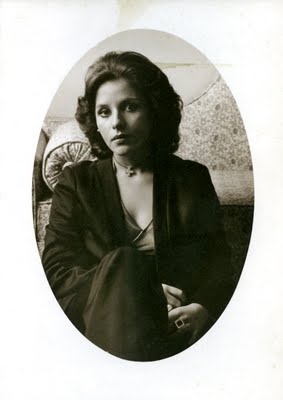
In 1974 my wife and I decided to sell our house, quit our jobs as teachers and move, with our two young daughters from Mexico City to Vancouver. It seemed like a perfect plan except that we had not counted on the problem of not having anybody buy our house. It was not a detached house and it was part of row of houses in the outskirts of Mexico City. Suddenly we had a house we could not sell and no money to pay the mortgage.
So I launched my career as a portrait photographer of the wealthy with an Asahi Pentax S-3, a 55mm (Auto-Takumar F-2) lens, a 28mm lens and an 85. I had a home darkroom and I mounted the photographs I took onto cardboard using mounting tissue and an iron. It was fashionable at the time to mount pictures on thick wood and paint edges black. I had no money for lights so I used Kodak Tri-X. My use of an oval brass frame to give my pictures and old look (accentuated with toning my pictures in smelly Kodak Sepia Toner) gave me lots of clients word of mouth from one to the next. I was doing so well that my neighbours suggested I give Mexico another chance. We did not. We finally sold the house and moved to Vancouver. Through the years when I try to compact my files (to borrow computerese language) I throw my negatives away. It was perhaps 10 years ago that I decided that all those Mexicans I had photographed in the posh districts of el Pedregal de San Angel and Las Lomas de Chapultepec had to go. I had some pangs of guilt but I threw the away anyway. I kept the little leather-bound portfolio I used to secure work and I have always been charmed by this señorita with the beautiful chest and the enigmatic face. I remember nothing about her, not even the circumstances that led me to photograph her, so well dressed, leaning against a sofa of a living room.
You can see the ravages of time on my print. Stains (sometimes called fixer staing) are appearing on the picture. I do hope that the pictures la señorita purchased are in better shape and that she is a happy woman who has learned to smile.
Of Bats & Cockroaches
Sunday, November 29, 2009
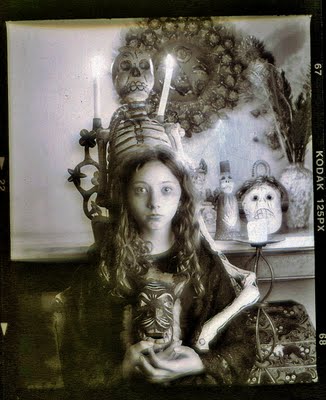
Informe Sobre Ciegos
¡Oh, dioses de la noche!
¡Oh, dioses de las tinieblas, del incesto y del crimen,
de la melancolía y del suicidio!
¡Oh, dioses de las ratas y de las cavernas,
de los murciélagos, de las cucarachas!
¡Oh, violentos, inescrutables dioses
del sueño y de la muerte!
¿Cuándo empezó esto que ahora va a terminar con mi asesinato?
Informe Sobre Ciegos, Sobre Héroes y Tumbas
Ernesto Sábato, 1961
---------------------------------------------------------------
Argentina is lucky in having more than one definitive Argentine novel. My favourite is Ernesto Sábato's Sobre Héroes y Tumbas , 1961 (On Heroes and Tombs, 1961) which I read in 1964. It left me shattered with its beauty and melancholy. By 1964 the section Informe Sobre Ciegos (Report on the Blind) was famous in all Argentina. This chapter of the novel almost stands alone because of its independence and starkness. It has something to do with a secret society that involves the blind beggars who sell stuff (in my day little ballenitas or plastic stiffeners for dress shirt collars) in Buenos Aires subways and trains. It is staged in a fantastic underworld that coexists with the "real and normal" world.
It was in 1965 when I first heard Astor Piazzolla live at the Teatro Florida and fell in love with Susy. I then bought every record of Piazzolla's that I could get my hands on. My favourite has always been Tango Contemporáneo - Astor Piazzolla y Su Nuevo Octeto. It was in this recording that I heard Ernesto Sábato himself read that first incredible paragraph from El Informe de los Ciegos. His voice is strangely pitched and eerily monotone. I replaced the virtually unplayable record with a CD just a few years ago. Even today is sounds avant-garde and fresh.
Report on the Blind
Oh gods of the night!
Oh gods of darkness, incest and crime
of melancholy and suicide!
Oh gods of of rats and caverns,
of bats and cockroaches!
Oh violent and inscrutable gods
of dreams and death!
When did this begin which will end with my assassination?
Introduction to Report on the Blind from Sobre Héroes y Tumbas, Ernesto Sábato (my translation)
You can listen to Ernesto Sábato read that if you wait (be patient!) until the end of this striking composition by Astor Piazzolla here.


Why is Rebecca's photograph here? The moody look of the picture with all the skulls and the candles simply brought to mind this book and also of one of the last books that Sábato may have written (he is alive and 98) Antes Del Fin (Before the End) which is an extremely depressing, but wonderful work of essays on death and the author's reminiscences on his life. The melancholy of the rainy and dark afternoon as I took Rebecca's picture also reminded me of late wintery afternoons in Buenos Aires with my friend Felipe Occhiuzzi. We would sit down on a bench at Parque Lezama and try to imagine two men, one with glasses the other a blind man with a cane, walking, slowly, arm in arm, chatting about novels and writing. The one with the glasses would have been Sábato and the blind man with the cane, Borges.
The Littlest Heathen
Saturday, November 28, 2009
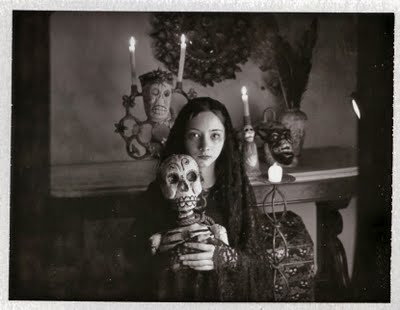
Today Lauren went to a Brownies camp out in Abbotsford so we only had Rebecca to spend the day with us. We had a Jewish lunch. I prepared coleslaw and made some pastrami sandwiches on rye with strong honey mustard. I served it with some pickles and we drank Doctor Pepper which is one of Rebecca’s faves.
I am trying to keep my shutter button finger from atrophying by taking pictures when I can. Rebecca is a great model but now always a willing one. She was reluctant but she posed for me in the end. She might have been attracted to my little candle altar in the dining room. I told her she was La Santa Muerte the patron saint of the Mexican drug mafia.
At age 12 Rebecca has some opinions on religion which are probably based on little knowledge and mostly hearsay at that. Of all the Polaroids (the Fuji version) I took (we used film after) she liked the one with my grandmother’s Mass vail over her head. “I look like a nun,” she told me. But then she gave me a mouthful. “I don’t see how anybody can worship death.” I tried to explain how Mexicans are more willing to accept its inevitability. But this was to no avail. I don’t understand this Virgin Mary thing. I simply don’t believe in God.
I am in an uncomfortably strange position of being an atheist who believes that atheism (for those who will come to believe in it) must come to one slowly. How can one be a 12-year-old atheist?
Santa Claus, the tooth fairy, goblins, the Three Wise Kings are childhood beliefs that I think are important. Children must have a fantastic and an imaginary life to protect them and to serve them when in later life the reality of our existence becomes only too obvious. I think that parents who would stop children from having such fantasies would be in error.
I went through my own rite of passage and I made my first communion. I believed in something and that belief at the very least has made me appreciate sacred music, sacred art, the soaring Gothic cathedrals and trying to figure out the Holy Trinity and transubstantiation has been, in itself a rite of passage for many including St. Augustine.
The story as St. Augustine told it began with him at the beach trying to understand how three distinct persons (God the Father, God the Son and the Holy Ghost) could all have one nature (God) while being three distinct persons. He spotted a little boy who was scooping water from the sea with a shell and emptying it into a hole in the sand. The little boy kept doing this and this made Augustine curious. “Little boy what are you doing?” “Sir, I am emptying the sea into the hole.” “Why that’s impossible!” “Sir it is far easier than to try to understand what you are trying to understand.” And the little boy then suddenly vanished.
Special effects in modern films have eliminated the question mark on most impossibility. We now live in a purely logical world where we make friends with people we will never meet and essences have been blurred. A telephone is now a book. It is a book that can help me find the closest Pizza Hut and tell me where I’m at in perfect latitude and longitude.
That the Virgin Mary went up to heaven in body and soul (and if you don’t believe this and you are a Catholic you are in heresy, believe it or not!) is a mystery that is illogical and because of it is beautiful and necessary if only until you might not believe it anymore. That Isaac almost sacrificed his son in his blind obedience to God also has something to instruct us that is illogical in its logic.
Rebecca told me that at age 8 or 9 she began to have her doubts about that fat man being able to deliver all those presents in one night. It is tragic but inevitable when a child stops being a child. But it is also important to try to understand that the willingness of those Christian martyrs to face hungry lions has some merit even if it does not fit the logic of our 21st century. If I were to tell Rebecca the story of those martyrs she would probably tell me that they were silly.

It was not all a loss today. I placed 21 sheets of blank paper on the living room floor and instructed Rebecca to start with the first where she was to write 1 to 100 (I erred here as it should have been 1 to 99), and then 100 to 200 and so on. When she finished she wrote the names of those centuries (she had figured it out by then). I then told her that if we were to continue back in time to our African ancestors the line would extend perhaps as far as Oakridge Mall. She then wrote events, deaths and births on each paper. I was pleasantly surprised that she correctly put the crusades in the right century and knew all about Henry the 8th.
St. Augustine famously had prayed to God: da mihi castitatem et continentiam, sed noli mod (Grant me chastity and continence, but not yet.) I would pray (hope) that Rebecca believe in something and not be the little atheist, at least not yet.
Confirmation
Goya's Ghost
Transubstantiation
Tittymouse & A Perception Of Distances
Friday, November 27, 2009
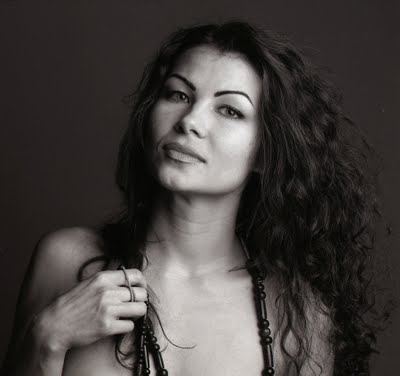
In my last few posts I have been a bit of a ranter and writer of stuff that is much too heavy to counter the dark and rainy days of November. Today it is sunny outside and I can see the bright gold leaves of my gingko on the lawn (they all fell in one day during a windstorm a couple of weeks ago). I could almost assert that I feel a tad uplifted. So I have found another excuse to be able to include, here, pictures of two very beautiful women. At age 67 I keep wondering if my obsession (mania?) to photograph undraped women is finally over. Is this sort of obsession an obsession that one outgrows? Have I seen it all? Or must I keep at it to satisfy what seems to be, now, a faint but unceasing little voice in my head that nags me that it is never over until it’s over?
In my years in Mexico City and Vancouver I have purchased many art books and photography books. Many are about the nude. My granddaughter Rebecca likes to sit in the living room to look at them. One of her favourites is the great big book with large photos taken of the Hollywood stars of the 30s, 40, and 50s by George Hurrell. In particular she likes his portraits of Johnny Weissmuller as Tarzan. It was the picture that made me take her by the hand, (while her interest was high) and drive to Videomatica one Saturday afternoon. We rented Tarzan The Ape Man (1932) with Weissmuller and Maureen O’Sullivan. We had an enjoyable afternoon. Now Lauren (like her sister did some few years ago) hangs from the stair banisters like an ape. We will have to teach her the Tarzan chest stomping yell.
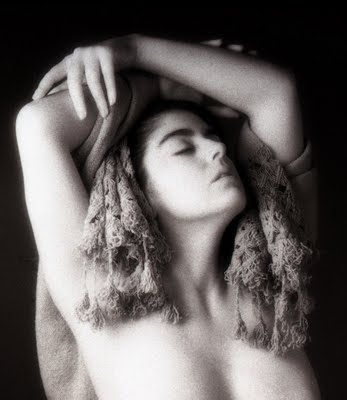
I will not deny that Rebecca also looks at the “other” books comfortably reclined on the psychiatric couch of our living room. She had asked me last week if I had used any of the pictures in the nude books as inspiration. I answered, “Yes,” and then she made a startling statement, “Papi your pictures, the ones in your hard drive, are a lot tamer than the ones in the books.
I feel that Rebecca has seen enough paintings and photographs in museums and books to make up her mind what she likes and what she doesn’t. At age 12 I did not have the library that she has now at her disposal or the image banks of the internet. I think that Rebecca has intelligence and good taste to look for what is good.
All the above makes me think of a book, The Naked and the Veiled - The Photographic Nudes of Erwin Blumenfeld (note his picture below) (1999 Thames & Hudson Ltd, London) which has a most interesting introduction by his son, Yorick Blumenfeld was, 1999, a correspondent and features editor for Newsweek.

Yorick Blumfeld’s introduction is the best and most persuasive apology I have ever read about the merits and benefits of the study and exectution of nudes in painting, sculpture and photography.
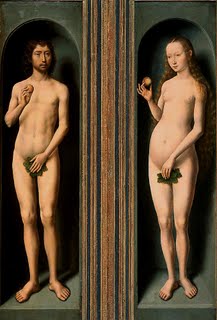
In particular he cites his father as a little boy and his relationship with his nanny Tittymouse. There is an illustration, a reproduction of Hans Memling’s Eve, From Adam and Eve, 1479 that reads:
------------------------------------------------------------------------------------
Memling’s classic ‘gothic’ elongations appealed to Blumenfeld’s sense of the erotic. He [1897-1969] was introduced to Cranach, Memling and the Flemish school of painters when he first visited the Berlin museums with his nanny around 1906.
------------------------------------------------------------------------------------
It seems that I may be my Rebecca’s art nanny so I don’t feel at all uncomfortable at the fact that she pours over my art books. Of Blumenfeld’s nanny this is what Yorick Blumenfeld writes:
------------------------------------------------------------------------------------
Before he ventured out into the world he took his heterosexual apprentiship in the nursery. His beloved nanny, ‘Tittymouse’ was the daughter of a talcum-powder manufacturer. ‘And she smelt of it,’ Blumenfeld wrote. ‘She had tiny pock-marks which I tried to kiss away. In return she taught me the butterfly kiss…’ Secretly in an era when it was considered risqué for a ‘lady’ to show her ankles, he already longed to see naked women.
He claimed that that his enduring obsession with transparency and veils was born, when at the age of nine, he was taken by his governess to visit the studio of a Berlin painter. The model, surprised by their entrance, quickly threw a diaphanous cloth over herself. But the outline of her body was still visible against the light. Later in his teenage years, the thin suggestive veils employed by such admired painters as Memling, Cranach and Botticelli made Blumenfeld realize that naked women could become ‘even more naked by their transparent veils.
-------------------------------------------------------------------------------------
And more to the point of what you cannot see in my photographs here (breasts) Yorick Blumenfeld quotes his father:
-------------------------------------------------------------------------------------
In all the widely ranging variations on the theme of the nude shown in this book, the youthful female breast plays a dominant role. I don’t think my father had anything like a breast fixation, but breasts were obviously a source of titillation deeply rooted in his psyche. The breast was something of a personal shrine to him and he eroticizes its form by focusing on the nipple. He always depicted the breast with great delicacy and something akin to reverence, striving to capture the elusiveness of perfect symmetry while trying to define photographically the ideal of the beautiful form. His photographs of breasts (unlike some of his collages and drawings) are never ironic, pornographic or even jokey. They are pure evocations of joy and celebrations of the feminine.

‘It cannot have been the influence of my nurse’s breasts alone which led to the development of this development of this addiction to golden sections. (“Our first perceptions of the distance between the nipples determines our sense of proportion for life”) he wrote in Eye to I. The highly evocative and and often voluptuous female forms shown here may therefore be interpreted in part as an effort to improve the gender. And there is no doubt that many are erotically linked to his early recollections, and to his dreams, as well as to the classical education he received in the Berlin ‘Gymnasium’in the golden era before the First World War.

-----------------------------------------------------
The two women in today’s blog were as beautiful as I ever saw. Anna, left, was curvaceous and her breasts would have instantly attracted Blumenfeld’s interest and camera. The other woman, Mae-Britt was the only person I ever met who was born in Greenland. Her father was Inuit and her mother was Danish. The combination of her voluptuousness and the blue-green-gray shade of her eyes, which resembled the colour of the Antarctic ice I had seen so many years ago drifting by in Ushuaia, could melt me one moment and freeze me the next.
A Splendid Lapse
Thursday, November 26, 2009
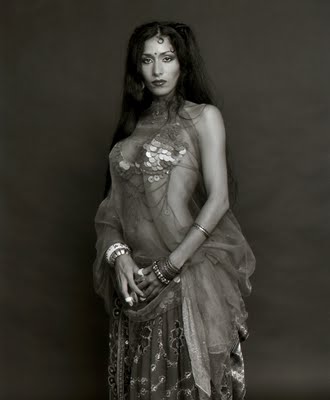
When I return from a trip from downtown Vancouver I generally take the Fir Street exit off the Granville Street Bridge. I like to look at the Filipino bakery and eatery, Goldilocks which is at the corner on Broadway. I sometimes stop to buy enzaimadas, polvorones or I splurge on a scoop of Magnolia brand macapunu ice-cream which is the most heavenly coconut flavour imaginable. But I also remember the location for another reason.
It was sometime in the middle 80s that I received an extraordinary phone call in the middle of the night from one of the most sensually beautiful women I ever photographed, Sarita the belly dancer. She said something like this, “Alex I am proposing that you take a full session at est. I will foot the bill. Est will remove your sense of guilt in leaving your wife. You will then escape with me and my daughter and we will live happily ever after in Hawaii.” As you can imagine while I was most flattered by such an invitation I turned Sarita down.” EST which stands for Erhard Seminars Training was an organization founded by Werner H. Erhard and it offered a two-weekend (60-hour) course known officially as ‘The est Standard Training'. The purpose of est was to allow participants to achieve, in a very brief time, a sense of personal transformation and enhanced power. I personally thought it was pretentious bunk.
And by now you might suspect that the yellow and blue Goldilocks building was once painted white to look like a Hopi Pueblo dwelling and it was the headquarters for est in Vancouver.
Just like birds have an innate sense of direction I think that many of us have that same sense even when the landmark beacons of the places we might have frequented are long gone. It’s almost as if the ghosts of old buildings pass through the thick concrete walls of modern condominium developments. When I drive down Richards on my way to the Granville Street Bridge I glance at the Blenz on Davie and Richards and I can pinpoint on the second floor where Mac Parry had his office in the old building that housed Vancouver Magazine upstairs and Western Living downstairs. I remember fondly how Mac would drop heavy books, on purpose, on the floor of his office. His former art director, Chris Dahl was now art directing Western Living downstairs “Alex,” he would say to me, “I like to do this because he works for that terrible magazine that features bathrooms and housed devoid of people.” He did not yet know that a few months later he would pack his books and move downstairs to edit the very magazine he disliked.
I remember even the older Vancouver Magazine office on Howe that overlooked what is now Robson Square. I remember seeing photographer James La Bounty taking pictures of an elegantly dressed Arthur Erickson ( wearing an immaculate London Fog) while standing in Mac Parry’s balcony. What was behind Erickson would be the Law Courts. The skating rink that Erickson designed is now the GE Ice Rink. The names of the people who built Vancouver are being erased and replaced by nameless memorial names.
Driving, walking or especially when taking the bus I sense these ghosts of buildings that once were. There are so many and they have been replaced by grim, lifeless towers which are paeans to urban density, affordable housing, sustainability, greenness and all those other euphemisms that we now use to replace the verb – filling the pockets of developers with mounds of cash. This is the price we must pay for a booming economy based on people wanting to come to live in our city who are less inclined to walk the seawall, visit our parks but more likely to whisk themselves into an underground parking garage, go up to their condo, turn on their espresso machine and sit down to a surround-sound experience from the flat-screen TV over their gas (much greener and much more sustainable) fireplace.
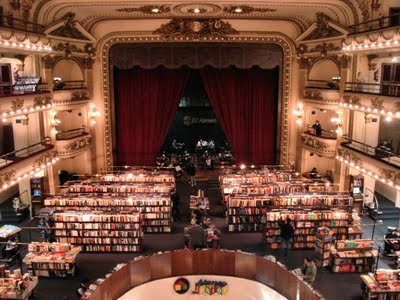
It was five years ago that my granddaughter Rebecca, my wife Rosemary and I entered one of the most beautiful bookstores in the world in Buenos Aires. El Ateneo Grand Splendid on the most fashionable and elegant Avenida Santa Fe was designed by architects Peró and Torres Armengol for the empresario Max Glücksman and as a theatre named Teatro Gran Splendid in May 1919. In the late twenties it became a cinema and in 2000 it was converted into a bookshop.
My father and mother had taken me to many films in the late 40s and early 50s to that grand cinema house. Here I now was with my granddaughter and wife so many years later feasting y eyes on people sitting in the higher boxes reading at leisure. We sat down on the stage (a café) and sipped cafes con leche while a pianist played some Piazzolla on a Steinway Grand.

A prominent Vancouver journalist (not born here) told me today, when I questioned him on the sorry day of the Vancouver Parks Board voting to close down the extraordinary Bloedel Conservatory, "We live amongst barbarians."
I would agree in that we should not have to think up of relevant or logical arguments to defend the keeping of the Conservatory. Sustainability in our city is seen purely as sustainability of the corpus and an abandoning of our soul. I don’t exactly want to how our city celebrated the opening of the refurbished Queen Elizabeth Theatre. It wasn't an event that could have been that memorable. I read it in the paper and I forgot immediately. Indeed we do live amongst a legion of barbarians that do not have a sense of what this city was and still is hidden underneath all that concrete. My journalist friend explained that nobody would be interested in the preservation of exotic plants and the roof overhead as long as the occupants of the towers could keep their guilt (if any) at bay by watering their balcony mini roses.
I wonder how much money the city will grant and shower on Montreal artist Rafael Lozano-Hemmer so that he can dazzle all those Olympic visitors with his spotlight project at English Bay. Consider, to that the man specializes in creating "temporary anti-monuments for alien agency." (Ken Lum, you have a lot to learn still if you are going to help us achieve a "world class" city with your outdoor sculptures.) I would much rather have seen the investment of the money to buy and line the bases of the parrots and cockatoos at the Bloedel Conservatory with pristine copies of the Vancouver Sun.
Perhaps I might save up money to visit by city of birth, Buenos Aires, where people still have a desire to live amongst the still-in-place memories of those who came before them. That would be just Splendid.
Addendum:
The above sounds a lot like a rant. I think it is. I have been steadfast in my commitment to not rant in this blog. I hope I will be forgiven for my temporary lapse.
The Bloedel Conservatory - A Botanical Tower of Babel
Wednesday, November 25, 2009
Many of you may be aware that the Bloedel Conservatory in Queen Elizabeth Park has been hoisted onto the chopping block due to more funding cuts on the behalf of our government. The Bloedel Conservatory is a true relic and has been a part of the Vancouver cityscape for 40 years! It is the unique geodesic dome home to a collection of more than 500 plant species, a pond filled with koi fish, and about 100tropical birds of various species. It's downfall in business in recent years has been largely due to the Canada Line construction on Cambie street and closures to parking lots around the park due to renovations to the reservoir below which put a big damper on the number of tour buses that could reach the facility. But as of 2008 the Conservatory's numbers have been on the rise, causing many of us to think the City board should look elsewhere to make it's cuts.
The CONSERVE THE BLOEDEL CONSERVATORY Petition to Vancouver Parks Board was created by and written by Nadiya Chettiar.

I received the above letter today via my friend and artist, Alan Storey. I often question the effectiveness of this computer-button advocacy. We can feel that we are contributing to the health and welfare of the environment by the mere pressing of that Send button. We can stay in the comfort of our home, drink our coffee and feel that we are helping. But, who knows, maybe this time it will have positive results.
I love the Bloedel Conservatory as does my wife Rosemary and my granddaughters Rebecca and Lauren. We go there at least three times a year. It is about now (and in those bleak gray days of January) when the Conservatory’s birds with their brilliant plumage beckon to make our life seem less bleak. I love to see my granddaughters talk and smile at Charlie the cockatoo.
But it is that blue Mexican agave that transports me to the Mexico I lived (and loved) for so many years. Its colour reminds me of driving by the Tequila district near Guadalajara that has miles and miles of the startling and stately blue agaves. I can smell that hot humid earth when I am at the Conservatory staring at the agave (I am beginning to call it my agave).
The problem of the Conservatory and the decision by the Vancouver Parks Board to shut it down to save money for me has its origins in a misguided (again my personal opinion) attempt by the botanical gardens of Vancouver to be independent of each other.
1. Nitobe Memorial Garden (located at the University of British Columbia)
2. UBC Botanical Garden and Centre for Plant Research (and a nearby rose garden by the Chan Centre).
3. VanDusen Botanical Garden
4. Dr. Sun Yat-Sen Garden (sometimes called the Dr. Sun Yat-Sen Classical Chinese Garden)
I regularly attend these four and one more, Darts Hill Garden (run by the Surrey Municipality) which was donated to Surrey by my friend the expert and passionate gardener, Francisca Darts. My wife and two granddaughters accompany me to these visits. In particular we like to go to the nearby VanDusen where my Rebecca and Lauren like to navigate the maze, watch the Koi, smell the roses and admire the fall colour, spring with the magnolias and enjoy the paradoxically bleak but lovely garden in the winter. We go to the plant sales at both VanDusen and at UBC.
You would think that these gardens would link to each other through their web pages and try to think up of joint projects that would attract more local patrons as opposed to the tourists who seem to know of their attractions.
But there are a couple of issues. One of them is the special status of UBC. It is not Vancouver when it is convenient for UBC. It is part of Vancouver when it is convenient. They have at UBC their own independent zoning laws. I know of at least one well known musical organization in Vancouver that had a problem getting city grants when the city found out that they were using UBC venues!
Consider that both the UBC Botanical Garden and Centre for Plant Research and the VanDusen Botanical Garden have a large army of unpaid volunteers. These unpaid volunteers (as an example at VanDusen) cannot pull weeds (even when they see one) because this would infringe on the duties of the paid parksboard employees who maintain the garden. This has been a smoldering issue for years. It is a shock to find out that the garden is not private (it seems to be) and that it is indeed run by the Vancouver Parks Board. Its ambivalent nature (Is it private? Is it public?) is similar to the ambivalent nature of the UBC Botanical Garden (is it in Vancouver? Is it not in Vancouver?)
Another issue that prevents linkage among these gardens is that the only truly botanical garden in Vancouver is the one that is not in Vancouver but out in UBC. Consider its name, UBC Botanical Garden and Centre for Plant Research. That implies that it communicates with other botanical gardens around the world. They exchange plants and seeds. They introduce new and highly desirable plants to us and to the world.

The other gardens in our city, including that Japanese on out at UBC are in reality display gardens. They are not strictly speaking, botanical gardens.
It is perhaps this difference that keeps the only real botanical garden, the one at UBC such a secret from the rest of our City. To me it is isolated. Yet its garden shop is a beauty with a massive garden book collection and its yearly plant sale is the only one that features plants for sale that you would never find anywhere else in the lower mainland. That botanical garden at UBC is a treasure waiting to be discovered by us the residents of this city.
It is my belief that the problem of the Conservatory would be resolved if all our gardens got together in a spirit of cooperation (as our politicians so often say without meaning).
One other place to begin would be to take our children to these gardens and make it part of their exisitence. When they grow up our gardens will not seem to be lofty places of academia but warm, beautiful and inviting refuges from the stresses of modern life.
UBC Botanical Garden
Nitobe Garden
Dr. Sun Yat-Sen Garden
VanDusen Botanical Garden
Darts Hill
Addendum: In her statement above Conservatory defender and enthusiast Nadiya Chettiar calls our Conservatory a "true relic". I know what she means. Perhaps in English we have lost the original meaning of relic( a most Catholic one) which used to be the word we used for the bones and other remains of saints. They were prized and kept in beautiful showcases or vaults in cathedrals and churches. It is a particular Vancouver flaw that we don't see the treasured relics of our city. They become invisible to us and we only realize their value when they are gone.
Tuesday, November 24, 2009
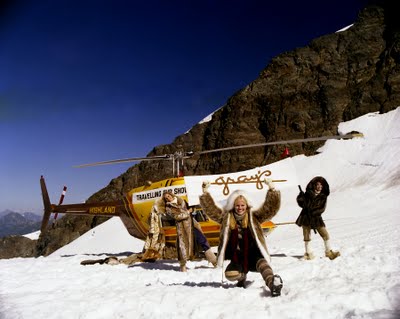
Robert Cameron, a self styled World’s Oldest One-Eyed Aerial Photographer died last Saturday. He was 98 and he might have been shooting stuff almost until the end. There are 59 6x9 foot photo murals illustrating environmentally healthy sites along the Pacific Rim at the Metreon Gallery in San Francisco right now. It was in San Francisco that Cameron in 1960 started a company that sold champagne-formula shampoo. He was a moderate drinker so he self-published a little book called The Drinking Man’s Diet in which he championed the idea that sipping a martini or Scotch on the rocks while eating something like a steak could take off weight because of the low carbohydrate count. He sold 2.4 million of these little books at $1.00. He made enough profit so that he could get started on his real love, helicopter photography. He published several (19) including Above San Francisco, Above London, Above Mexico City, Above New York (the best seller of them all), Above Los Angeles and Above Paris. I have his Above Paris which is written by no less than Pierre Salinger. His most famous picture, for me, (in his Above London) is one he took over centre court at Wimbledon. He was almost shot down because his helicopter was flying so low. You know that one of the little dots down there is Björn Borg. One of the other dots is Queen Elizabeth.
Cameron used a heavy Pentax 6x7 camera that was mounted on a gyroscope to offset the helicopter vibrations. He had special harnesses made so that he could hang precariously (but safely) outside the craft. His pictures are superb. It was in his later life that he developed a macular degeneration in his left eye and left him blind in that eye. But he kept shooting.
In his pre-Google Earth time his pictures are superb and his touch elegant.
Your friendly blogger here never had that elegant touch. I was always too busy swallowing Dramamines like candy and usually being quite out of it before the various helicopters and small planes I have flown in my past took me up to photograph mills or women wearing fur coats in the summer.
The first time I ever flew to take pictures was in Mexico City. I was hired to photograph a soft-drink bottling plant. I was scared to death but managed to take my pictures. I did not feel too good but felt lucky when a week later the pilot of the plane hit a cow in a pasture and killed himself.
Since I was a child I became dizzy in swings, cars, trams and just about anything that moved. It was only when I was in my 30s that I was finally able to control myself enough that I could fly with some equanimity.
I quickly found out what Cameron would have told me and that was that the finest aerial camera was and is the Pentax 6x7. It has a fast enough shutter speed (1/1000) to minimize most vibration and its lenses are very good. It has one flaw (for me). It is difficult to remove spent film as you have to look down a lot and grab the film just right. Looking down in a helicopter or airplane is murder for me. I never did get sick in any of those flights over lumber mills in BC or Alberta because I had really drugged myself with Gravol and Dramamine cocktails.
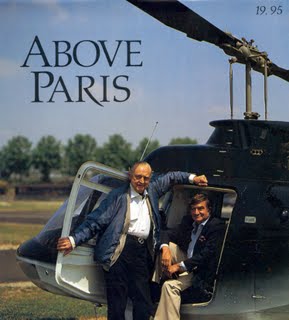
I took the picture above for a chain of Vancouver stores in the early 80s called Gray’s Apparel. They wanted to feature fir coats for their fall catalogue. The only place with snow in the middle of summer was near Agassiz. We flew in a helicopter to find a suitable glacier. I remember that my seat companion was a foppish young man called Klaus. He was very German and pleasantly gay. He was scared to death but probably not as scared as I was. I decided to make him more scared and perhaps in the process entertain myself and forget about my vertigo.
“Klaus,” I told him, “you must be aware that helicopters cannot glide. They are rocks with a rotors. If the rotors fail they plummet like rocks.” He looked at me and I could feel his panic!
The best thing about a helicopter shoot is when you are back on terra firma and you know that if you throw up you will not have to clean the field (or the cockpit).
In my years in Vancouver I have braved many flights in De Havilland Beavers. On those few moments when I am not worried about my stomach and my vertigo I will admit that flying in a Beaver is exhilirating and exciting. Taking pictures from them is a tad more difficult than in helicopters as the windows are usually clouded or yellow with age. Pilots have offered to open the door but I have in almost all cases (that I can remember) declined their generous offer. For more on Beavers:
Beavers
More Beavers
And more Beavers
“Monsignor,” he said, “there is one question I have often asked myself, a question that is perhaps likely to occur more frequently to a countryman than to a city dweller.” He hesitated like a swimmer on a cold brink. “Would you consider it heretical to pray to God for the life of a horse?”
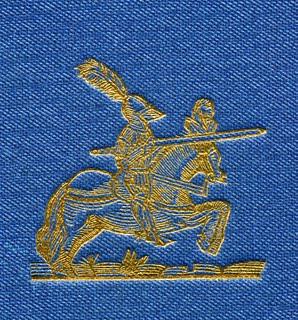
“For the terrestrial life,” the bishop answered without hesitation, “no – a prayer would be perfectly allowable. The fathers teach us that God created animals for man’s use, and a long life of service for a horse is as desirable in the eyes of God as a long life for my Mercedes, which I am afraid, looks like failing me. I must admit, however, that there is no record of miracles in the case of inanimate objects…"
“I was thinking less of the use of a horse to its master than for its happiness – and even for a good death.”
“I see no objection to praying for its happiness – it might well make it docile and of greater use to its owner – but I am not sure what you mean by a good death in the case of a horse. A good death for a man means a death in communion with God, a promise of eternity. We may pray for the terrestrial life of a horse, but not for its eternal life – that would surely be verging on heresy. It is true that there is a movement in the Church which would grant the possibility that a dog may have what one may call an embryo soul, though personally I find the idea sentimental and dangerous. We mustn’t open unnecessary doors by imprudent speculation. If a dog has a soul, why not a rhinoceros or a kangaroo?"
“Or a mosquito?”
“Exactly, I can see, father, that you are on the right side.”
“But I have never understood, monsignor, how a mosquito could have been created for man’s use. What use?”
“Surely, father, the use is obvious. A mosquito may be likened to a scourge in the hands of God, it teaches us to endure pain for love of Him. That painful buzz in the ear – perhaps it is God buzzing.”
Father Quixote had the unfortunate habit of a lonely man: he spoke his thoughts aloud. “The same use would apply to a flea." The bishop eyed him closely, but there was no sign of humor on Father Quixote’s gaze: it was obvious that he was plunged far in his own thoughts.
“These are great mysteries,” the bishop told him. “Where would our faith be if there were no mysteries?"
Monsignor Quixote, Graham Greene, 1982, Simon and Schuster, New York
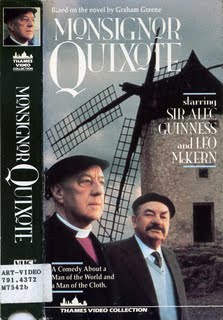
Of late I have stumbled into wonderful books (and films) thanks to my new policy of relinquishing my addiction to buying books and settling into enjoying the charms of the hidden/random (via raiding the shelves without a plan) stacks of the excellent Vancouver Public Library.
It was only yesterday that I was in search of a book for my Rosemary who is struggling with an intense computer course that involves Word, Quick Books, Excel and PowerPoint. I am unable to help her as my knowledge of Word is limited to writing on my monitor and availing myself of Word’s best feature, Word Count. My friend Paul Leisz put together a PowerPoint presentation (he was in dismay when I told him I didn’t want fades, music or any kind of special effects. I use that PowerPoint presentation, over and over and all I do is replace the old pictures with new ones. That is as far as I can go with PowerPoint.
The Renfrew Branch of the library had a copy of Word 2002 for Dummies. Off I went to get it. It was there that in the stacks I randomly found a made for British TV film I had seen back in 1987. It was from the series Great Performances and directed by Rodney Bennett. It was the adaptation of Graham Greene’s slim 1982 novel Monsignor Quixote. The film (what I remembered of it with a glow in my heart) has Alec Guinness playing the stoic small-town (El Toboso on the plains of La Mancha in Spain) parish priest and Leo McKern as his friend the recently ousted (with a sort of fair election) communist mayor. Ian Richardson plays (in a short but extremely satisfying performance) an Italian monsignor (with lots of clout we find out) from an obscure local in Africa who is saved by Quixote’s vague knowledge of car engine repair. The prelate is stuck in the middle of nowhere, a parched Manchegan plain, in his Mercedes when Father Quixote drives by in his ancient Seat (a Spanish Fiat which he affectionately calls Rocinante). The Bishop of Motopo enjoys Quixote’s hospitality especially his Manchegan wine and the steak (the bishop never catches on that it is a horse meat steak). Quixote’s hospitality is rewarded by a letter from his local bishop (one with whom Quixote cannot get along ) informing him that the Holy Father has promoted him to monsignor (via a recommendation from the Bishop of Motopo) and that he can now wear the purple bib and socks of that lofty ecclesiastical office.
I will not reveal anymore about this really good film that had me feeling entertained and happy but also depressed as I watched it alone last night while Rosemary struggled with the inhuman logic of Microsoft. But I must mention that the dialogue was so good that in one particular moment (see below) my head opened up to a rush of memories of my past that it reminded me of the intensity of the rains we have been getting of late. As soon as the film was over I took out my Monsignor Quixote and I was delighted that Graham Greene with the help of the credited writer Christopher Neame and the uncredited Miguel Cervantes somehow made that dialogue just about identical to the novel. Both of the passages here which I copied from the book are virtually the same to the film’s dialogue.
He [Sancho] stared gloomily into his glass of wine. “Oh, I laugh at your superstitions, father, but I shared some of them in those days [as a young student in Salamanca]. Is that why I seek your company now – to find my youth again, that youth when I half believed in your religion and everything was so complicated and contradictory – and interesting?”
Monsignor Quixote, Graham Greene, 1982, Simon and Schuster, New York.
The philosophical musings on the possible existence of a soul in a dog charmed me. But it was in the latter quote (when I heard it in the film) …everything was so complicated and contradictory – and interesting…that grabbed my attention and suddenly I could feel and miss the ghostly presence of the amputated limb that I had lost slowly, surely and inevitably all these years. It was my complicated, contradictory and interesting Catholic faith.
Thanks to my daily-mass-going grandmother and Brother Edwin Reggio, CSC, who taught me religion at St. Edward’s High School, I was able to practice in reality that tune that my father and I used to sing in bed, usually after we sang My Bonnie Lies Over the Ocean, (I didn't know then that my father’s rousing singing may have been alcohol induced):
Onwards Christian Soldiers.
Onward, Christian soldiers, marching as to war,
With the cross of Jesus going on before.
Christ, the royal Master, leads against the foe;
Forward into battle see His banners go!
Refrain
Onward, Christian soldiers, marching as to war,
With the cross of Jesus going on before.
Lyrics, Sabine Baring-Gould, music, Arthur S. Sullivan.
It was Brother Edwin who had taught me that one of the most important sacraments of the Catholic Church was the almost forgotten one (it used to happen between Baptism and First Communion) called Confirmation. This sacrament girded the recipient as a metaphorical soldier of Christ. Not as one that would climb up on a war horse and swing a broad sword at Moors in Spain but as one who would defend one’s faith by knowledge of it. The knowledge would help explain and perhaps even entice that curious nonbeliever to join. For years when people asked I could explain such comlicated stuff as transubstatiation, the Holy Trinity and the misunderstood concept (and doctrine) of Ex-cathedra. I felt happy in being able to explain and I never had the intention to convert anybody.
The first seeds of doubt began when my friend John Straney in our 11th grade at St. Ed's paraded his nonbelief in the existence of God in a most vocal manner. The Brothers of the Holy Cross in our Catholic school used General MacArthur tactics and simply moved around him and let him wither in isolation. They never made it an issue. I would have thought that they would have expelled him. Straney graduated just like the rest of us. I remember trying to reason with him and using the so-called proofs of the existence of God taught us by Brother Edwin. I tried Aristotle’s unmoved mover but Straney was not fazed by the human tendency to reject infinite infinities which can be so problematic to most of us. “Why does there have to be a beginning,” he would counter my arguments. “Why cannot time be a circle?” he would suggest.
In the late 60s and early 70s my mother had terrible vertigo Ménière's and she was no longer able to play her piano and she could no hear us most of the time because of the constant buzzing in her ears. The vertigo was terrible. I have suffered motion sickness most of my life and I can attest to her belief that pain was more bearable than vertigo.
My mother began to bitterly tell me she did not believe in a God that cared or a God that participated in human affairs. “I have lost my belief in the power of prayer. He does not listen. He is not interested.” Suddenly all my Catholic education did not help me in countering my mother’s journey into despair. This despair reminded me of Graham Greene's own Scobie in his Heart of the Matter. I was helpless until she died in the early 70s. It almost seemed that we had been living in that strange area that Graham Greene scholars often called Greeneland. It was an area populated by doubt about one's beliefs.
When theologians and others were arguing about the ultimate fate of Scobie in The Heart of the Matter, Graham Greene commented:
"I wrote a book about a man who goes to hell -- Brighton Rock -- another about a man who goes to heaven -- The Power and the Glory. Now I’ve simply written one about a man who goes to purgatory. I don’t see what all the fuss is about" (Time, October 29, 1951, p. 103).
The 1966 issue of Time, Is God Dead? had put those seeds of doubt in my head. In the 60s I read Time every week. It was my bible.
"Have I complete belief?" Sancho asked. "Sometimes I wonder. The ghost of my professor [Unamuno]haunts me. I dream I am sitting in his lecture room and he is reading to us from one of his own books. I hear him saying, 'There is a muffled voice, a voice of uncertainty which whispers in the ears of the believer. Who knows? Without this uncertainty how could we live?'"
Monsignor Quixote, Graham Greene, 1982, Simon and Schuster, New York.
A few months ago as Abraham Rogatnick was slipping away at VGH we discussed for hours our mutual shared belief in the nothingness that awaits. I read to Rogatnick Ambrose Bierce’s wonderful and poignant story of the man who does not fear death until it is suddenly confronts him, Parker Adderson Philosopher. We discussed Epicurus’ logical reasons for not fearing death.
Now as I look back at my evenings and days with Rogatnick I understand why Sancho’s comment on complexity and the Bishop of Motopo’s statement, that we need mysteries to have faith, is so important. That is what is missing in my life. The complexity and mystery of my willfully suppressed Catholic faith have not been replaced by any equivalents. I tell my students that even if you are not religious you must have some knowledge of religion (and in particular the Roman Catholic one) in order to tap into the stories of the saints, the mysteries, the accounts in the bible (both the Old and the New) to find inspiration for photography. After all it was the Catholic faith that gave us soaring cathedrals, soaring Bach cantatas and Masses, El Greco, Raphael and Leonardo.
Somehow the complexity of Ruby, Leopard, HTML and XML cannot replace the mystery and complexity of the faith that I once had. The former codes may be complicated but they don't have the challenge of an unsolvable and unresolvable unknown that will always be rooted in faith. Of what use is Twitter and Facebook and how do these social networks operate? The answer is much too complext for me and the question itself does not interest me. Have I underrated faith for so long?
My eldest daughter Ale (41) was the last member of our family to go to catechism and have a traditional First Communion. This happened around 1974 in Mexico City before we came to Vancouver. Because Ale has kept her connection with her Mexican friends she has a pretty good idea of some aspects of Catholicism that my youngest daughter Hilary (38) lacks. When my mother died in 1973 all semblance of a religious education for her granddaughters stopped.
My Argentine relatives like many Argentines are devout practicing Catholics. One of my nephews is a member of the Opus Dei. When Rosemary, Rebecca and I went to Buenos Aires in 2004 I made it a point to go to mass with my first cousin and godmother, Inesita O’Reilly. I thought it would please her. We brought Rebecca along who thought the Mass was most entertaining. She kept waving at the extremely handsome and young priest. We did our best (between us) to explain to her what she was seeing. For me there was the satisfying symmetricity of Rebecca being in a church to which I had attended many a time as a young boy. It was at La Redonda (so called as the church is a miniature version of Rome’s round Pantheon), that I had pushed my own idea of what was proper in my faith. I had arrived late (with all the intentions) when the Offertory began. According to my confessor if I arrived late at Sunday Mass but got to the Offertory that was considered a full Mass. I never told him that this was not an accidental lateness. As soon as the priest said itte Missa est (Latin for go, the Mass is ended in the traditional Tridentine Mass) I was out of there. Because of the Buenos Aires heat I would usually be outside the church’s doors looking into the Mass. I often wondered if going to Mass involved being physically in the church!
When we took Rebecca three times to Mexico (Guanajuato, Morelia and Mérida) we went to see lots of churches (the picture here is of Rebecca at the Jesuit church in Mérida). Rebecca wanted to know what saint was where and she wanted me to explain the paintings. Being a baptized Christian who was Confirmed I could give her the explanations. She is now able to explain each station of the cross as I have had to tell her the story every since I started taking her to the Pacific Baroque Concerts at St James Anglican. Rebecca knows that this Vancouver Anglican church is about as Catholic as it can be without being so.
Rebecca can believe (or not) in whatever she wants and that’s up to her busy parents to deal with. But when I am with her I can at least explain to her those mysteries, those complex mysteries that make life and an appreciation of the arts that much more challenging and fun.

I started something last Saturday. I threw a fork on to the kitchen floor. I watched Rebecca as she saw me do it. I asked her later how the fork had gotten there. She correctly told me I had dropped it. From there we went to discuss how any movement or change precludes a mover or changer. At the table I asked her in the presence of her mother, “Rebecca what comes to mind when you see a fork on the kitchen floor?” She answered, “It takes me to the concept of Aristotle's unmoved mover.” "And who or what is the unmoved mover?”
She answered, “God."
I do hope my life will get more complicated again.
Graham Greene On Sharks, Vultures and Palenque
Ad Majorem Dei Gloriam

During my stint in the Argentine Navy in the mid 60s I learned to manipulate my superiors. It was the only way that I could prevent my immediate superiors, the Argentine Marine Corps corporals and other petty officers from making my life hell. This technique had all to do with appearances. Captain USN Onofrio Salvia, who was the senior US Naval Advisor in Argentina, and my superior since I had been seconded by the Argentine Navy as his translator, had a chauffeured black Chevrolet Impala. The Impala would not have turned heads in the US. In Buenos Aires it did. There were very few American cars in Argentina in the 60s. I decided to play a game. Captain Salvia had instructed me to deliver a letter to the Argentine Admiralty. He told me, “I need this delivered immediately so ask Juan to take you in the car.” I looked for my beautiful and supple black Argentine leather gloves, I picked up my very nice Lopez Taibo black briefcase and put on my sunglasses. I told Juan to take me to the admiralty and that I was going to play a trick and sit in the back seat. When we arrived at the admiralty I asked Juan to open the door for me. When I left the car every posted guard saluted and came to attention. They all ignored that I was simply a lowly Argentine Navy conscript. My appearance had trumped it.
A few months after that funny incident, I was being harassed and given orders to go to refresher boot camp sessions. I hated them. In boot camp I had no protection from the understanding Captain Salvia who tried his best to bend the rules to keep me in his office. But even he had his limits and his pull only went so far. One of my methods for avoiding boot camp was plain and square insubordination masked as forgetfullness. This did not work and I spent many a day in the brig and still going to boot camp.
One afternoon as I nursed my sore muscles from the many push-ups I had been forced to execute I had an idea. I went to the Captain’s picture files and I removed a glossy 8x10 of Almirante Benigno Varela who was the Argentine Chief of Naval Operations. In my best handwriting I wrote in Spanish (to my good friend Conscripto Jorge Waterhouse-Hayward and signed with a flourish Almirante Benigno Varela, Comandante de Operaciones Navales, ARA. I slipped the picture under the glass of my desk. It was soon noticed.
As I expected the harassing stopped and I was treated with kid’s gloves by the corporals and petty officers. I had learned the importance of appearances.
It was my intention to write about elitism today. I began it with the chauffeur incident above and quickly realized its connection to elitism was tenuous. I will continue tomorrow.

Even now I remember that as kid I wanted to blend in and not be noticed. I was around 9 when I was invited to the birthday party of a girl I really liked at school. It was the American Grammar School in Buenos Aires and because my mother taught there I was able to attend without paying the very high tuition. The girl was Susan Stone and her father was the CEO of General Motors Argentina. I told my mother I needed to have a pair of blue jeans. She bought me a pair that was Argentine, neither a Levis nor the more desirable Lees. I was furious and ashamed, “I am not going to that party with these. They will know.” In the end I did go as my mother explained that she did not have enough money to buy them and besides my friends were mostly American and their parents got the jeans in the US.
Had I even had a pair of the real McCoys I never did blend in because I had a crooked smile. My friend made fun of my crooked smile. I decided I would never smile and when I posed for photographs I did my best not to smile. I could not make it straight.
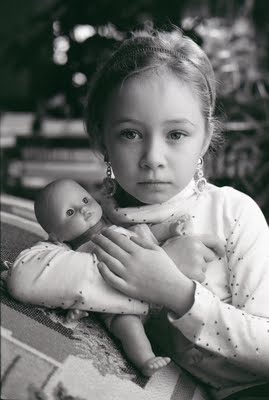
Perhaps this is the reason why I never really made my daughters smile for pictures and I continued with the idea when I started taking pictures of Rebecca. Rosemary got angry at me telling me that my pictures of an unsmiling 4-year-old were disturbing. I did not know how to counter her argument. Rebecca’s mother and family also kept asking me to take pictures of Rebecca smiling. It was about then that I figured our a relevant counter argument. I told Rosemary that I photographed Rebecca like a Victorian little girl. Victorians not only considered children to be adults they made them work long hours under terrible conditions without any consideration. I further explained that such 19th century English photographers as Julia Margaret Cameron and the Reverend Charles Lutwidge Dodgson always took portraits of children without ever making them smile. Rosemary finally gave up on me and they accepted my take on Rebecca.

Now here we have the 7-year-old Lauren who has an even more deadpan and serious expression than Rebecca. I am in my glory as I now can take pictures of another unsmiling child who will never be subjected to jeers for having a crooked smile.
Yesterday we went to Lauren’s first in-progress class performance at her ballet class at Arts Umbrella. I was delighted to find out that her instructor is the remarkable modern dancer Lina Fitzner who also taught Rebecca. After the performance we braved the rain and lightning and had some crepes at the Granville Island food court. Lauren chose to have chocolate crepes.
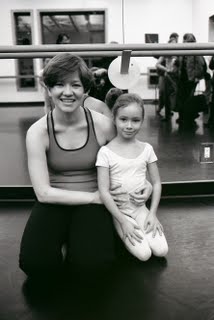
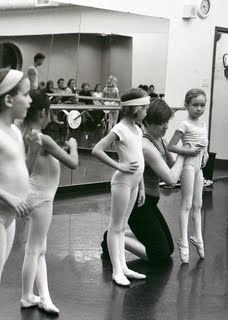
Today I continued with my “new” technique (a rediscovered one from my youth) of using Kodak Tri-X with a Nikon motor driven camera. Lauren wanted to show off her new earrings. She posed on the living room psychiatric couch with her doll Angela. I am as pleased with the pictures as Lauren is. But I am not going to smile about it. No.

Robert Cameron, a self styled World’s Oldest One-Eyed Aerial Photographer died last Saturday. He was 98 and he might have been shooting stuff almost until the end. There are 59 6x9 foot photo murals illustrating environmentally healthy sites along the Pacific Rim at the Metreon Gallery in San Francisco right now. It was in San Francisco that Cameron in 1960 started a company that sold champagne-formula shampoo. He was a moderate drinker so he self-published a little book called The Drinking Man’s Diet in which he championed the idea that sipping a martini or Scotch on the rocks while eating something like a steak could take off weight because of the low carbohydrate count. He sold 2.4 million of these little books at $1.00. He made enough profit so that he could get started on his real love, helicopter photography. He published several (19) including Above San Francisco, Above London, Above Mexico City, Above New York (the best seller of them all), Above Los Angeles and Above Paris. I have his Above Paris which is written by no less than Pierre Salinger. His most famous picture, for me, (in his Above London) is one he took over centre court at Wimbledon. He was almost shot down because his helicopter was flying so low. You know that one of the little dots down there is Björn Borg. One of the other dots is Queen Elizabeth.
Cameron used a heavy Pentax 6x7 camera that was mounted on a gyroscope to offset the helicopter vibrations. He had special harnesses made so that he could hang precariously (but safely) outside the craft. His pictures are superb. It was in his later life that he developed a macular degeneration in his left eye and left him blind in that eye. But he kept shooting.
In his pre-Google Earth time his pictures are superb and his touch elegant.
Your friendly blogger here never had that elegant touch. I was always too busy swallowing Dramamines like candy and usually being quite out of it before the various helicopters and small planes I have flown in my past took me up to photograph mills or women wearing fur coats in the summer.
The first time I ever flew to take pictures was in Mexico City. I was hired to photograph a soft-drink bottling plant. I was scared to death but managed to take my pictures. I did not feel too good but felt lucky when a week later the pilot of the plane hit a cow in a pasture and killed himself.
Since I was a child I became dizzy in swings, cars, trams and just about anything that moved. It was only when I was in my 30s that I was finally able to control myself enough that I could fly with some equanimity.
I quickly found out what Cameron would have told me and that was that the finest aerial camera was and is the Pentax 6x7. It has a fast enough shutter speed (1/1000) to minimize most vibration and its lenses are very good. It has one flaw (for me). It is difficult to remove spent film as you have to look down a lot and grab the film just right. Looking down in a helicopter or airplane is murder for me. I never did get sick in any of those flights over lumber mills in BC or Alberta because I had really drugged myself with Gravol and Dramamine cocktails.

I took the picture above for a chain of Vancouver stores in the early 80s called Gray’s Apparel. They wanted to feature fir coats for their fall catalogue. The only place with snow in the middle of summer was near Agassiz. We flew in a helicopter to find a suitable glacier. I remember that my seat companion was a foppish young man called Klaus. He was very German and pleasantly gay. He was scared to death but probably not as scared as I was. I decided to make him more scared and perhaps in the process entertain myself and forget about my vertigo.
“Klaus,” I told him, “you must be aware that helicopters cannot glide. They are rocks with a rotors. If the rotors fail they plummet like rocks.” He looked at me and I could feel his panic!
The best thing about a helicopter shoot is when you are back on terra firma and you know that if you throw up you will not have to clean the field (or the cockpit).
In my years in Vancouver I have braved many flights in De Havilland Beavers. On those few moments when I am not worried about my stomach and my vertigo I will admit that flying in a Beaver is exhilirating and exciting. Taking pictures from them is a tad more difficult than in helicopters as the windows are usually clouded or yellow with age. Pilots have offered to open the door but I have in almost all cases (that I can remember) declined their generous offer. For more on Beavers:
Beavers
More Beavers
And more Beavers
That Ingenious Hidalgo - Monsignor Quixote
Monday, November 23, 2009
“Monsignor,” he said, “there is one question I have often asked myself, a question that is perhaps likely to occur more frequently to a countryman than to a city dweller.” He hesitated like a swimmer on a cold brink. “Would you consider it heretical to pray to God for the life of a horse?”

“For the terrestrial life,” the bishop answered without hesitation, “no – a prayer would be perfectly allowable. The fathers teach us that God created animals for man’s use, and a long life of service for a horse is as desirable in the eyes of God as a long life for my Mercedes, which I am afraid, looks like failing me. I must admit, however, that there is no record of miracles in the case of inanimate objects…"
“I was thinking less of the use of a horse to its master than for its happiness – and even for a good death.”
“I see no objection to praying for its happiness – it might well make it docile and of greater use to its owner – but I am not sure what you mean by a good death in the case of a horse. A good death for a man means a death in communion with God, a promise of eternity. We may pray for the terrestrial life of a horse, but not for its eternal life – that would surely be verging on heresy. It is true that there is a movement in the Church which would grant the possibility that a dog may have what one may call an embryo soul, though personally I find the idea sentimental and dangerous. We mustn’t open unnecessary doors by imprudent speculation. If a dog has a soul, why not a rhinoceros or a kangaroo?"
“Or a mosquito?”
“Exactly, I can see, father, that you are on the right side.”
“But I have never understood, monsignor, how a mosquito could have been created for man’s use. What use?”
“Surely, father, the use is obvious. A mosquito may be likened to a scourge in the hands of God, it teaches us to endure pain for love of Him. That painful buzz in the ear – perhaps it is God buzzing.”
Father Quixote had the unfortunate habit of a lonely man: he spoke his thoughts aloud. “The same use would apply to a flea." The bishop eyed him closely, but there was no sign of humor on Father Quixote’s gaze: it was obvious that he was plunged far in his own thoughts.
“These are great mysteries,” the bishop told him. “Where would our faith be if there were no mysteries?"
Monsignor Quixote, Graham Greene, 1982, Simon and Schuster, New York

Of late I have stumbled into wonderful books (and films) thanks to my new policy of relinquishing my addiction to buying books and settling into enjoying the charms of the hidden/random (via raiding the shelves without a plan) stacks of the excellent Vancouver Public Library.
It was only yesterday that I was in search of a book for my Rosemary who is struggling with an intense computer course that involves Word, Quick Books, Excel and PowerPoint. I am unable to help her as my knowledge of Word is limited to writing on my monitor and availing myself of Word’s best feature, Word Count. My friend Paul Leisz put together a PowerPoint presentation (he was in dismay when I told him I didn’t want fades, music or any kind of special effects. I use that PowerPoint presentation, over and over and all I do is replace the old pictures with new ones. That is as far as I can go with PowerPoint.
The Renfrew Branch of the library had a copy of Word 2002 for Dummies. Off I went to get it. It was there that in the stacks I randomly found a made for British TV film I had seen back in 1987. It was from the series Great Performances and directed by Rodney Bennett. It was the adaptation of Graham Greene’s slim 1982 novel Monsignor Quixote. The film (what I remembered of it with a glow in my heart) has Alec Guinness playing the stoic small-town (El Toboso on the plains of La Mancha in Spain) parish priest and Leo McKern as his friend the recently ousted (with a sort of fair election) communist mayor. Ian Richardson plays (in a short but extremely satisfying performance) an Italian monsignor (with lots of clout we find out) from an obscure local in Africa who is saved by Quixote’s vague knowledge of car engine repair. The prelate is stuck in the middle of nowhere, a parched Manchegan plain, in his Mercedes when Father Quixote drives by in his ancient Seat (a Spanish Fiat which he affectionately calls Rocinante). The Bishop of Motopo enjoys Quixote’s hospitality especially his Manchegan wine and the steak (the bishop never catches on that it is a horse meat steak). Quixote’s hospitality is rewarded by a letter from his local bishop (one with whom Quixote cannot get along ) informing him that the Holy Father has promoted him to monsignor (via a recommendation from the Bishop of Motopo) and that he can now wear the purple bib and socks of that lofty ecclesiastical office.
I will not reveal anymore about this really good film that had me feeling entertained and happy but also depressed as I watched it alone last night while Rosemary struggled with the inhuman logic of Microsoft. But I must mention that the dialogue was so good that in one particular moment (see below) my head opened up to a rush of memories of my past that it reminded me of the intensity of the rains we have been getting of late. As soon as the film was over I took out my Monsignor Quixote and I was delighted that Graham Greene with the help of the credited writer Christopher Neame and the uncredited Miguel Cervantes somehow made that dialogue just about identical to the novel. Both of the passages here which I copied from the book are virtually the same to the film’s dialogue.
He [Sancho] stared gloomily into his glass of wine. “Oh, I laugh at your superstitions, father, but I shared some of them in those days [as a young student in Salamanca]. Is that why I seek your company now – to find my youth again, that youth when I half believed in your religion and everything was so complicated and contradictory – and interesting?”
Monsignor Quixote, Graham Greene, 1982, Simon and Schuster, New York.
The philosophical musings on the possible existence of a soul in a dog charmed me. But it was in the latter quote (when I heard it in the film) …everything was so complicated and contradictory – and interesting…that grabbed my attention and suddenly I could feel and miss the ghostly presence of the amputated limb that I had lost slowly, surely and inevitably all these years. It was my complicated, contradictory and interesting Catholic faith.
Thanks to my daily-mass-going grandmother and Brother Edwin Reggio, CSC, who taught me religion at St. Edward’s High School, I was able to practice in reality that tune that my father and I used to sing in bed, usually after we sang My Bonnie Lies Over the Ocean, (I didn't know then that my father’s rousing singing may have been alcohol induced):
Onwards Christian Soldiers.
Onward, Christian soldiers, marching as to war,
With the cross of Jesus going on before.
Christ, the royal Master, leads against the foe;
Forward into battle see His banners go!
Refrain
Onward, Christian soldiers, marching as to war,
With the cross of Jesus going on before.
Lyrics, Sabine Baring-Gould, music, Arthur S. Sullivan.
It was Brother Edwin who had taught me that one of the most important sacraments of the Catholic Church was the almost forgotten one (it used to happen between Baptism and First Communion) called Confirmation. This sacrament girded the recipient as a metaphorical soldier of Christ. Not as one that would climb up on a war horse and swing a broad sword at Moors in Spain but as one who would defend one’s faith by knowledge of it. The knowledge would help explain and perhaps even entice that curious nonbeliever to join. For years when people asked I could explain such comlicated stuff as transubstatiation, the Holy Trinity and the misunderstood concept (and doctrine) of Ex-cathedra. I felt happy in being able to explain and I never had the intention to convert anybody.
The first seeds of doubt began when my friend John Straney in our 11th grade at St. Ed's paraded his nonbelief in the existence of God in a most vocal manner. The Brothers of the Holy Cross in our Catholic school used General MacArthur tactics and simply moved around him and let him wither in isolation. They never made it an issue. I would have thought that they would have expelled him. Straney graduated just like the rest of us. I remember trying to reason with him and using the so-called proofs of the existence of God taught us by Brother Edwin. I tried Aristotle’s unmoved mover but Straney was not fazed by the human tendency to reject infinite infinities which can be so problematic to most of us. “Why does there have to be a beginning,” he would counter my arguments. “Why cannot time be a circle?” he would suggest.
In the late 60s and early 70s my mother had terrible vertigo Ménière's and she was no longer able to play her piano and she could no hear us most of the time because of the constant buzzing in her ears. The vertigo was terrible. I have suffered motion sickness most of my life and I can attest to her belief that pain was more bearable than vertigo.
My mother began to bitterly tell me she did not believe in a God that cared or a God that participated in human affairs. “I have lost my belief in the power of prayer. He does not listen. He is not interested.” Suddenly all my Catholic education did not help me in countering my mother’s journey into despair. This despair reminded me of Graham Greene's own Scobie in his Heart of the Matter. I was helpless until she died in the early 70s. It almost seemed that we had been living in that strange area that Graham Greene scholars often called Greeneland. It was an area populated by doubt about one's beliefs.
When theologians and others were arguing about the ultimate fate of Scobie in The Heart of the Matter, Graham Greene commented:
"I wrote a book about a man who goes to hell -- Brighton Rock -- another about a man who goes to heaven -- The Power and the Glory. Now I’ve simply written one about a man who goes to purgatory. I don’t see what all the fuss is about" (Time, October 29, 1951, p. 103).
The 1966 issue of Time, Is God Dead? had put those seeds of doubt in my head. In the 60s I read Time every week. It was my bible.
"Have I complete belief?" Sancho asked. "Sometimes I wonder. The ghost of my professor [Unamuno]haunts me. I dream I am sitting in his lecture room and he is reading to us from one of his own books. I hear him saying, 'There is a muffled voice, a voice of uncertainty which whispers in the ears of the believer. Who knows? Without this uncertainty how could we live?'"
Monsignor Quixote, Graham Greene, 1982, Simon and Schuster, New York.
A few months ago as Abraham Rogatnick was slipping away at VGH we discussed for hours our mutual shared belief in the nothingness that awaits. I read to Rogatnick Ambrose Bierce’s wonderful and poignant story of the man who does not fear death until it is suddenly confronts him, Parker Adderson Philosopher. We discussed Epicurus’ logical reasons for not fearing death.
Now as I look back at my evenings and days with Rogatnick I understand why Sancho’s comment on complexity and the Bishop of Motopo’s statement, that we need mysteries to have faith, is so important. That is what is missing in my life. The complexity and mystery of my willfully suppressed Catholic faith have not been replaced by any equivalents. I tell my students that even if you are not religious you must have some knowledge of religion (and in particular the Roman Catholic one) in order to tap into the stories of the saints, the mysteries, the accounts in the bible (both the Old and the New) to find inspiration for photography. After all it was the Catholic faith that gave us soaring cathedrals, soaring Bach cantatas and Masses, El Greco, Raphael and Leonardo.
Somehow the complexity of Ruby, Leopard, HTML and XML cannot replace the mystery and complexity of the faith that I once had. The former codes may be complicated but they don't have the challenge of an unsolvable and unresolvable unknown that will always be rooted in faith. Of what use is Twitter and Facebook and how do these social networks operate? The answer is much too complext for me and the question itself does not interest me. Have I underrated faith for so long?
My eldest daughter Ale (41) was the last member of our family to go to catechism and have a traditional First Communion. This happened around 1974 in Mexico City before we came to Vancouver. Because Ale has kept her connection with her Mexican friends she has a pretty good idea of some aspects of Catholicism that my youngest daughter Hilary (38) lacks. When my mother died in 1973 all semblance of a religious education for her granddaughters stopped.
My Argentine relatives like many Argentines are devout practicing Catholics. One of my nephews is a member of the Opus Dei. When Rosemary, Rebecca and I went to Buenos Aires in 2004 I made it a point to go to mass with my first cousin and godmother, Inesita O’Reilly. I thought it would please her. We brought Rebecca along who thought the Mass was most entertaining. She kept waving at the extremely handsome and young priest. We did our best (between us) to explain to her what she was seeing. For me there was the satisfying symmetricity of Rebecca being in a church to which I had attended many a time as a young boy. It was at La Redonda (so called as the church is a miniature version of Rome’s round Pantheon), that I had pushed my own idea of what was proper in my faith. I had arrived late (with all the intentions) when the Offertory began. According to my confessor if I arrived late at Sunday Mass but got to the Offertory that was considered a full Mass. I never told him that this was not an accidental lateness. As soon as the priest said itte Missa est (Latin for go, the Mass is ended in the traditional Tridentine Mass) I was out of there. Because of the Buenos Aires heat I would usually be outside the church’s doors looking into the Mass. I often wondered if going to Mass involved being physically in the church!
When we took Rebecca three times to Mexico (Guanajuato, Morelia and Mérida) we went to see lots of churches (the picture here is of Rebecca at the Jesuit church in Mérida). Rebecca wanted to know what saint was where and she wanted me to explain the paintings. Being a baptized Christian who was Confirmed I could give her the explanations. She is now able to explain each station of the cross as I have had to tell her the story every since I started taking her to the Pacific Baroque Concerts at St James Anglican. Rebecca knows that this Vancouver Anglican church is about as Catholic as it can be without being so.
Rebecca can believe (or not) in whatever she wants and that’s up to her busy parents to deal with. But when I am with her I can at least explain to her those mysteries, those complex mysteries that make life and an appreciation of the arts that much more challenging and fun.

I started something last Saturday. I threw a fork on to the kitchen floor. I watched Rebecca as she saw me do it. I asked her later how the fork had gotten there. She correctly told me I had dropped it. From there we went to discuss how any movement or change precludes a mover or changer. At the table I asked her in the presence of her mother, “Rebecca what comes to mind when you see a fork on the kitchen floor?” She answered, “It takes me to the concept of Aristotle's unmoved mover.” "And who or what is the unmoved mover?”
She answered, “God."
I do hope my life will get more complicated again.
Graham Greene On Sharks, Vultures and Palenque
Ad Majorem Dei Gloriam
Appearances
Sunday, November 22, 2009

During my stint in the Argentine Navy in the mid 60s I learned to manipulate my superiors. It was the only way that I could prevent my immediate superiors, the Argentine Marine Corps corporals and other petty officers from making my life hell. This technique had all to do with appearances. Captain USN Onofrio Salvia, who was the senior US Naval Advisor in Argentina, and my superior since I had been seconded by the Argentine Navy as his translator, had a chauffeured black Chevrolet Impala. The Impala would not have turned heads in the US. In Buenos Aires it did. There were very few American cars in Argentina in the 60s. I decided to play a game. Captain Salvia had instructed me to deliver a letter to the Argentine Admiralty. He told me, “I need this delivered immediately so ask Juan to take you in the car.” I looked for my beautiful and supple black Argentine leather gloves, I picked up my very nice Lopez Taibo black briefcase and put on my sunglasses. I told Juan to take me to the admiralty and that I was going to play a trick and sit in the back seat. When we arrived at the admiralty I asked Juan to open the door for me. When I left the car every posted guard saluted and came to attention. They all ignored that I was simply a lowly Argentine Navy conscript. My appearance had trumped it.
A few months after that funny incident, I was being harassed and given orders to go to refresher boot camp sessions. I hated them. In boot camp I had no protection from the understanding Captain Salvia who tried his best to bend the rules to keep me in his office. But even he had his limits and his pull only went so far. One of my methods for avoiding boot camp was plain and square insubordination masked as forgetfullness. This did not work and I spent many a day in the brig and still going to boot camp.
One afternoon as I nursed my sore muscles from the many push-ups I had been forced to execute I had an idea. I went to the Captain’s picture files and I removed a glossy 8x10 of Almirante Benigno Varela who was the Argentine Chief of Naval Operations. In my best handwriting I wrote in Spanish (to my good friend Conscripto Jorge Waterhouse-Hayward and signed with a flourish Almirante Benigno Varela, Comandante de Operaciones Navales, ARA. I slipped the picture under the glass of my desk. It was soon noticed.
As I expected the harassing stopped and I was treated with kid’s gloves by the corporals and petty officers. I had learned the importance of appearances.
It was my intention to write about elitism today. I began it with the chauffeur incident above and quickly realized its connection to elitism was tenuous. I will continue tomorrow.
We Would Rather Not Smile
Saturday, November 21, 2009

Even now I remember that as kid I wanted to blend in and not be noticed. I was around 9 when I was invited to the birthday party of a girl I really liked at school. It was the American Grammar School in Buenos Aires and because my mother taught there I was able to attend without paying the very high tuition. The girl was Susan Stone and her father was the CEO of General Motors Argentina. I told my mother I needed to have a pair of blue jeans. She bought me a pair that was Argentine, neither a Levis nor the more desirable Lees. I was furious and ashamed, “I am not going to that party with these. They will know.” In the end I did go as my mother explained that she did not have enough money to buy them and besides my friends were mostly American and their parents got the jeans in the US.
Had I even had a pair of the real McCoys I never did blend in because I had a crooked smile. My friend made fun of my crooked smile. I decided I would never smile and when I posed for photographs I did my best not to smile. I could not make it straight.

Perhaps this is the reason why I never really made my daughters smile for pictures and I continued with the idea when I started taking pictures of Rebecca. Rosemary got angry at me telling me that my pictures of an unsmiling 4-year-old were disturbing. I did not know how to counter her argument. Rebecca’s mother and family also kept asking me to take pictures of Rebecca smiling. It was about then that I figured our a relevant counter argument. I told Rosemary that I photographed Rebecca like a Victorian little girl. Victorians not only considered children to be adults they made them work long hours under terrible conditions without any consideration. I further explained that such 19th century English photographers as Julia Margaret Cameron and the Reverend Charles Lutwidge Dodgson always took portraits of children without ever making them smile. Rosemary finally gave up on me and they accepted my take on Rebecca.

Now here we have the 7-year-old Lauren who has an even more deadpan and serious expression than Rebecca. I am in my glory as I now can take pictures of another unsmiling child who will never be subjected to jeers for having a crooked smile.
Yesterday we went to Lauren’s first in-progress class performance at her ballet class at Arts Umbrella. I was delighted to find out that her instructor is the remarkable modern dancer Lina Fitzner who also taught Rebecca. After the performance we braved the rain and lightning and had some crepes at the Granville Island food court. Lauren chose to have chocolate crepes.


Today I continued with my “new” technique (a rediscovered one from my youth) of using Kodak Tri-X with a Nikon motor driven camera. Lauren wanted to show off her new earrings. She posed on the living room psychiatric couch with her doll Angela. I am as pleased with the pictures as Lauren is. But I am not going to smile about it. No.
Friday, November 20, 2009

Lt. Harry Brubaker: I’m a lawyer from Denver, Colorado.
Mike Forner: Judas, how'd you wind up in a smelly ditch in Korea?
Lt. Harry Brubaker: I was just asking myself that same question.
Bridges at Toko-Ri, 1954
I have much more time in my hands these days and instead of using it to read, to file photographs or perhaps find a way of fixing the ancient plumbing of our house I have been spending it in self-reflection. I have been observing the world around me and how I have changed (or not changed) in relation to it.
A little incident at the downtown coffee shop on lower Granville Street, Trees Organic Coffee, yesteday, brought lots of that self-reflection, nostalgia and memories of my past.
It was sometime around 1948 or 1949 (I was 6 or 7) when I accompanied my mother to a nearby ferretería (hardware store) on Hahuel Huapí Street around the corner from our house on Melián in Buenos Aires. There was something that I wanted and my mother pulled a very red and crisp peso bill (I think it was a ten peso one). She stretched it out and said to me, “Alex, what you want would take one of these and it is much too much money. I will not buy this for you until you learn the value of money.” I really did not have much of an idea of what money was and much less its value so my mother’s exercise in frugality was one I did not understand. I can still remember the sharp snap the bill made when she stretched it.
At Trees I offered to pay for my coffee and Bob Mercer’s (an ex editor but still friend of mine) mate. I produced a ten dollar bill and gave it to the cashier. Just like my mother had done in BA she held it by its sides and she stretched it out. I heard the snap. Then she told me, “This is a fake bill. Do you have another one?” I didn’t so Mercer paid. I felt saddened by the sudden loss of my ten dollars. Mercer tried to console me by explaining, “What you have in your pocket is a Canadian three-dollar bill. You see I paid the five fifty and added a tip to make it seven. Since you were going to pay for it, all you have really lost is the bill you have in your pocket which is now worth three dollars.”
I went home saddened by the event. As I struggle with the financially unstable profession of photography I have come to the conclusion that 61 years have elapsed since my mother told me I had to learn the value of money. It seems that not only have I yet to understand its value but I cannot even tell the real thing when I see it.
But not all was lost. I turned on the TV and Robert Osborne, the evening host of Turner Classics Movies, was announcing the next feature. It was the 1954 Mark Robson film, The Bridges at Toko-Ri with William Holden, Grace Kelly, Mickey Rooney and Frederick March.
The first and last time I had seen it was in 1955. I had been completely infatuated with Grace Kelly. I had been depressed by its grim, un-Hollywood ending. Even then, the film seemed bleak and the moments with Grace Kelly, too short.
I am happy to report that in this second viewing the film is grittier, it seems even more authentic and it is far bleaker than I had imagined it. The brilliant young lawyer, William Holden (married to Grace Kelly and the father of two beautiful little girls) was an efficient WWII navy flier who suddenly finds himself, a recalled naval reservist who has to fly (Grumman Panther jets) over the then misunderstood "police action" (the word war was never used at the time) in Korea. Holden is befriended by his carrier admiral, the father figure Frederick March, who adopts Holden in place of the two sons he lost in the previous war.
Until the end of the film you never get a glimpse of the enemy. The bombing and the strafing does not include enemy aircraft and the demolition of the bridges of the story does not show its human element. It would seem that by 1954 there was already a foreboding of future wars - a war where you pressed buttons to cause surgically sterile death and destruction. The beautiful dark blue F9F Panthers prefigured the idea of sending lone drones over Pakistan and southern Afghanistan.
Both the film version and James Michener’s book, end in a stinking irrigation farm ditch in North Korea. The pilot (Holden’s plane loses its fuel in a flak hit over the secondary bombing of an ammunition dump) and his would-be helicopter rescuers die in the mud as they are besieged the appearance of the enemy at last. The soldiers, who obviously do not plan to take prisoners shoot them. The film ends there and I immediately thought that the descendants of those soldiers are putting together Hyundais and LED TV flat screen TVs.
The Bridges at Toko-Ri, released two years after the first real adult western, High Noon, is in my mind the first real (American, at least) adult war film. It is a film that resonates more today that it did then. This is so because the “missions” of Afghanistan could be better equated to the “police action” of Korea and not to that war in Vietnam. In both Korea and in Afghanistan the ditches seem to be as real, as pointless and as grim.
When Holden questions Frederick March as to why he (the pilot) is fighting a war (that his wife does not understand), March answers, "It's a matter of distance; we do this because we're here; back home they're only doing just as you would be doing if you were there."

Just for a few minutes as I finished here I realized that the colour of those Panthers in The Bridges at Toko-Ri is the same colour as my favourite melancholy jazz album, Miles Davis’ Kind of Blue. Both the film and the album depress me. But it is a depression that leads to self-reflection and that is not entirely bad.
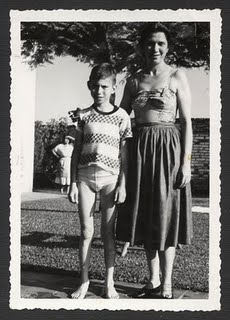
My mother kept several notebooks where she wrote love poems to the man in Manila she never married. Sometime in 1937, in a moment of impulsive fury she cast an opal ring he had given her into Manila Bay and she, her mother, sister and brother moved to Buenos Aires. My mother never let me forget that Dr. Andía, the man she never married had remained in that important corner of her heart and that my father had been a second choice. I never told her I felt like a rejected offspring of that second choice. She told me that love was action and doing and not false warmth. She rarely hugged me but she sacrificed most of her life to make enough money to send me to the best schools where I mostly squandered it by being a mediocre student who managed to cruise with not much effort. Rosemary and I had one of the more complete notebooks of poems beautifully bound in leather. The bulk of the poems is dedicated to Dr. Ramón Andía. But there is one poem that is not.
Argentine Nostalgia
I thought I’d never miss: -
The wide expanse of pasture of the pampas,
The lead gray skies & stratus clouds
The whistling, whining, violent “pamperos”,
The wet moist cold,
The hot damp heat,
The monotonous landscape
Bare of trees & bushes 7 human beings
Populated by lazy, cattle.
But I do,
And remember,
The balmy breezes of early spring,
The mauve of jacarandá trees in early fall,
The crisp, white frost of midwinter,
The golden yellow of the aroma in late spring
The pungent, acrid odor of the figs in midsummer.
I thought I’d never miss:
The untidy almacén at my corner
Overflowing with cellophane bags of capeletti & ravioli
And mounds of sacks of new potatoes,
Reeking of onions & “tipo Roquefort cheese”,
Of smoked ham & bacon hanging from hooks
Or:
The heated discussion of the Italian neighbours,
The chattering, singing & crying of their children,
The clatter of their plates & knives - they ate
In the patio & almost lived there,
Their plaintive singing of their summer land
And the merry quartets from Barbero & Rigoletto.
Or:
The austere grays & browns & blacks
That Porteños think proper to wear,
Their sober silence and quiet in public vehicles
The busy little sidewalk cafes under striped awnings,
The interminable wait for tram 35,
The long and never ending route it took,
But I do,
And remember:-
The exquisite taste and stark simplicity
That Porteños think proper for wear,
Their polite “permiso” as they sidled by you on colectivos
The gracious old-fashioned cadence of the
“Cuando” danced in a café.
The beautiful church on Juramento and Cabildo
I always watched out for out of the window of Tram 35
The expectation of getting to Mother’s flat,
At the end of the line,
And the warmth I’d get there!
Filomena de Irureta Goyena de Hayward
Nueva Rosita, Coahuila, Mexico
Dec 5, 1956.

The poem is not entirely truthful in relation to sober and polite Porteños. My mother had a beautiful body and the best legs I had ever seen until I met my wife Rosemary. But in Buenos Aires she always wore a girdle. She explained to me that the Argentine men who sidled by her as she rode the colectivo (small Buenos Aires buses) had the habit of pinching her bottom with regularity. This became impossible when she wore her pinching barrier. The pampero is a wonderful wind that comes from the pampas that smells of wet earth when it is about to rain in Buenos Aires. And almacén is usually a corner grocery store which in my mother's time (and mine) was run by Italians who spoke little Spanish. The man who owned the almacén half a block from our house was called Don Pascual. Above is a jacarandá blooming in Plaza de Mayo. The building behind is the Buenos Aires cathedral. Below middle is the only slide (I took it in 1965) that I could find of a colectivo. The building behind is the seat of the president of Argentina's power, la Casa Rosada. To the left of the colectivo and above the tall entrance to the Pink House is the balcony from which Perón and his wife Evita addressed los descamisados or the shirtless ones.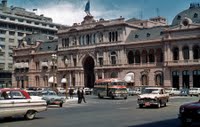
Below, right is a picture of La Redonda (The Round One) the church my mother would anticipate as she rode the Number 35 tram to her mother's flat. In one of those rare but appropriately symmetrical moments in my life I went to Mass there in 2004 with Rebecca and my godmother and first cousin Inesita O'Reilly Kuker. The Number 35 tram was long gone but there were plenty of colectivos that my mother could have ridden and looked out of the window.

More Argentine nostalgia
And more
And even more nostalgia



It was sometime in 1967 that I attended a concert of the Jefferson Airplane at Fillmore West in San Francisco. I had hair down to my shoulders but I was as straight as an arrow. It was at the concert that I first began to find connections between what I had learned from Ramón Xirau in Mexico City about philosophy and in particular about Plato in relation to the reality of everyday living. It was at this concert that I spotted a young woman sitting at a corner staring at a little cocktail glass of crème de menthe. She was staring, I quickly ascertained at the greenness of the liquid. I am sure that for her the green was to ti esti, or the equivalent in English from the Greek, that what it is. She was staring at (in her imagination) absolute green, or Plato’s idea of essence.
As I continued in my hobby of photography that year and began toying with the possibility of perhaps making money from it I had with me the inspiration of three photographers I admired. One was and is (he is very much alive) American Bert Stern. The other two were the Latvian Philippe Halsman and the German August Sander. I have always been attracted to their spare style and their respect for their subjects.
In February 1992 I traveled to the remote community of Kyuquot, BC on Vancouver Island. I had been dispatched to teach photography for a weekend to eager students who were members of the Kyuquot Native Tribe. That weekend became a blur in my memory and when I looked at the pictures of them this morning (I am writing yesterday’s blog today, Thursday, morning) all I saw were their smiles. There were lots of smiles. They were eager to learn.
Any one of those classes that I taught for the Emily Carr Outreach Program would have been a classic, “Today we are going to look at exposure and sharpness, tomorrow we will discuss the rules of composition.” Since this was before the digital revolution I took along Polaroid b+w instant 35mm slide film and a little motorized processor. My students could shoot one day and we could project the next day their results. It was fun.
Last night as I was going home from six hours of teaching The Contemporary Portrait Nude and Portraiture Through the Ages at Focal Point on 10th Avenue I was shocked to realize how teaching photography has changed (from my perspective).
In the nude class we have the most fantastic models (male and female) and we progress in how the nude has been seen not only in photography but in painting. Since our class is supposed to be contemporary we even had one segment where we bring in Yuliya a most interesting model that specializes in fetish. She holds a degree from Simon Fraser but in her spare time she sits on businessmen’s faces or presses her stiletto heels on their nether parts. The photo sessions in our class are tame by comparison but my students get to know a bit more than just the idea of a nude as simply a body sculpture and how parts of the body resemble dunes in the Sahara.
In the other class, as an example, we projected yesterday the students’ pictures of models that we dressed up (or undressed) to resemble paintings by El Greco, John Singer Sargent and photographs by Man Ray.
I finished the class by explaining that Bert Stern, in particular, had taught me (through his pictures) the idea of removing from a potential photograph all that was not necessary while retaining the essence of the person being photographed. This essence was and is that which without it the person loses his or her identity. As an example I cited Stern’s photograph of a business-suited Gary Cooper holding a Western Colt .45. The gun (and only just the gun) instantly made the man the troubled lawman of High Noon. I told my class how Halsman had almost pushed Humphrey Bogart into collapse by telling Bogart he did not want to take his picture as crook or as detective but as his essential self.
Of August Sander who reverently photographed the professions (both the elites and the poor down to the beggars) of Germany for fifty years (the first half of the 20th century) I told my class that rare in this 21st century was his ability to respect the humanity of his subjects even when his subjects were members of the Nazi Party or elements of the SS. Specially troubling but beautiful were portraits of Jews taken in the late 30s who in retrospect we know vanished soon after. For Sander the essence of his subjects was the fact that they were human.
I finished my class, not with an explanation of sharpness and exposure (I did delve on the idea of controlling contrast) but with a sketch on the board of Plato’s cave and an explanation of the chained men, unable to move from their stone bench, who saw "reality" projected (blurred and flickering like the fire between them and the opening to the cave at their back) on the wall in front of them. I told my students of the curious novel by José Saramago, La Caverna, where during the excavation of a mall in Lisbon, a cave is found with the remnants of charcoal, a stone bench and some chains…
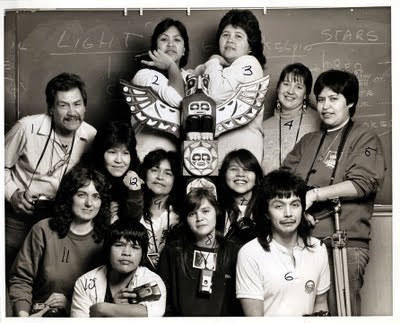 1. Eugene Leo
1. Eugene Leo
2. Natalie Jack
3. Anita Jack
4. Kathy Williams
5. Marilyn Short
6. Robert John
7. Bonnie Jack
8. Nancy Gillette
9. Therese Smuith
10 Warren Short
11. Ruth Zand
12 Valerie Hansen
13 Velian Vincent
The smiles of my students in Kyuquot remind me of the simple and naïve world we all seemed to live in once and I now wonder how my new students will tackle the complexity of a world that seems to have forgotten the essences.
Addendum: I noticed the sweater I was wearing in the picture above. I remember that I had bought it at a discount store for under $10. It was Scottish wool and it had been knit in Scoland. Just a few weeks ago I photographed Rebecca in the fall garden with the same sweater here

Noël Coward’s diary entry for Saturday August 6, 1960 reads as follows:
...I have just read, very carefully, Waiting for Godot, and it is my considered opinion it is pretentious gibberish, without any claim of importance whatsoever. I know that it received great critical acclaim and I also know that it’s silly to go on saying how stupid critics are, but this really enrages me. It is nothing but phoney surrealism with occasional references to Christ and mankind. It has no form, no basic philosophy and absolutely no lucidity. It’s too conscious to be written off as mad. It’s just a waste of everybody’s time and it made me ashamed that such balls could be taken seriously for a moment…
-------------------------------------------------------------
To be frank I kind of agree with Coward and I have been bored to death the two times I saw this play. But there is one aspect of the play that always made me curious. Why is it that it always features Estragon and Vladimir wearing bowler hats? It seems that when Beckett was writing the play he had no idea of the two characters being tramps. But he is quoted as saying to French director and actor Roger Blin (who directed and acted in the first production of Waiting for Godot, on January 5, 1953) “The only thing I’m sure of is that they’re wearing bowlers.”
While researching this blog I further found out that a character in the play, Pozzo (played in the premiere showing of the play by Roger Blin) presents himself as a conceited landlord. He smokes a pipe, made by Kapp and Peterson, which are Dublin’s best known tobacconists. Their slogan was “The thinking man’s pipe,” which Pozzo refers to as briar but which Estragon calls a dudeen emphasizing the differences in their social standing. “dudeen” [Irish Gaelic dúidin, diminutive of dúd, stump, pipe] emphasizing the differences in their social standing.
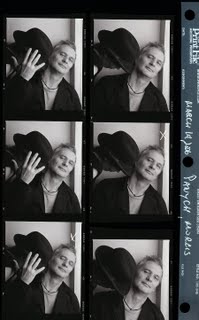 This above fact made me smile as I have written of my 10 Petersen pipes here! They were always my favourites in combination with Bell’s Three Nuns Pipe Tobacco (None Nicer!) I thought the long profile of the Petersen pipes made me look that much more sophisticated!
This above fact made me smile as I have written of my 10 Petersen pipes here! They were always my favourites in combination with Bell’s Three Nuns Pipe Tobacco (None Nicer!) I thought the long profile of the Petersen pipes made me look that much more sophisticated!
The whole above stuff is but a prelude to an explanation of the photograph you see here which I took March 19, 2006 of theatre director (and actor and playwright) Morris Panych. He was directing Beckett’s Waiting for Godot for the Arts Club Theatre Company at the Stanley. The Straight had dispatched me to photograph him. I was given a few minutes, between rehearsals in the lobby of the Stanley. I had no idea what I was going to do even though I had brought my big camera and my studio lights. I was met by a lovely new publicist (4 or 5 months on the job), Nicole McLuckie who had bright red hair and a most pleasant demeanor. She must have been very nervous as dealing with Panych has never been an easy thing. I decided to go for broke and asked her if she could find me a bowler hat. This she did and I took what is one of my favourite photographs ever. And Panych was uncharacteristically smooth and pleasant.
We never did decide if McLuckie was Estragon or Vladimir. But having observed McLuckie’s considerable publicist skills in the last few years, I would assert there is more of a resemblance to the assertive Vladimir.

Snow White’s evil queen looking at herself in a mirror is seen as the tragic flaw that initiates a series of events that result with Snow White living happily ever after.
There is a lesson here that I have wanted to teach Rebbeca. A few months ago I took a beautiful light jet print of Rebecca to Grant Simmons at Disc so that he could use it as reference for the scan, one of four that would result in my latest promotion attempt with postcards. Grant looked at the print and said, “I can do a better job than that. Leave that print behind and I will make a new one. You will see the difference.” Rebecca was bothered as we left by Simmons’ cocky faith in himself. Rebecca saw this as a flaw. She said to me, “He’s full of himself.” I was really unable to explain that when one is an artist or one has an artistic temperament the only (when money is scarce) encouragement one can have to keep at it is a faith in one’s ability. “If you think you are the best,” I told Rebecca, “you are better for it.” She was not convinced.

I did return to pick up Grant Simmons’ version of the Rebecca picture and the difference, while subtle, was overwhelming for those of us who know about correct skin tones and the keeping of texture and detail in very light areas. The print was superb. Grant Simmons is, I believe the best drum scanner in the business and his use of Photoshop is never noticed, it is that good.
Snow White’s Queen, is a beautiful woman who begins to have doubts of her beauty. She must know that she is the most beautiful. This “flaw” affects models, dancers and, yes, photographers. We must know that we are good. In some cases it is not important to be told so. Deep inside, we must know by ourselves.
Vancouver does not understand sustainable excellence. To be exciting you have to be a dazzling and short-lived shooting star. I remember the years of struggle that Christopher Gaze went through before he made his Bard on the Beach the success it is today. This success is now taken for granted by many and no hats are taken off to salute the man’s excellence, talent and perseverance.
There are some who tell me they like this blog. They tell me they like something I wrote. For someone who is a photographer that is a very good thing to be told. To be told that the writing is okay. But is seems to me that the photographs are taken for granted. A couple of years ago someone that I don’t know sent a contact submission through this blog’s parent web page that read, “Today’s photograph of Rebecca is ugly.” I felt hurt and indignant that someone would spend the time to send me such a message. Now I am beginning to warm up to it. It means that someone was noticing the pictures.

I am particularly proud (and I will have to explain to Rebecca that being proud of what one does well beats false modesty), of today’s black and white portrait. I took it for the inside of the Georgia Straight in 2005. I had been commissioned to shoot the cover which was about Ballet BC’s second mounting of its popular and racy Carmen. For the cover I used a ring flash which was positioned crooked to get that neon/ring look on the side. This happens because the camera's wide angle lens "reads" or sees the edge of the flash. The folks at the Straight could not understand it so they cropped it out. To make things worse the dancers arrived late and had to go early. Suddenly not only did I have to shoot a cover but I had to take an inside shot that looked different. I removed the ring flash and used one low open flash fitted with a honeycomb grid that narrows the light. I took the pictures in a hurry with a very slow shutter. In spite of the stress I was satisfied with the result. The look of the picture resembles the avant-garde of the late 20s. It reminds me of a photograph taken by German photographer Herbert Bayer in 1932, above, left. I was very happy even though I didn’t get a boo from anybody. I will have to explain to Rebecca, what counts is that one knows that one took a good picture. I am proud of it. I don’t need a mirror to know that.
To make things worse the dancers arrived late and had to go early. Suddenly not only did I have to shoot a cover but I had to take an inside shot that looked different. I removed the ring flash and used one low open flash fitted with a honeycomb grid that narrows the light. I took the pictures in a hurry with a very slow shutter. In spite of the stress I was satisfied with the result. The look of the picture resembles the avant-garde of the late 20s. It reminds me of a photograph taken by German photographer Herbert Bayer in 1932, above, left. I was very happy even though I didn’t get a boo from anybody. I will have to explain to Rebecca, what counts is that one knows that one took a good picture. I am proud of it. I don’t need a mirror to know that.
From left to right, Acacia Schachte, Edmond Kilpatrick, Sandrine Cassini.

On Saturday night my granddaughters and I went to the Vancouver Dance Centre for a performance of Ballet BC's Surfacing in collaboration with the Arts Umbrella Graduate Program. It was sold out so we returned home in the rain. The silence and the disappointment in the car were palpable. Sylvain Senez, the rehearsal director, with a big smile on his face, had told me, “Why don’t you come to the 2pm matinee on Sunday?”
I was not able to arrange to bring the disappointed granddaughters but I did manage to get a ticket and I even sat where I like to sit best, centre, front seat with my feet firmly planted on the dance floor! A wonderful springy floor for which the now Florentine yoga master Cornelius Fischer-Credo helped design.
I sat next to a long-time dance enthusiast and dancer, Betty Kovacs whom I had not seen since I last photographed her around 1980. Part of her support of the dance community involves hosting in her house Ballet BC dancers who come from abroad. They stay with Kovacs until they find their bearings. She is also President of the Vancouver Ballet Society.
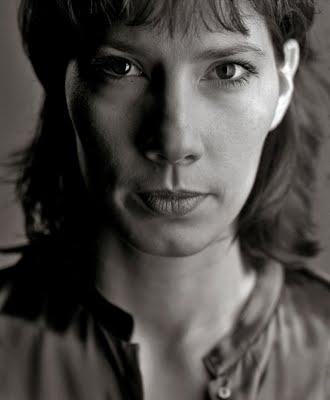
While I am sure that many of the best of Vancouver’s choreographers would have attended the opening on Friday evening and the sold out performance on Saturday night I did spot Alison Denham, Judith Garay and Jennifer Mascall. They were there for the same reason I was, to see what Ballet BC’s interim Artistic Director, Emily Molnar (right) had up her sleeve.
To begin with most in the dance community in Vancouver know that Artemis Gordon’s Arts Umbrella dance program provides its students with the dream of someday, perhaps, graduating to the ranks of Ballet BC and other dance companies of renown. There were 15 Arts Umbrella dancers mingling, almost seamlessly with their Ballet BC professionals. The program did not mention that four in the ranks of Ballet BC are graduates from Gordon’s program. They were Connor Gnam (above, left), Alex Parrett, Alyson Fretz and Alexis Fletcher.
The afternoon program consisted of four works by four different and local choreographers, Joe Laughlin, Simone Orlando (a Ballet BC choreographer and dancer), Donald Sales (a Ballet BC choreographer and dancer) and Rob Kitsos.
On Wings, Joe Laughlin fed my almost potato chip craving for some classical en pointe walking which I sorely miss when I watch modern dance. And, of course, some Alexander Scriabin. The world needs more Alexander Scriabin. There is a lot to be said for modern dance, which I really love, but sometimes I need to experience the grace of those classically beautiful moves that are ballet and the reason why ballet, be it classical or modern, will always have a niche in contemporary dance. I am glad that Molnar had this on the program. It was my wife Rosemary who said to me when Molnar was named the interim artistic director, “Emily is going to eliminate all that classical ballet and give us only modern dance. She will fail if she does that.”
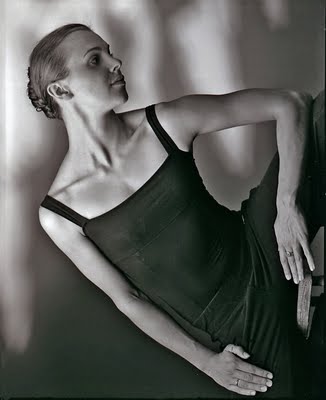
The last segment was Rob Kitsos’ Regression Line which featured very loud heavy metal/punk type music by Brooklyn’s Dub Trio. For me the saviour of the piece was the brutal performance (full of expression on her face she can change from point shoes, to pouts and sports shoes and fatigues with no problem) of the real star of Ballet BC (besides that classical ballerina Makaila Wallace) Alexis Fletcher, seen here on the left. Like her former Ballet BC dancer mate and fellow Arts Umbrella graduate, Acacia Schachte (who dances for New York’s Cedar Lake Contemporary Ballet) she has a style that is all her own. She stands out. She is not your typical cookie cutter clone that graduates from so many other ballet and dance schools.
Since I am no dance critic I will gently suggest to Emily Molnar that she might want to plan in the future to bring in a couple of our best city choreographers who could progress with Kitsos’contemporary vision. Shay Kuebler (choreographer and dancer) and Amber Funk Barton (another Arts Umbrella alumnus) both have incorporated modern dance to hip hop and by fusing together the two, have come up with a dance form that is grueling, contemporary, and exciting. If Molnar is able to secure that needed funding, Jane Coop would have polished off that Scriabin sonata with aplomb and I know of a few musicians who could have adapted that Bach double violin concerto to two violins and a cello. Live music can make such an intimate dance program that much more intimate.

The two middle pieces were the ones that I really liked. I liked them because more and more I see so little humour in modern dance. In Simone Orlando’s Doppeling, John Sebastian Bach competes with Prince Valiant. It ruined my wish of seeing Arts Umbrella dancer Alexander Burton, see above, with Emily Molnar on the left and Artemis Gordon on the right), show me what he can do with so much passion. Orlando put Prince Valiant wigs on everybody, males and females and had me seriously trying to figure out who was whom and if I was supposed to laugh or not! I decided to be less serious and just enjoyed myself. It is so pleasantly surprising to see how much humour Orlando hides behind her serious face.
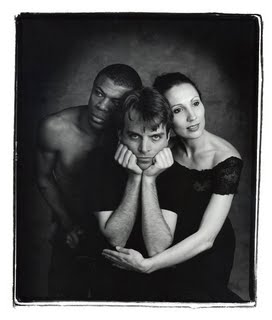
Donald Sales’ (seen in picture, right, with Simone Orlando and centre, composer Tobin Stokes whose score was used for John Alleyne's ballet A Streetcar Named Desire) Long Story Short gave me what I had come to see (besides, Alexis Fletcher, Connor Gnam and Alexander Burton) and this was the newest member of Ballet BC, Alyson Fretz. I had first seen here some five years ago telling my granddaughter Rebecca to not be distracted in a beginning ballet class. Alyson Fretz (seen below sitting with Alex Parrett standing behind her and with Arts Umbrella dancer who also helped my Rebecca pay attention, Caroline Kirkpatrick) was one of Andrea Hodge’s (ex Ballet BC dancer and dance instructor at Arts Umbrella) helpers. I have watched her grow from a little girl to the strong and muscular dancer of today (Alexis Fletcher, watch your back!). And this piece with lots of humor, lots of classy Donald Sales humor) also allowed me to observe Connor Gnam’s rare ability (one rare in so many ballet dancers) to express emotion not only with dance moves but with facial expression.
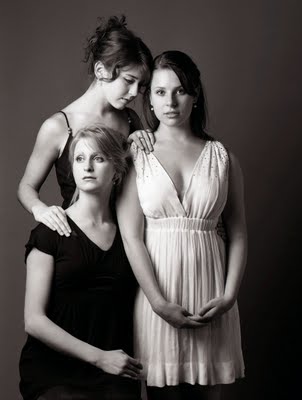
One very pleasant surprise for me was that other new Ballet BC dancer Gilbert Small, who is very black, very talented, very muscular and fun to watch.
When I was waiting for the performance to begin ( I had arrived early to make sure I could buy a ticket) I spotted that other Ballet Boy from Arts Umbrella, Jed Duifhuis. I asked him, “Am I going to enjoy this?” With a big smile (he is normally stone-faced) he answered, “We are having fun so you are going to have fun.”
First off there he was picking up prima ballerina Makaila Wallace and I wondered what it was like for the “student” to be on stage with such a star. Wonderful and fun, I am sure.
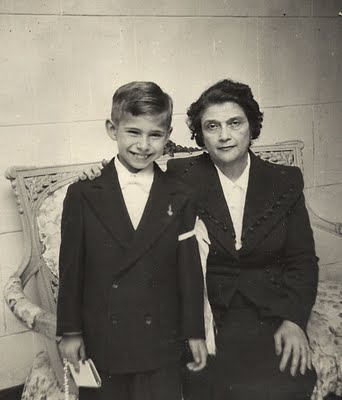
I think that the worst fact about good times is that we rarely realize that they are indeed good times. At least that has been the case for me. Looking back at going in a private jet, a Cessna Citation, to León, Guanajuato for a magazine to photograph a story on a Canadian pioneer flyer living in San Miguel Allende, I now know that for contemporary photographers, that would simply not happen. The magazine would find a photographer in San Miguel and instruct her to take some quick ones and send them back via e-mail.
In my files I have portraits of many acting and directing luminaries of film. As an example I am most proud of my medium format camera, and studio lights portrait of Werner Herzog. At the time of my picture he had come to Vancouver sponsored by the Goethe Institute in Vancouver. The institute is long gone from Vancouver and directors, actors, authors are now interviewed from their home (meaning on the phone) and some less that honest publications hide the fact that many of those interviews are question-and-answer ones via email.
Saturday was such a melancholy one, (besides the fact that it was visually gray and dreary) that I postponed the writing of Saturday’s blog to today. Today, Sunday, brought a scary NY Times Magazine that has articles and articles about how our life has changed and is changing.
Perhaps the most depressing of the articles is a review of Harold Evans’ My Paper Chase- True Stories of Vanished Times in the NY Times Book Review. The review is headed by : When Type Was Poured Hot – In his new memoir, Harold Evans recalls an exuberant run into 20th–century journalism.
By the random nature of looking for DVD films at the Main Branch of the Vancouver Public Library I found a film called Edges of the Lord (the name becomes significant at the end of the film) directed by an unknown (for me) Yurek Bogayevicz about life in a little village in Poland during the brutal occupation of the Wehrmacht and the transporting of Jews in trains to their final solution. The film has the surprising casting of Willem Dafoe as the chain-smoking village priest and a string of child actors that is extraordinary. The film is rated R and Rebecca pointed this out to me. I took my chances and I think I was right in that the film (“I would not want to see it again, it was so depressing,” Rebecca told me.)had the three of us glued to the antique Sony Trinitron TV.
The realism of a young boy shooting an older young man who is systematically going through the possessions of Jews who managed to jump out of a slowing train, before killing them or handing them over to the Germans was brutal. Rebecca understood. I don’t think Lauren (7) did. But then when the film ended she said, “That was a good movie.”
The final scene has the four children being given their first communion by a most understanding Dafoe. When time comes to slip the wafer host into the mouth of our little heroic protagonist (a Jew, told by his parents, before he was sent to the village, to mimic Catholicism for his survival) he shows the boy that the wafer is not the round blessed one, the body of Christ, but the unblessed edges removed by the priest when making them. He is in cahoots with the boy and one religion respects the other.
I understood and when the appropriate time comes in the next few weeks I will have to explain to Rebecca (who will never have a first communion as her grandfather once did) what it is that transubstantiation is supposed to be. These mysteries, complex mysteries that they are, believe in them or not, bring in a level of complexity into one’s thought that will enrich one’s life.
A little boy, younger than our heroic Jewish protagonist wills himself to join a train going to his final destination. He is not Jewish. He is a fervent little Catholic boy who the director makes into a little Christ who feels he has been left alone by his father and willingly then goes towards his death.
Perhaps Rebecca will not see the film again. But once I explaina to her what was going on I hold my hopes that she will change her mind.
There is no more hot metal type, and journalism as I knew it is mostly gone. A memory of it is all we need to bring back a complexity in life that could not be simplified into HTML.

It was in 1965 (I have a mental block for the month of the year or the day) when the phone rang at the retired U-boat officer’s pension. It was for me. A man with a crisp British accent said, “Alexander your old man kicked the bucket yesterday. He died on the street and was taken to the hospital by vigilante (cop). You have to go to the police station to sign some documents. I terribly sorry.” The man with the crisp British accent was an Armenian who had worn the kilt of the Black Watch in WW-I. His name was Leo Mahjdoubian and we all called him Uncle Leo even though he wasn’t our uncle.
For about a year, I had been going to lunch at his San Isidro home on Sundays. The food prepared by his wife Helen (who looked like a cross between Maria Callas and Yvonne de Carlo) was a treat from the humdrum (and even terrible) Argentine Navy barracks food. We would sit at the table accompanied by Leo’s two sons Julian and Leslie and friends. From the very beginning three separate pepper mills caught my eye. It seemed that each one had pepper from a different area of India and Madagascar. The meal started with a salad followed by some sort of pasta and then a huge roast beef with potatoes and Yorkshire pudding. Before dessert we had soup which at the time was an Argentine custom. The idea was that if soup were very well prepared you would have room for it between a meal and dessert.
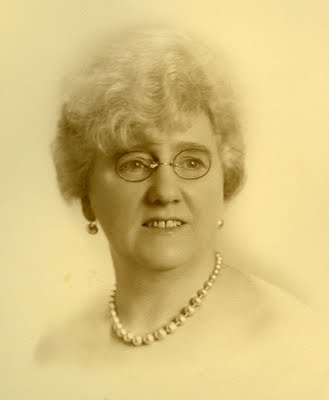
The men were pushed upstairs for a siesta. At about four we were awakened and we went down to a high tea to die for.
During my stay in Buenos Aires Uncle Leo always asked me if I needed any money. He would say, “I made lots of money with my assurance company so if you need anything, just ask.” I felt guilty about his hospitality so when possible I would show up at the Sunday lunches with a large blue can of Edgeworth pipe tobacco. We both smoked a
pipe and Edgeworth was my favourite brand. It was impossible to get it in Argentina but the officers of the US Navy for whom I worked as a translator provided we with some little benefits.
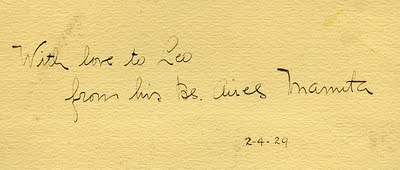
After World War I, Leo had decided to move to Buenos Aires. It may have been around the beginning of the 20s. At the time my grandfather Harry and grandmother Ellen lived in the Province of Córdoba. Harry had made good money working for a shipping company. He had moved from Manchester to Buenos Aires at the beginning of the 20th century. He came over with his first son Harry. In Argentina Harry and Ellen had five more children including my father. My guess is that in the mid 20s Harry had a heart attack and Ellen found herself a widow with six children. She moved to Buenos Aires and started a bed and breakfast (a glorified pension). Two boarders were to become important in my life and in the rest of the Hayward clan. It was at Ellen’s pension that Leo finally settled in as well as James Blew. James married my youngest aunt, Aunt Lilia. Leo had an easy going manner and he soon became an adopted member of the family. I believe that in later years Leo somehow was the family financier who might have even helped pay some of my father’s and my Cousin Robert Hayward’s gambling debts. I am only guessing this since anybody who could confirm it is long dead.
Before Uncle Leo died in the late 80s he sent me a photograph of my grandmother Ellen (Ellen Carter). It came with a backing that had a dedication by her. For about 10 years I misplaced this photograph. I found it yesterday filed with some of my self-portraits. The other picture here is of Ellen and her husband Harry.

The only grandparent I ever met was my mother’s mother so finding this photograph and remembering the Hayward side of my family gave me some comfort and nostalgia for those three-pepper mill days.
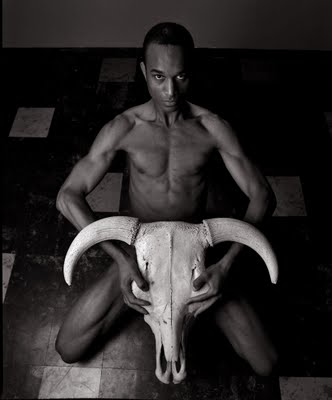
Association takes one on strange paths. That latest path began this afternoon when I was on my way to pick up Rosemary from her physiotherapy (for her mending broken ankle) at the Vancouver General Hospital. Radio 1, CBC was running a story on the Jonestown Massacre of November 18, 1978. I was listening to the events that led to the shooting of US Congressman Leo Ryan and five other on the tarmac of the Port Kaituma airstrip. I was so distracted I kept driving for a few more blocks on 12th Avenue before I realized my mistake. I was never really able to ask my friend, photographer and model Nina Gouveia about it. She was born in Georgetown, British Guiana (now Guyana). She is the only person, besides my life insurance agent, Winston Miller that I know that came from that remote little country in the bulge of South America.
Africa, via Haiti, not Guiana was on my mind most of the morning. Rosemary and I had caught, the night before, a wonderful documentary/trailer on the 1967 Peter Grenville film, The Comedians, based on the previous year’s novel by the same name written by Graham Greene. The novel was set in Haiti under the scary rule of François “Papa Doc” Duvalier and his secret police the Tonton Macoute. The film features Elizabeth Taylor, Richard Burton, Alec Guinness, Lillian Gish, Peter Ustinov and the very funny man (playing a very serious part) Paul Ford whom I remembered as the officer Sergeant Bilko (the Phil Silvers Show) bullied and mentally (and sometimes physically) ran over with his constant schemes.
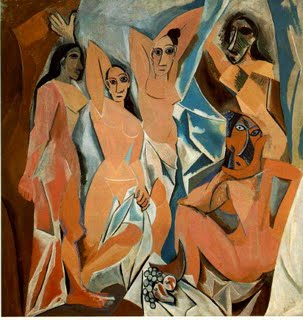
The wonderful trailer was narrated by a youthful Richard Burton with running comments by Alec Guiness, Lilian Gish and Peter Glenville. Burton explained that by the time the film was being made the sitution in Haiti had so deteriorated that they had to look for another location. That location was the former West African French colony called by then The Republic of Dahomey and is now the Republic of Benin. They imported voodoo experts from Haiti to make sure everything looked authentic. While watching all this I thought of Picasso’s African Period (1907- 1909 which came after his Harlequin Period which had ended with his Le Mort d'Arlequin in 1905) and how it had inspired other artists to pursue African masks and Primitivism. Among the artists was Man Ray.
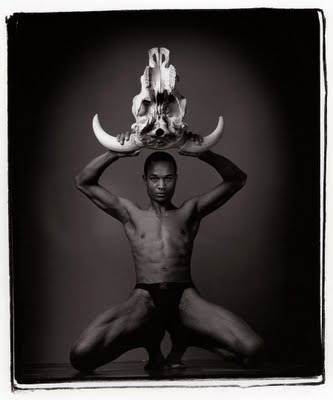
The first painting that Picasso had finished that was attributed to his new interest was his Les Demoiselles d’Avignon. The title can be misleading as d’Avignon was the most famous street in Picasso’s Barcelona as it was the location of a famous brotherl. The two “professionals" on the right seem to be wearing masks or perhaps they were a preview of Picasso’s journey towards Cubism.
By the time I brought Rosemary home I was determined to find a negative of a handsome black male dancer I had photographed for the Straight who had brought the concept of African primitivism to his choreography. I could not remember his name. But I got lucky. On the pile of stuff (which I have been clearing now for three days) next to the left of my scanner and on the floor I found a copy of the Georgia Straight.
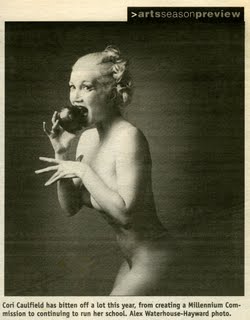
It featured a picture that I had taken of dancer Cori Caulfield (in a most primitive pose of Eve biting on that apple) for the September 6-13, 2001 issue. This was the only real nude of mine that the Straight ever published.I convinced them that the crotch shadow was indeed a shadow as Caulfield at the time was under the influence of Brazilian un-hirsute primitivism. On another page I found my African (but Jamacan born) Ran Hyman. I ran to my dancer files and looked under H. There was nothing! He was filed under Ran.
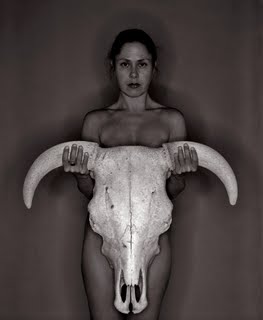
I enclose here a picture of Guayanan (Guianan?) Nina Gouveia, that many of you have seen here. It is here for one reason. Just check out that skull. It is the same one. It was owned by my Argentine friends and Nora Patrich and Juan Manuel Sanchez. I never got to ask them how they had managed to buy that Picasso from his Musketeer period.

In all my years as a freelancer in Vancouver weekends were really no different from weekdays. Then there are the perceived seasons. Every time I run into someone who asks me, “How was your summer?” I either answer sarcastically or I don’t answer at all. What is seen as sarcastic is when I explain that since I work when I can, I don’t necessarily have summer holidays. Summer can be just like any other season. Sometimes I cite that beautiful moment in the Robert Redford film version of F. Scott Fitzgerald’s Great Gatsby. Redford (in white slacks) and someone else are walking on the side of swimming pool. It is a brilliant and sunny afternoon. One of them says to the other something like, “It was a fine summer.”
For a freelancer I think that every day is a scary Monday and more so now with a decline in the magazine business and the resulting decline in the need for photographs. But I have to admit that weekends are now weekends for me. Saturdays are the days when Rebecca and Lauren spend the day with us. I anticipate their coming days in advance and I feel a bit on the sad side when I drive them and their mother home on Saturday nights. Mondays are now special, too (and less scary) as we take care of the kidsin the afternoon. I pick them up at school and cook a quick lunch for them. Hilary shows up later for dinner.
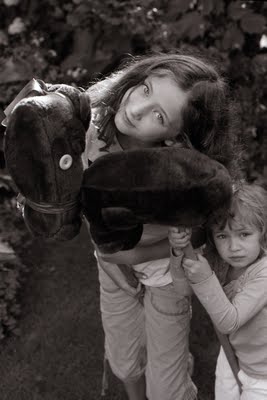
This last Monday I took Rebecca and Lauren to the main branch of the Vancouver Public Library, Both girls are feeling comfortable with the place and Lauren who has learned to read in English in the last weeks (she is in French Immersion) is able to find books and sit at the small tables and make her selections to borrow. Rebecca sits on the floor and looks at her choices. She loses track of time. I found a 2000 film version of Jack London’s Call of the Wild. I knew I wanted the girls to see it. But I also knew I had my own reason. The lead actor is Italian born actor Nick Mancuso whom I met in Vancouver some years back. After dinner (Rosemary had to work with her laptop) the girls, Hilary and I watched the film which was truer to the novel than the 1935 version with Clark Gable in which the whole plot revolves on Gable running into Loretta Young in the frozen wilderness and the dangerous thaw that follows. At first Rebecca wanted to go home. She was soon drawn in by the beautiful dog, Buck. I made it like I was being bored and that I was going to turn it all off. Rebecca knew I was kidding. It was an enjoyable evening and when I delivered them home it felt like a Saturday night.
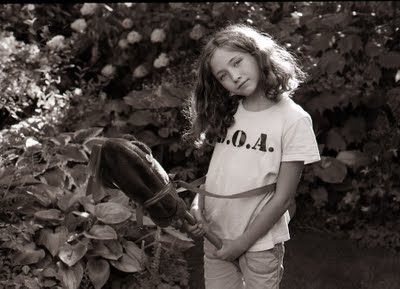
Today Rosemary and I pollarded the hawthorn tree in the front and even though I wore gloves I got many nasty thorn punctures. I spent the rest of the day trying to get rid of the pile of photographs, negatives and slides that perennially occupy the floor on the left of my computer and scanner. No matter how I hard I try, there is always a pile. The problem is that I find long lost stuff in it. Today I found a beautiful print of my grandmother Ellen Carter (sent to me by my uncle Leo Mahdjubian about 17 years ago) which I had lost for about 6. I also found a set of b+w negatives that included some of Rebecca and Lauren riding some brooms that they converted to horses with cloth heads and sewn-on buttons for eyes.
When I found them I became melancholy. It was Wednesday but it felt like Saturday or Monday. I believe I must have taken the photographs last summer.
Jay Gatsby: Summer's almost over. It's sad, isn't it? Makes you want to - I don't know - reach out and hold it back.
Nick Carraway: There'll be other summers.
For me there was last summer with the broom horses, this summer, and, I hope Nick is right and that there will be more summers to come.
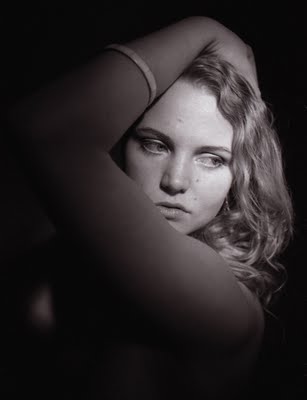
Honest blogs can be embarrassing sometimes. But then I believe that within limits a blog is a web log. And a web log is a digital diary. If I wanted to stress this idea I would begin every day’s blog with that ever so quaint Dear Diary, …
Sometime in the mid 60s I was a room boarder in a home owned by a retired U-boat man and his wife. I was in the Argentine navy and because of my English I was spared the horror of a small destroyer bobbing and yawing in the South Atlantic and had the privilege of a desk job and an Irish/Argentine secretary. I also had the choice of living in barracks and be subjected to vicious petty corporals who liked to play soldiers in earnest or I could opt to renting a room. I chose the latter. To pay for the room I worked as a waiter in a bar in the Boca on weekends.
I was 22 years old.
This is something the submariner’s wife could not understand. She would get angry at me when I had uncontrolled nighttime fluid emissions and I would “dirty” her pristine sheets. I tried to explain to her that I could not control my nighttime subconscious. So she insisted I sleep with a towel under me and over me. When I started getting dreams involving the Gestapo I decided to bid the submariner goodbye.
Now at age 67 when I walk on Granville on the odd late evening (something I do not do with any regularity) I do not look at the noisy bars (the noise has to make up for the lack of smoke or perhaps noise used to be dissipated by tobacco smoke) with any kind of jealousy or longing. I do not wish to be young and be looking for a woman or a partner or someone I may want to live with or marry. That is in my past. Perhaps the only advantage of youth that I am truly jealous of is that idea of falling in love, of even falling in love for the first time.
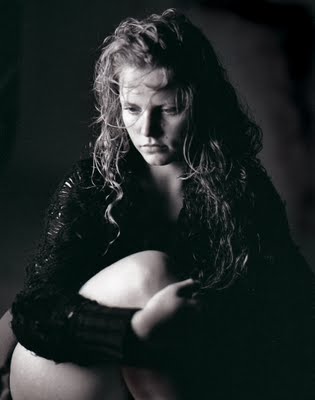
Time dulls all that and I don’t see myself dumping Rosemary, selling the house and buying a brand new Maserati to try to capture a lost youth. The Maserati I still own, is rusting in the garage and there is no way I will bring back my pipes. I would feel like that Playboy guy. He has no idea of what it is to have grace in old age and to make an unburdensome exit. Besides I can see at least one bed towel in my future as the body inevitably lets go of controls.
All this is but a prelude. It is an overture (if I am going to be repetitive about all this). It is setting up the reason for posting these two pictures here. There would be other pictures but there are self-imposed restraints that prevent me from showing you that not only does Keely have a face to launch a fleet of triremes but a body that in water would have prevented that Eureka moment for Archimedes who would have sunk into his bath with a heart seizure.
We have had Keely twice as one of our nude models at Focal Point. The first time was last year. She did not have a bank of tattoos all over her body. She has only one on her ankle (away from other more relevant areas) and would you guess that it has a saying in Spanish? It is something about the fact that if you don’t dare you won’t get anywhere.
It is my premise here that when one has arthritic pinkies (my case at the moment), a sore elbow (result of having broken it a couple of years ago) and when sustainability is simply, and, alas, only, being able to stay in bed in the morning, with some measure of controllable discomfort, in spite of having to go to the bathroom, any opinions I may have about the fair sex must be purely objective, with no vestige of desire or anything else.
This is comforting in many ways. It means that I may just approach Keely in some future project that will help me sustain my interest in this momentarily unsustainable profession of mine which is photography.

Two events on the same day, last Thursday, November 5 left me with thoughts running around my head like cockroaches on a kitchen counter in the middle of the night in the tropics when one turns on the light. The activity was brutal.
At first one would think that former Vancouver city mayor Sam Sullivan’s unveiling of his Global Civic Policy Society at the Pan Pacific Hotel Crystal Ballroom would have nothing in common with the Solo Collective, Aaron Bushkowsky’s play The Project (directed by Rachel Peaks) which opened Thursday night at Performance Works on Granville Island.
The venues were different, the audience was different, the food was better (Sam had a better budget than the Solo Collective which was celebrating its tenth year of existence and had a modest table with goodies) but in the end it was a similarity in language that stuck out for me. Both events showcased the failure of language be it through repetition or through a false projection of relevant and instant intimacy.
Sitting between the lovely, refined and ever so much fun Leila Getz and Martha Lou Henley at the Crystal Ballroom of the Pan Pacific I heard host Mike Harcourt introduce UBC luminaries on the environment, density and other relevant urban affairs give short talks on Sam Sullivan’s organization which received a five hundred thousand dollar contribution from Charles Annenberg Weingarten and the Annenberg Foundation and from local philanthropists. It is Sullivan’s idea (based on practical experience) that more can be achieved to save our city, region and planet not through or within politics but by intelligent advocacy run by experts. I spotted such experts as former Councilor Gordon Price and urbanist Ray Spaxman. I was most pleased to see that Sullivan had taken some of the council from his Philosopher-King-mentor, Abraham Rogatnick and has brought into the fold of Global Civic, the gentle architect Bruno Freschi. With a bit of Sullivan's passion (with a bit of help from his wife Lynn Zanatta, picture above) the venture might succeed.
Had I had a golf counter in hand I would probably have suffered finger damage clicking the times I heard the words sustainability, affordability, peak oil, green, livability, global warming, carbon dioxide emissions, eco-density, and the expression, “our cars will grind to a halt.” It would seem that the very issues that are so important to our future wellbeing are defined by words, so often used, that they harmlessly bounce off our brain like Darfur, ethnic cleansing and pandemic.
At Performance Works The Project began with actress Sarah Rodgers mimicking in a simulated TV monologue those Saturday afternoon TV programs that my granddaughter Rebecca loves where Canadian celebrities appeal to our wallets by showing us starving children in darkest Africa. The only difference here was that the more Rogers put emotion into her delivery the more the crowd around me laughed. I could not understand why. It took me a while to get it. The whole play is populated by characters who talk in made-for-television cliché. While watching CNN’s Larry King Live I can only take a few minutes before his “instant” and “intimate” rapport with his subjects disgusts me into switching channels. Somehow, in the theatre I found it (eventually) very funny and I laughed with the rest. My Rosemary resisted, but she finally succumbed to the play and the excellent actors. Andrew McNee as Fred the famous (in the play) documentary maker was so perfectly believable I would have purchased a used clunker from him on the spot. Lindsey Angell (see, below, left) was so spot on as the really smart but paradoxically vacant Hollywood blonde that I felt sorry for her at times but marveled at her ability to come back in others. Alvin Sanders shifted from being the typical corrupt Dark Africa bureaucrat to a scary guerrilla leader (the ones that command others to cut off limbs) that I would have put my grandchildren to sleep easily by pointing at a true bogey man. The play came closer than the earlier lunch to showing me why nothing seems to ever get done in spite of all the talk.

Both events showed me that the way to our hearts and pocketbooks, if we are going to see any positive change is through the intelligent manipulation of language. The play, which so many might see as a comedy produced in me a realization, a catharsis of sorts on how language has deteriorated. Would it be possible for Franklin Roosevelt to affect us with his “Fireside Chats” in our present world? Would they be Twitterable? Will Sullivan’s Global Civic Policy Society achieve results by only circumventing politics?
I would think that Bushkowsky’s play points in the direction that the language of intimacy is at a crossroads. Intimacy has to be earned with time. There can be no (realistically) shining light on the road to Damascus while waiting in line for that Americano at Starbucks.
I feel that advocacy has taken away from us that ever so useful word gay so much in the vocabulary of that exquisitely funny and intelligent (and gay) Noel Coward. I feel the same way about those words I heard at the Pan Pacific luncheon. Sustainability for me has always meant to keep something up which at my age is mostly a pipe dream. We need to find new words to get that audience to listen to us.
I would seem to me that Sam Sullivan might just want to hire Aaron Bushkowsky and other local plawrights to help him. We only have to look in the direction of the Czech Republic to realize that playwrights can change history. I am sure that Voltaire would agree.
Addendum: Sustain has a Latin root sustinēre. It is curious that the Spanish who like to keep their language free, when possible, of Anglicisms and Gallicisms eschew brassiere and opt for the more Latin sostén. It would be nice to see such green ads as:
I dreamt I was far more sustainable in my Maidenform bra.

For the last couple of years I have been trying to nail down the difference in appearance between digitally taken photographs and those exposed on film. I use the expression digitally taken as, particularly in my case, when my photographs are reproduced here, in magazines, newspapers and brochures those film images have to be digitized. I use an Epson V-700 scanner that came my way via the generosity of Georgia Straight editor, Charlie Smith. I scan my b+w negatives (old colour negatives), transparencies (35mm ones taken with my Nikons and 6x7 cm taken with my Mamiya RB-67). The scanning process brings with it an inherent extra contrast which I must then reduce by using Photoshop CS. This means that no matter how much of a purist I say I am (and I don’t) there is no such thing as a Photoshop-free image in this blog.
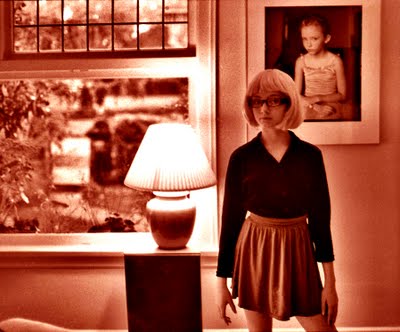
My Photoshop CS has an image adjustment feature called Shadow/Highlight. With it I can not only bring back the shadow detail lost by my scanner but also reveal a lot of that shadow detail that previously (I must admit) was not achievable even with very good photographic paper in the darkroom. To clarify this, what I want to say is that Photoshop is not inventing shadow detail that is not there, it is simply exploiting (a drawing out) the ability of good professional film (in my case Kodak Ektachrome-G) to capture shadow detail. Until the advent of digital imaging and printing and good printing presses this detail, which was always there, was lost to the limitations of that pre-digital age.
This means that my scanner in conjunction with Photoshop CS and Corel Paint Shop Pro-X (a little secret of mine) become useful tools for the conversion of my film images into digital ones. But I still think that my images look different from the ones to be found in the social networks like Facebook and Flickr. That difference I have come to understand is the slow demise of additional lighting (soft boxes and grid lights attached to studio lighting systems).

There is another difference and for that I must use the pictures I took of Rebecca yesterday afternoon in our living room. I used Kodak Tri-X and a Nikon FM-2 with two lenses. One was a 50mm F-1.4 and the other a 35mm F-2. My exposures were at the limits of hand-hold-ability, 1/30 at f-2 or 1.4. I did not want to sacrifice the small camera freedom by resorting to a tripod. I scanned the negatives as b+w negatives but scanners still include the red/cyan, blue/yellow and magenta/green. This means that I can tint the pictures to my heart’s content. These are the results of an extreme shift to red plus a tad of yellow.
By the very fact that I am using b+w film I am narrowing down my choices. The 400 ISO speed rating of my film further narrows down my choices.
The digital shooter is prone to shoot in colour (to increase options at the time of making decisions in the post-taking- the-picture which is called digital work flow. The digital shooter will use a mode called RAW in which the shooter can put as many eggs into the digital basket. I believe that it is here where the film shooter and the digital shooter diverge with a resulting difference in the appearance of the pictures (even if the digital photographer will swear up and down that it makes no difference and the digital image can be made to look exactly like the one with film).
I think that the difference occurs simply because the moment I use b+w film of a certain speed I reduce my options. By reducing my options I can spend time taking pictures not worried by the subsequent limitations. These subsequent limitations are the very reason for the look, at least in my case, of my pictures.
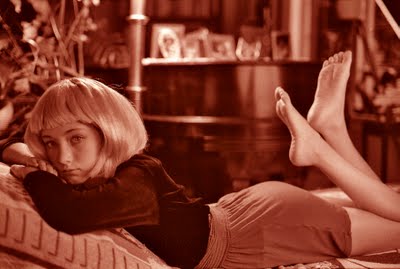
I planned yesterday’s shoot with Rebecca a week before. I called up Hilary and asked her to tell Rebecca to bring clothing she had been given as a gift. This was adult clothing owned a woman who is almost Rebecca’s size. I told Hilary to tell Rebecca that I was going to try to make her look 20.
Rebecca did not pay attention to my requests and only brought her blonde Halloween wig and a purple top and black sweater. We did not start in a pleasant manner and the session (very short as I only took 16 pictures) quickly deteriorated in a mutual shouting match. “I have a headache. I want a break. I want a rest. I don’t want to pose anymore,” she told me in her high-strung (could it be she might just one day be one of those high-strung models that make more in one hour than what I make in one month?) rapid fire voice. We stopped at 14 exposures and I felt abandoned and frustrated. But I also knew that I had some good pictures in those 14. Could it be that Rebecca’s imposition of a limitation on my shooting further explains why my pictures don’t look like so many of those in social networking sites?

For me these small camera sessions have brought an excitement of what it was like to take pictures when I was young before I became an all-knowing cynic. I will just have to be more careful as I collaborate in this re-exploration of an untethered photography. The way must lie through a little girl who in growing up knows she is in control. And she is.
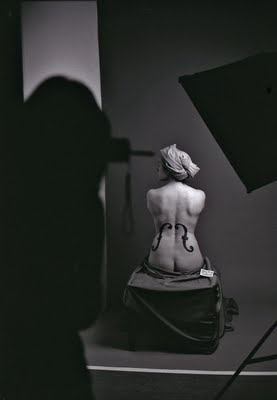
A couple of months ago I received a call from Patrick Blaeser who is the Program Coordinator: Certificate & Part Time Programs at Focal Point. “Alex, I have an idea of a course that you might like to teach. It would be called portraiture through the ages.” I thought about it and told him I would get back to him.
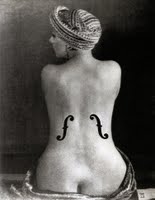
In the last few years I have been thinking a lot on how photography has progressed since Niepce took that first picture from his kitchen window in 1824. Because I was raised with books (I am a pre-internet baby!) I have many photography books in my library. I have amassed a considerable collection. My memory is still good. I remember most of the photographs of all of those books.
Without really knowing it, when I take a photograph, there is always an element of that photograph memory of the past. In some way every snap of my shutter is inspired by those photographs. But they are not only photographs of the past they can also be inspired by a painting or a sculpture. These works can be by artists who may be contemporaries to photography but many also preceded the age of photography.

As an example when I teach nude photography and we have a male model, sooner or later we explore Rodin’s The Thinker or Michelangelo’s David. Just about every time I bring in a mirror into a studio I recall Diego Velázquez’s Las Meninas.
I didn’t linger much before I called back Patrick to tell him I was very excited. The class began six Wednesdays ago. It is a three hour class held every Wednesday for ten weeks. This last Wednesday we brought back two of our favourite models, Shannon and Jerry. Shannon is voluptuous and Jerry is slim but curvaceous, nonetheless. Jerry admires Bettie Page. Jerry’s skin is white and she sports several tattoos and body piercings in strategic areas.
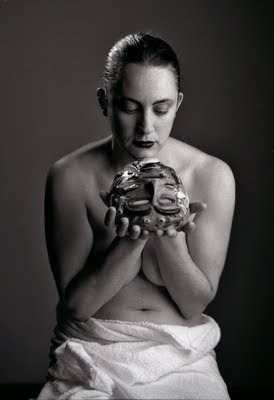
In this sixth class we worked with the inspiration of some of the photographs that Man Ray took of his model Kiki in the 20s. The more famous one is called Kiki, Ingres’s Violin. The joke of the name is that in French that name also is about obsession. Perhaps, as some say, Man Ray was not particularly inspired by the nudes of Ingres as much as using hme as the excuse to get Kiki to take her clothes off.

The second picture is called Noire et blanche. In the 1920s African masks were all the rage. Even Picasso was part of that primitive movement. Since I did not have an African mask at home I brought a Mexican one made of clay.
For the f-holes we used dry erase writing board markers. One of my students, Nicky was a skillful wrapper of turbans. She also drew the f-holes and insisted in making stencils out of paper. In the first picture you can see her silhouette as she takes her picture of Shannon.
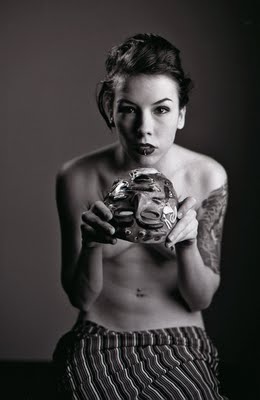
The second artist we worked on was El Greco. For this we took advantage of Jerry’s slimness. Alas I was too busy making sure everybody was doing what they were supposed to be doing so I was not able to snap any of the El Grecos. For the pictures you see here I used a Nikon FM-2 with a 50mm F-1.4 lens. Shannon could afford to rest for this as she had been very good in a previous class as John Singer Sargent's Madame X.

I worked with Kodak Tri-X and my exposures were 1/60 at f-2. I used the modeling lights of the flash units as I did not want to take shooting time from my students.
It has been a while since I have felt so excited about a class I teach. Thank you Patrick.
Addendum: Unlike our efforts where we drew the f-holes on the back of the models Man Ray drew them on his prints. It would be interesting how many of these he drew and if all those originals of his are really reproduction copies of the few he actually drew.
more Kiki via Peggy

I like to think of the serendipity of failure as one of the most welcome methods of achieving new results with the photographic process. Sometimes that failure is suppressed for years (in this case it was a period of 24 between the taking, 1985 and its revealing.) It is interesting for me to point out that to develop a negative or print in Spanish we use the verb revelar which also means to reveal as well as to make visible that which is hidden.
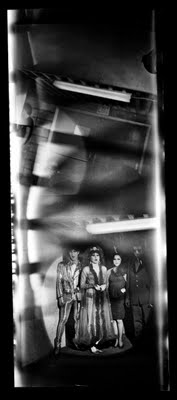 I find the word magical as it stresses less the mechanical process and more on what the image itself will show of itself, its maker and his subjects.
I find the word magical as it stresses less the mechanical process and more on what the image itself will show of itself, its maker and his subjects.
The failure here involved opening the film back to light after the exposure of the pictures. The event was at the Sub Ballroom at UBC. It was a concert with The Cramps and two local bands of note, the Modernettes and Slow. I don’t think that any of the pictures (there are 7 exposures in my files) were ever used. There may have been more but the sudden opening of the back would have ruined at least half of them. At the time I was using 220 film which meant I had the possibility of exposing 20 frames.
With the advent of good scanners I am able to “restore” these pictures to some degree of contrast and sharpness while retaining some of the intangible charm of the inadvertent gross overexposure.
More Failure.
zemblanity.
The Cramps.

Arturo Capdevila
El tablero de ajedrez (fragmento)
" Como en la vida, todo es problema en el ajedrez, desde la apertura hasta el mate. Pero todo es equidad y todo es ley. Tengo aquí peones, Caballos, Alfiles: están medidas mis potencias. Puedo adquirir, sin embargo, nuevas fuerzas por la combinación acertada de las que me han sido consentidas. Y, a la inversa, puedo disminuirlas o perderlas. Nadie sino yo tendrá la culpa de esto. Una combinación errónea me traerá siempre a menos, bajo el jaque del rival. De donde se infiere, provechosamente, que la violenta ambición es perversa consejera, y que tan sólo se ha de tomar en cuenta el interés de la armoniosa verdad. La multiplicidad de peligros de que vivimos rodeados se evidencia en el tablero. Hemos jugado por fin. ¿Qué hará el adversario?... Es el dueño de innumerables posibilidades; el mero paso de su peón, con ser nada más que un peón, puede comprometer todo mi plan y ocasionar mi ruina. Lección incomparable, que nos instruye en la suprema ley de la relatividad. ¿Y lo que se pierde, se pierde para siempre? El ajedrez nos da un consuelo. Si cuidamos la marcha de los ínfimos peones, tan pequeñitos como son, apoyando su avance con bien distribuidas fuerzas, alguno de ellos entrará a los últimos cuarteles del adversario y será nuestro precio de recate por la pieza grande que entregamos en temerario arranque al lazo del enemigo. Así, del propio error viene a servirse el ajedrizta paciente para la ulterior victoria. Parece que por tales caminos se nos aleccionará de que no hay modesta intención ni altruista constancia que al cabo no fructifique. Porque todo este juego se funda en el ejercicio altruista de los poderes, como se ve de inmediato cuando se considera que siendo el Rey la pieza menos útil, por él pelean las demás, denodadas y terribles. También se advierte que la pieza jaqueada no atiende nunca a su particular salvación sino a la del conjunto que se le sobrepone. "
Arturo Capdevila (1889, Córdoba, 1967 Buenos Aires)
Yesterday I toured our garden and saw one of my roses, uncharacteristically in bloom this late in the season. It is an English Rose called ‘Bishop’s Castle’ Two years ago when I first purchased it, the bush was glorious with multi canes and blooms. But it has ultimately been a poor grower. Now it is a sorry spindly thing. I am not all that sure it will come back for next spring. The very thin cane was bent over and one of the blooms was dragging on the ground. But one of he others was in all of its glory and in spite of the cold weather I could smell its exquisite scent. It is a scent that will remain in my memory, as the days become wetter, colder and bleaker, until spring.
I wondered why the rose had the name. The first thought in my mind was that it could have something to do with chess. I quickly shifted my thoughts to other possibilities as the only chess connection would have to do with moving both the bishop and the knight out of the way and or the queen if one were to castle (the only move in chess where two chess pieces, the king and the rook, are moved simultaneously).

But while I finally found out that the name has to do with a small market town in Shropshire (close to where David Austin hybridizes his roses) by the same name, chess lingered in my mind.
I began to play chess when I was 8 but I abandoned it when I was 20. I realized I could never be anything but a competent player. In losing in chess one quickly learns to eliminate all excuses, and what is left, is surely a lack of intellectual activity and a torpid movement of electrical impulses in one’s neurons. Simply put, I was too stupid to be a good chess player.
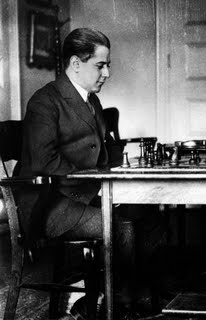
Until it finally sank in, I read books on chess and my hero was the Cuban chess master with the beautiful name, José Raúl Capablanca. I had a two-month chess rennaissance in 1966 when I was on board a slow Argentine ELMA (the Argentine merchant marine) Victory ship, the Rio Aguapey en route from Buenos Aires to Veracruz. As soon as the captain Guillermo Magliorini found out I played he summoned me every night to his quarters for a match. I think that we were pretty even so when I disembarked my pride was almost intact.
In the late 50s I would take the bus to downtown Mexico City to Calle Palma. Calle Palma had blocks and blocks of chess stores where I would stare at chess sets I could never afford to buy. Most of us, in those days would buy the cheap and hollow plastic pieces. We would fill them with sand to make them heavy and then we would glue on the bottoms the finest green felt we could find. The chess board was another problem. For years I had a foldable cardboard one but I finally was able to save enough to get a wooden one.
I often would go to Chapultepec Castle to feast my eyes on the most beautiful chess set I had ever seen. The black obsidian players were Moctezuma, Cuauhtemoc and the fierce Aztec warriors. The jade players were Cortez, his captains and his soldiers. The chess board consisted of inlaid squares of obsidian and jade. The set disappeared in the early 70s. In the mid 90s I returned to Mexico City and I was able to secure an interview with one of the castle’s curators. She told me that the set had never existed and that I must have been confused with some other museum.
Of late I have been thinking that I should buy a chess set and teach Rebecca. I am sure that her neurons would be able to accommodate more chess activity than her grandfather’s.
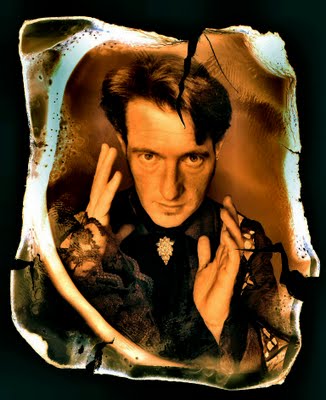
There is a story I read long ago about American photographer Edward Steichen. It seems he was near death. His housekeeper was watching him (broom in hand) and thinking that she should ask Steichen for some advice before the man died. “Mr. Steichen, my son wants to be a photographer. Would you have any pointers for him?” Visibly affected by the question, Steichen made a supreme effort to lift his head from his pillow and whispered, his voice cracking with emotion, “Don’t send him to school!”
In this day and age of the takeover of amateur (citizen) journalism and amateur (citizen) photojournalism I question the relevance of journalism schools, universities and technical institutes that have journalism courses. I would think that journalism is as dead as the uniqueness of the images found in Flickr and Facebook. Everybody had a Colt Peacemaker by the time the 19th century was coming to a close. Gunfighters became an endangered species and disappeared. Footage of Iranian demonstrations comes via cell phones on the BBC TV news channel. With the death of Avedon, Newton and Penn I can no longer discern individual photographic style. The new style of our 21st century modernity seems to be uniformity.
I teach photography at a couple of schools. I agonize as to my relevance as a teacher. I feel that unless I declare Time-like that Photography Is Dead I am fooling my students into a false promise of money and success in a field where the mantra is “free is the best price”.
I find comfort in the idea that school sometimes has its advantage. Around 1976 I was struggling to teach myself how to print colour negatives and slides in my darkroom. I postponed and postponed. One day my Rosemary said, “You are starting a course on colour printing at Ampro Photo Workshops on Monday.” I was paying to learn. I did my homework out of guilt. I learned how to print. School had provided me with a structure.
Most of my students can run circles around me with their knowledge of the inner workings of their DSLRs. They know all about white balance and the intelligent ordering and fixing up of their images with photo programs like Lightroom and Photoshop. I attempt to teach them lighting. This is something I am sure I know something about. But when you extend a class to several weeks what else can I possibly bring into the learning crucible?
I try to explain to my students how knowledge of photographers and artists of the past can inspire us to imitate, vary, improve, modify and better still they inspire us to inspire us. I tell them about photographer Bert Stern who pioneered the use of the white background and the concept that photographically, less is indeed more. I tell them that he “invented” cleavage lighting for Cosmopolitan.
In the end I am stuck with the frustration of trying to teach them in a ten class course the idea of conceptualizing a photograph. I borrowed a bit from photographer Minor White who wrote about the idea of pre-visualization. This involved looking at a scene, imagining it in one’s head and then taking a picture that expressed that image in the mind with some sort of near perfection in reality. Every time I take a picture it is almost as if every photographer (and artist, painter and sculptor) is put into a blender. I mix it all up and pour out my modification of all their ideas.
I know I can teach the lighting and some of the mechanics of picture taking. But how can you teach students the thought process?
For all my years as a photographer I had what I perceive as an advantage. This is that I think in three dimensions. All the photos on this blog involve the idea of objects that occupy space. They cast shadows, they weigh, they smell, they change with time.
In a short but pleasant chat with Emily Carr University of Art + Design, Dr. Ron Burnett yesterday he mentioned a word, perhaps a word of his invention which finally explains for me the concept that I am trying to grasp. This concept is the very one I want to transfer to my students. Dr Burnett improves upon the idea of three-dimensionality and its importance in conceptualizing images, with the word materiality. It is the materiality of things that a photographer manipulating images with Photoshop somehow misses. This process of beginning with objects and transferring them to the latent image of actual film is being lost as photographers manipulate penguins into being on the sands of the Sahara Desert.
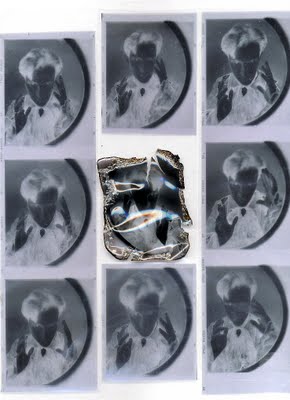
Dr. Burnett hints that painting and photography can only survive if both survive. My granddaughter Rebecca kept asking me if the paintings on the wall (at the recent Vancouver Art Gallery exhibition of Dutch painting) were indeed originals. As Dr. Burnett sees it she was asking me about their perceived reality. Were they indeed occupying space because they were three-dimensional? They had materiality. They were not photons on a computer monitor.
As an example I was assigned some years ago to photograph baritone Brett Polegato for a Vancouver Opera production of Mozart’s Don Giovanni. Those familiar with the opera know that this inveterate womanizer gets his deserved due and burns in hell in the end. I wanted to convey this idea of burning in hell. I was not given access to props, wigs or anything. I had Polegato in my studio wearing his street clothes.
So I came up with the concept and took 9 pictures (I did not need more) that were relatively tight portraits. I picked the best negative and lit it with a match. It burned beautifully and the cellouloid even cracked at the right place. The film had warped in the heat. I then scanned the result.
While a digital photographer might imitate my concept with Photoshop, it is the concept itself that (in my opinion) probably seems unlikely to be conceived by the photographer. You have to think in the materiality of things.
The Other Side of Two Dimensions
Dr. Ron Burnett's Blog
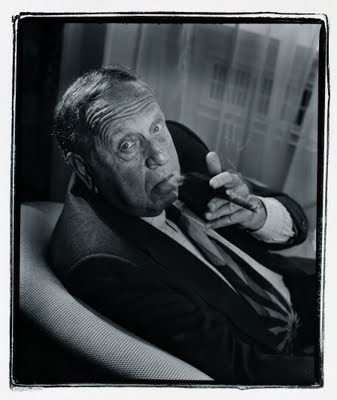
In his 1992 autobiography Flying Through the Seat of My Pants low-budget movie mogul Samuel Z. Arkoff wrote, “Thou shall not put too much money into any one picture. And with the money you do spend, put it on the screen; don’t waste it on the egos of actors or on nonsense that might appeal to some highbrow critics.”
Of my session with Mr. Arkoff at the Hotel Vancouver in May of 1991 I remember next to nothing except that he knew how to pose and I was not bothered by his cigar. At the time I smoked them. Arkoff and I compared notes on the differences between Montecristos and H Upmanns. I favoured the former and he was smoking the latter.
Of the 463 films he made I only saw one, Machine Gun Kelly with Charles Bronson. The reason for this apparent anomaly is that I had inherited from my mother a taste for films with good (and expensive!) actors. Joseph Cotten and Samuel Arkoff probably never met or worked in the same circles.
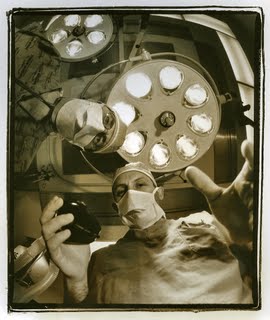
I was never a lover of B-movies unless they were Westerns (Colt .45 with Randolph Scott) or science fiction (This Island Earth). The first "horror" film I ever saw and one of my last, I saw with my father around 1951. It was Abbot and Costello Meet Frankestein. I was scared to death by the sudden appearance of Bela Lugosi's Dracula.
This South American who until now has never been able to stand Hollywood musicals (How can it be that perfectly sane actors suddenly begin to sing to each other? ) is suddenly enjoying a few. And most recently I went to listen to Stephen Sondheim talk about his plays were actors do just that, sing and talk. Perhaps Mr. Arkoff and I have some catching up. There are those 462 films I have not seen. There is one that I will never see that Mr. Arkoff never made. The film that was never made would have featured two naturals, two anesthetists, Tony and Igor. Arkoff’s film would have been called Going Under.
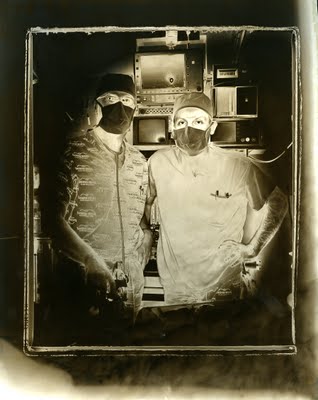
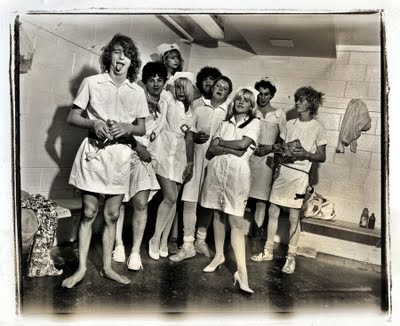
I first met John Armstrong (aka Buck Cherry) around 1979. I was one of the judges for a battle of the bands type contest at Gary Taylor’s Rock Room on Howe Street. I was no expert in rock like my In One Ear associate from Vancouver Magazine. Gary Taylor liked me because I was cheap. He could buy me for the night with Perrier while some of the other judges were paid in expensive booze and white powder.

I was not prepared for a band like the Modernettes. They featured a roly-poly young man with a sneer and an American Civil War kepi (the rebel kind), a tall blonde with legs from here to Dunsmuir called Mary Jo Kopechne (she liked to explain that both she and her namesake could not swim) and a non-stopping drummer called Jughead. This trio, plaid very loud and very off-key. I hated them. I never voted for them.
But they did grow on me and learned to appreciate their fast, furious and short tunes. They did for my ears what Colman’s did for my sinuses.
The first picture you see here I have a vague idea that it might have been around 1982 and that I took it at UBC. The Modernettes and Slow (that’s Anselmi the lead singer of Slow on the far left, then John followed by Mary Jo whose hair covers part of her face). These two bands were warm-up acts for the Cramps.
Sometime at the end of the 80s I suggested to John (he had wit and lots of knowledge gained from watching TV until all hours of the night after concerts and or reading lots of novels) that he purchase a Harris Tweed jacket, a shirt and tie and go to Charles Campbell (then editor of the Straight) and ask for a free-lance writing job. This paid off, and in short order John and I were off to interview and photograph Vincent Price and Dennis Hopper.
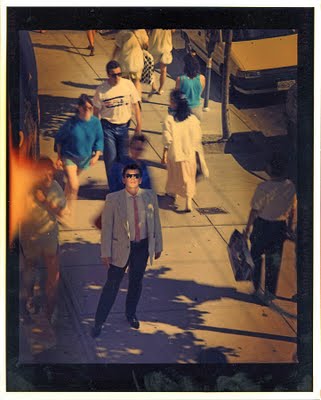
In the early 90s writer and friend John Lekich wrote an article about alternative medical practices. I was asked by art director Chris Dahl to not only take the pictures with colour negative but he expressly demanded I print them. If that was not enough he suggested (strongly) I only use mirrors for lighting. This particular shot of Armstrong I took on Robson. It had something to do with some sort of weird self-help. Writer Lekich was next to me on the top floor of a restaurant aiming the mirror. I had asked some friends to walk around Armstrong quickly.
It was all a pain in the neck. I hated printing the pictures. I wanted to punch the art director in the nose. Looking back at those days I now know it was all good fun. Fun has now been diluted to nothing and if I ran into Dahl on the street I would hug him.
Rebel Kind.
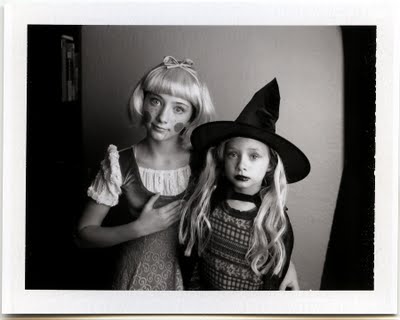
I hate Halloween.
I wrote those very same words in Halloween 2007. Both Halloweens, that one in 2007 and last night's, had a happy ending. The first one was courtesy of Tennessee Williams’ The Glass Menagerie and last night it was a production of Henrik Ibsen’s The Master Builder at the Telus Studio Theatre performed by my friend actor/writer C.C. (Chris) Humphreys.
In both occasions we did not have to stay at home and hand out candies and listen to doorbells, loud knocks and the incessant shouting, “Happy Halloween.” If I could I would be another Grinch.
And just like in that other Halloween, Rosemary and I stopped at the granddaughters’ to take their snaps before they went out trick or treating.
I make my formal request now, "Chris, plan some Richard Brinsley Sheridan for next Halloween. I don't want to stay home."

October 31, 1990
Haunted by Halloween
By ROBERTSON DAVIES
TORONTO -- Halloween deserves a house cleaning. Our strongly superstitious age needs Halloween, but cannot do anything with it in its present degenerate form.
Halloween has been thrust too much into the hands of children. Dressing children as ghosts and witches, and sending them out on the night of Oct. 31 to demand tribute from the neighbors, or perhaps to proffer collection boxes for a variety of more or less worthy charities, is contrary to the deeper meaning of Halloween. The old festival is not childish, nor associated with good works and community spirit.
The deeper meaning? What lingers today is a foggy recollection of the great Celtic festival of the Death of the Year. The Celts divided their year into the growing months and the resting months. The former began on the first of May with the Feast of Beltane, where the returning sun was welcomed by huge bonfires on the hills. The latter started after the harvest had been gathered. The waning of the sun was marked by the Feast of Samhain, a two-day affair, celebrated after sundown on Halloween and on All Saints' Day, Nov. 1.
It was the Christian Church, of course, that instituted the feast of All Saints. The church was crafty about adapting pagan celebrations to its own purposes, and when it set about its methodical substitution of Christianity for the old Celtic religion, it carefully noted that at Samhain the Celts remembered their ancestors and their heroes, and did them honor in a number of ceremonies, including, so the missionaries said (but the evidence of missionaries must always be carefully weighed), human sacrifice. How logical, then, that the old feast should serve the new faith and be-come a time when the saints were recalled on Nov. 1 and all the other faithful dead on the day that followed, called All Souls'?
If we were to take a new look at Halloween, what might we do? Surely revive the custom of giving some respectful heed to our forbears.
We of North America are not so likely to do this as are the peoples of the rest of the globe. Is it because of our driving ambition to do better than our parents? Like it or not, to reach middle age with less money or less prestige than our father had is somewhat to lose face. Stupid of course, when put like that, but who is prepared to argue that we are not stupid in several important ways?
Nevertheless, our forbears are deserving of tribute for one indisputable reason, if for no other: without them we should not be here. Let us recognize that we are not the ultimate triumph but rather we are beads on a string. Let us behave with decency to the beads that were strung before us, and hope modestly that the beads that come after us will not hold us of no account merely because we are dead.
Today and tomorrow are the proper days for such reflection. It need not detain us for more than a few minutes, but it should be sincere. A few gentle thoughts or even -- I hardly know how to put it without moving you to indignation or laughter -- a brief prayer would not come amiss, and might turn your thoughts in a fruitful direction.
There have always been people who give no regard to their forbears, and it was they who were thought in the days of the old Celtic religion to suffer on Halloween. That was the night when the spirits of the neglected or affronted dead took vengeance on their unworthy descendants. They were on the rampage as bats and owls, ghosts and bogles, and they were not always careful where their vengeance fell. To be out on Halloween was to run great risk of physical or psychological harm, for it was then that the underworld of chaos and death settled old scores.
Wise folk, long after Christianity ousted the Old Religion, kept indoors on the night of Samhain and followed tradition by trying to foresee the future. There are still people who remember bobbing for apples at Halloween parties. It is a method of divination now turned into a game. My father recalled that when he was a boy in rural Wales, girls used to drop molten lead into cold water on Halloween because the lead would surely take the form of the first letter of their true love's name and if it did so he would marry them.
Fortunes were told by "scrying," which was to see images in a basin of water (later a crystal). Soul cakes -- rather than shortbread -- were baked and given to the children who went "souling" from door to door -- the beginning of the modern trick-or-treat. By the 19th century, we can presume, it was safe to go outdoors.
Did I not speak earlier of this as a strongly superstitious age? Who can deny it, when fortune tellers of all sorts prosper as they have not done in 50 years, as sophisticated young business people resort to them, within a few yards of the great Market of Phantoms, Wall Street itself? Has there ever been such a brisk trade in crystals and tarot cards? Have wizards ever advertised so unequivocally in the very best publications?
There are laws almost everywhere against witchcraft but how often are they invoked? There are covens of liberated women who let it be known that they are witches but are anxious to have it understood that they are White Witches, who do no harm and simply get together to invoke the Great Mother, the supreme Nature Goddess, and eat a few vegetarian dishes. Their attitude shows the cast of mind that has gelded and trivialized Halloween.
The Great Mother, who is said to have anticipated the reign of the Great Father by several millennia, was, like Nature, not unremittingly benevolent. She had -- or should I say has -- an eerie, nasty side, and the rout of evil spirits on Halloween was only one of her ways of letting it be known. She had three natures -- Virgin, Consort and Hag; the Hag was rough and, in the form of children got up as witches, still makes a farcical appearance on Halloween.
What might we profitably do on Halloween? Look backward, and consider those who went before us. The road ahead is inevitably dark, but to see where we have been may offer unexpected hints about who we are, and where we should be heading. Triviality about the past leads certainly toward a trivial future.

Lt. Harry Brubaker: I’m a lawyer from Denver, Colorado.
Mike Forner: Judas, how'd you wind up in a smelly ditch in Korea?
Lt. Harry Brubaker: I was just asking myself that same question.
Bridges at Toko-Ri, 1954

I have much more time in my hands these days and instead of using it to read, to file photographs or perhaps find a way of fixing the ancient plumbing of our house I have been spending it in self-reflection. I have been observing the world around me and how I have changed (or not changed) in relation to it.
A little incident at the downtown coffee shop on lower Granville Street, Trees Organic Coffee, yesteday, brought lots of that self-reflection, nostalgia and memories of my past.
It was sometime around 1948 or 1949 (I was 6 or 7) when I accompanied my mother to a nearby ferretería (hardware store) on Hahuel Huapí Street around the corner from our house on Melián in Buenos Aires. There was something that I wanted and my mother pulled a very red and crisp peso bill (I think it was a ten peso one). She stretched it out and said to me, “Alex, what you want would take one of these and it is much too much money. I will not buy this for you until you learn the value of money.” I really did not have much of an idea of what money was and much less its value so my mother’s exercise in frugality was one I did not understand. I can still remember the sharp snap the bill made when she stretched it.
At Trees I offered to pay for my coffee and Bob Mercer’s (an ex editor but still friend of mine) mate. I produced a ten dollar bill and gave it to the cashier. Just like my mother had done in BA she held it by its sides and she stretched it out. I heard the snap. Then she told me, “This is a fake bill. Do you have another one?” I didn’t so Mercer paid. I felt saddened by the sudden loss of my ten dollars. Mercer tried to console me by explaining, “What you have in your pocket is a Canadian three-dollar bill. You see I paid the five fifty and added a tip to make it seven. Since you were going to pay for it, all you have really lost is the bill you have in your pocket which is now worth three dollars.”
I went home saddened by the event. As I struggle with the financially unstable profession of photography I have come to the conclusion that 61 years have elapsed since my mother told me I had to learn the value of money. It seems that not only have I yet to understand its value but I cannot even tell the real thing when I see it.
But not all was lost. I turned on the TV and Robert Osborne, the evening host of Turner Classics Movies, was announcing the next feature. It was the 1954 Mark Robson film, The Bridges at Toko-Ri with William Holden, Grace Kelly, Mickey Rooney and Frederick March.
The first and last time I had seen it was in 1955. I had been completely infatuated with Grace Kelly. I had been depressed by its grim, un-Hollywood ending. Even then, the film seemed bleak and the moments with Grace Kelly, too short.
I am happy to report that in this second viewing the film is grittier, it seems even more authentic and it is far bleaker than I had imagined it. The brilliant young lawyer, William Holden (married to Grace Kelly and the father of two beautiful little girls) was an efficient WWII navy flier who suddenly finds himself, a recalled naval reservist who has to fly (Grumman Panther jets) over the then misunderstood "police action" (the word war was never used at the time) in Korea. Holden is befriended by his carrier admiral, the father figure Frederick March, who adopts Holden in place of the two sons he lost in the previous war.
Until the end of the film you never get a glimpse of the enemy. The bombing and the strafing does not include enemy aircraft and the demolition of the bridges of the story does not show its human element. It would seem that by 1954 there was already a foreboding of future wars - a war where you pressed buttons to cause surgically sterile death and destruction. The beautiful dark blue F9F Panthers prefigured the idea of sending lone drones over Pakistan and southern Afghanistan.
Both the film version and James Michener’s book, end in a stinking irrigation farm ditch in North Korea. The pilot (Holden’s plane loses its fuel in a flak hit over the secondary bombing of an ammunition dump) and his would-be helicopter rescuers die in the mud as they are besieged the appearance of the enemy at last. The soldiers, who obviously do not plan to take prisoners shoot them. The film ends there and I immediately thought that the descendants of those soldiers are putting together Hyundais and LED TV flat screen TVs.
The Bridges at Toko-Ri, released two years after the first real adult western, High Noon, is in my mind the first real (American, at least) adult war film. It is a film that resonates more today that it did then. This is so because the “missions” of Afghanistan could be better equated to the “police action” of Korea and not to that war in Vietnam. In both Korea and in Afghanistan the ditches seem to be as real, as pointless and as grim.
When Holden questions Frederick March as to why he (the pilot) is fighting a war (that his wife does not understand), March answers, "It's a matter of distance; we do this because we're here; back home they're only doing just as you would be doing if you were there."

Just for a few minutes as I finished here I realized that the colour of those Panthers in The Bridges at Toko-Ri is the same colour as my favourite melancholy jazz album, Miles Davis’ Kind of Blue. Both the film and the album depress me. But it is a depression that leads to self-reflection and that is not entirely bad.
Argentine Nostalgia
Thursday, November 19, 2009

My mother kept several notebooks where she wrote love poems to the man in Manila she never married. Sometime in 1937, in a moment of impulsive fury she cast an opal ring he had given her into Manila Bay and she, her mother, sister and brother moved to Buenos Aires. My mother never let me forget that Dr. Andía, the man she never married had remained in that important corner of her heart and that my father had been a second choice. I never told her I felt like a rejected offspring of that second choice. She told me that love was action and doing and not false warmth. She rarely hugged me but she sacrificed most of her life to make enough money to send me to the best schools where I mostly squandered it by being a mediocre student who managed to cruise with not much effort. Rosemary and I had one of the more complete notebooks of poems beautifully bound in leather. The bulk of the poems is dedicated to Dr. Ramón Andía. But there is one poem that is not.
Argentine Nostalgia
I thought I’d never miss: -
The wide expanse of pasture of the pampas,
The lead gray skies & stratus clouds
The whistling, whining, violent “pamperos”,
The wet moist cold,
The hot damp heat,
The monotonous landscape
Bare of trees & bushes 7 human beings
Populated by lazy, cattle.
But I do,
And remember,
The balmy breezes of early spring,
The mauve of jacarandá trees in early fall,
The crisp, white frost of midwinter,
The golden yellow of the aroma in late spring
The pungent, acrid odor of the figs in midsummer.
I thought I’d never miss:
The untidy almacén at my corner
Overflowing with cellophane bags of capeletti & ravioli
And mounds of sacks of new potatoes,
Reeking of onions & “tipo Roquefort cheese”,
Of smoked ham & bacon hanging from hooks
Or:
The heated discussion of the Italian neighbours,
The chattering, singing & crying of their children,
The clatter of their plates & knives - they ate
In the patio & almost lived there,
Their plaintive singing of their summer land
And the merry quartets from Barbero & Rigoletto.
Or:
The austere grays & browns & blacks
That Porteños think proper to wear,
Their sober silence and quiet in public vehicles
The busy little sidewalk cafes under striped awnings,
The interminable wait for tram 35,
The long and never ending route it took,
But I do,
And remember:-
The exquisite taste and stark simplicity
That Porteños think proper for wear,
Their polite “permiso” as they sidled by you on colectivos
The gracious old-fashioned cadence of the
“Cuando” danced in a café.
The beautiful church on Juramento and Cabildo
I always watched out for out of the window of Tram 35
The expectation of getting to Mother’s flat,
At the end of the line,
And the warmth I’d get there!
Filomena de Irureta Goyena de Hayward
Nueva Rosita, Coahuila, Mexico
Dec 5, 1956.

The poem is not entirely truthful in relation to sober and polite Porteños. My mother had a beautiful body and the best legs I had ever seen until I met my wife Rosemary. But in Buenos Aires she always wore a girdle. She explained to me that the Argentine men who sidled by her as she rode the colectivo (small Buenos Aires buses) had the habit of pinching her bottom with regularity. This became impossible when she wore her pinching barrier. The pampero is a wonderful wind that comes from the pampas that smells of wet earth when it is about to rain in Buenos Aires. And almacén is usually a corner grocery store which in my mother's time (and mine) was run by Italians who spoke little Spanish. The man who owned the almacén half a block from our house was called Don Pascual. Above is a jacarandá blooming in Plaza de Mayo. The building behind is the Buenos Aires cathedral. Below middle is the only slide (I took it in 1965) that I could find of a colectivo. The building behind is the seat of the president of Argentina's power, la Casa Rosada. To the left of the colectivo and above the tall entrance to the Pink House is the balcony from which Perón and his wife Evita addressed los descamisados or the shirtless ones.

Below, right is a picture of La Redonda (The Round One) the church my mother would anticipate as she rode the Number 35 tram to her mother's flat. In one of those rare but appropriately symmetrical moments in my life I went to Mass there in 2004 with Rebecca and my godmother and first cousin Inesita O'Reilly Kuker. The Number 35 tram was long gone but there were plenty of colectivos that my mother could have ridden and looked out of the window.

More Argentine nostalgia
And more
And even more nostalgia
Argentine Nostalgia


Kyuquot, Essences & Plato's Cave Via Halsman, Sander & Stern
Wednesday, November 18, 2009

It was sometime in 1967 that I attended a concert of the Jefferson Airplane at Fillmore West in San Francisco. I had hair down to my shoulders but I was as straight as an arrow. It was at the concert that I first began to find connections between what I had learned from Ramón Xirau in Mexico City about philosophy and in particular about Plato in relation to the reality of everyday living. It was at this concert that I spotted a young woman sitting at a corner staring at a little cocktail glass of crème de menthe. She was staring, I quickly ascertained at the greenness of the liquid. I am sure that for her the green was to ti esti, or the equivalent in English from the Greek, that what it is. She was staring at (in her imagination) absolute green, or Plato’s idea of essence.
As I continued in my hobby of photography that year and began toying with the possibility of perhaps making money from it I had with me the inspiration of three photographers I admired. One was and is (he is very much alive) American Bert Stern. The other two were the Latvian Philippe Halsman and the German August Sander. I have always been attracted to their spare style and their respect for their subjects.
In February 1992 I traveled to the remote community of Kyuquot, BC on Vancouver Island. I had been dispatched to teach photography for a weekend to eager students who were members of the Kyuquot Native Tribe. That weekend became a blur in my memory and when I looked at the pictures of them this morning (I am writing yesterday’s blog today, Thursday, morning) all I saw were their smiles. There were lots of smiles. They were eager to learn.
Any one of those classes that I taught for the Emily Carr Outreach Program would have been a classic, “Today we are going to look at exposure and sharpness, tomorrow we will discuss the rules of composition.” Since this was before the digital revolution I took along Polaroid b+w instant 35mm slide film and a little motorized processor. My students could shoot one day and we could project the next day their results. It was fun.
Last night as I was going home from six hours of teaching The Contemporary Portrait Nude and Portraiture Through the Ages at Focal Point on 10th Avenue I was shocked to realize how teaching photography has changed (from my perspective).
In the nude class we have the most fantastic models (male and female) and we progress in how the nude has been seen not only in photography but in painting. Since our class is supposed to be contemporary we even had one segment where we bring in Yuliya a most interesting model that specializes in fetish. She holds a degree from Simon Fraser but in her spare time she sits on businessmen’s faces or presses her stiletto heels on their nether parts. The photo sessions in our class are tame by comparison but my students get to know a bit more than just the idea of a nude as simply a body sculpture and how parts of the body resemble dunes in the Sahara.
In the other class, as an example, we projected yesterday the students’ pictures of models that we dressed up (or undressed) to resemble paintings by El Greco, John Singer Sargent and photographs by Man Ray.
I finished the class by explaining that Bert Stern, in particular, had taught me (through his pictures) the idea of removing from a potential photograph all that was not necessary while retaining the essence of the person being photographed. This essence was and is that which without it the person loses his or her identity. As an example I cited Stern’s photograph of a business-suited Gary Cooper holding a Western Colt .45. The gun (and only just the gun) instantly made the man the troubled lawman of High Noon. I told my class how Halsman had almost pushed Humphrey Bogart into collapse by telling Bogart he did not want to take his picture as crook or as detective but as his essential self.
Of August Sander who reverently photographed the professions (both the elites and the poor down to the beggars) of Germany for fifty years (the first half of the 20th century) I told my class that rare in this 21st century was his ability to respect the humanity of his subjects even when his subjects were members of the Nazi Party or elements of the SS. Specially troubling but beautiful were portraits of Jews taken in the late 30s who in retrospect we know vanished soon after. For Sander the essence of his subjects was the fact that they were human.
I finished my class, not with an explanation of sharpness and exposure (I did delve on the idea of controlling contrast) but with a sketch on the board of Plato’s cave and an explanation of the chained men, unable to move from their stone bench, who saw "reality" projected (blurred and flickering like the fire between them and the opening to the cave at their back) on the wall in front of them. I told my students of the curious novel by José Saramago, La Caverna, where during the excavation of a mall in Lisbon, a cave is found with the remnants of charcoal, a stone bench and some chains…
 1. Eugene Leo
1. Eugene Leo2. Natalie Jack
3. Anita Jack
4. Kathy Williams
5. Marilyn Short
6. Robert John
7. Bonnie Jack
8. Nancy Gillette
9. Therese Smuith
10 Warren Short
11. Ruth Zand
12 Valerie Hansen
13 Velian Vincent
The smiles of my students in Kyuquot remind me of the simple and naïve world we all seemed to live in once and I now wonder how my new students will tackle the complexity of a world that seems to have forgotten the essences.
Addendum: I noticed the sweater I was wearing in the picture above. I remember that I had bought it at a discount store for under $10. It was Scottish wool and it had been knit in Scoland. Just a few weeks ago I photographed Rebecca in the fall garden with the same sweater here
Waiting For Godot, Bowler Hats, Irish Pipes & Morris Panych Behaves
Tuesday, November 17, 2009

Noël Coward’s diary entry for Saturday August 6, 1960 reads as follows:
...I have just read, very carefully, Waiting for Godot, and it is my considered opinion it is pretentious gibberish, without any claim of importance whatsoever. I know that it received great critical acclaim and I also know that it’s silly to go on saying how stupid critics are, but this really enrages me. It is nothing but phoney surrealism with occasional references to Christ and mankind. It has no form, no basic philosophy and absolutely no lucidity. It’s too conscious to be written off as mad. It’s just a waste of everybody’s time and it made me ashamed that such balls could be taken seriously for a moment…
-------------------------------------------------------------
To be frank I kind of agree with Coward and I have been bored to death the two times I saw this play. But there is one aspect of the play that always made me curious. Why is it that it always features Estragon and Vladimir wearing bowler hats? It seems that when Beckett was writing the play he had no idea of the two characters being tramps. But he is quoted as saying to French director and actor Roger Blin (who directed and acted in the first production of Waiting for Godot, on January 5, 1953) “The only thing I’m sure of is that they’re wearing bowlers.”
While researching this blog I further found out that a character in the play, Pozzo (played in the premiere showing of the play by Roger Blin) presents himself as a conceited landlord. He smokes a pipe, made by Kapp and Peterson, which are Dublin’s best known tobacconists. Their slogan was “The thinking man’s pipe,” which Pozzo refers to as briar but which Estragon calls a dudeen emphasizing the differences in their social standing. “dudeen” [Irish Gaelic dúidin, diminutive of dúd, stump, pipe] emphasizing the differences in their social standing.
 This above fact made me smile as I have written of my 10 Petersen pipes here! They were always my favourites in combination with Bell’s Three Nuns Pipe Tobacco (None Nicer!) I thought the long profile of the Petersen pipes made me look that much more sophisticated!
This above fact made me smile as I have written of my 10 Petersen pipes here! They were always my favourites in combination with Bell’s Three Nuns Pipe Tobacco (None Nicer!) I thought the long profile of the Petersen pipes made me look that much more sophisticated!The whole above stuff is but a prelude to an explanation of the photograph you see here which I took March 19, 2006 of theatre director (and actor and playwright) Morris Panych. He was directing Beckett’s Waiting for Godot for the Arts Club Theatre Company at the Stanley. The Straight had dispatched me to photograph him. I was given a few minutes, between rehearsals in the lobby of the Stanley. I had no idea what I was going to do even though I had brought my big camera and my studio lights. I was met by a lovely new publicist (4 or 5 months on the job), Nicole McLuckie who had bright red hair and a most pleasant demeanor. She must have been very nervous as dealing with Panych has never been an easy thing. I decided to go for broke and asked her if she could find me a bowler hat. This she did and I took what is one of my favourite photographs ever. And Panych was uncharacteristically smooth and pleasant.
We never did decide if McLuckie was Estragon or Vladimir. But having observed McLuckie’s considerable publicist skills in the last few years, I would assert there is more of a resemblance to the assertive Vladimir.
Snow White's Evil Queen Looks At Herself In The Mirror
Monday, November 16, 2009

Snow White’s evil queen looking at herself in a mirror is seen as the tragic flaw that initiates a series of events that result with Snow White living happily ever after.
There is a lesson here that I have wanted to teach Rebbeca. A few months ago I took a beautiful light jet print of Rebecca to Grant Simmons at Disc so that he could use it as reference for the scan, one of four that would result in my latest promotion attempt with postcards. Grant looked at the print and said, “I can do a better job than that. Leave that print behind and I will make a new one. You will see the difference.” Rebecca was bothered as we left by Simmons’ cocky faith in himself. Rebecca saw this as a flaw. She said to me, “He’s full of himself.” I was really unable to explain that when one is an artist or one has an artistic temperament the only (when money is scarce) encouragement one can have to keep at it is a faith in one’s ability. “If you think you are the best,” I told Rebecca, “you are better for it.” She was not convinced.

I did return to pick up Grant Simmons’ version of the Rebecca picture and the difference, while subtle, was overwhelming for those of us who know about correct skin tones and the keeping of texture and detail in very light areas. The print was superb. Grant Simmons is, I believe the best drum scanner in the business and his use of Photoshop is never noticed, it is that good.
Snow White’s Queen, is a beautiful woman who begins to have doubts of her beauty. She must know that she is the most beautiful. This “flaw” affects models, dancers and, yes, photographers. We must know that we are good. In some cases it is not important to be told so. Deep inside, we must know by ourselves.
Vancouver does not understand sustainable excellence. To be exciting you have to be a dazzling and short-lived shooting star. I remember the years of struggle that Christopher Gaze went through before he made his Bard on the Beach the success it is today. This success is now taken for granted by many and no hats are taken off to salute the man’s excellence, talent and perseverance.
There are some who tell me they like this blog. They tell me they like something I wrote. For someone who is a photographer that is a very good thing to be told. To be told that the writing is okay. But is seems to me that the photographs are taken for granted. A couple of years ago someone that I don’t know sent a contact submission through this blog’s parent web page that read, “Today’s photograph of Rebecca is ugly.” I felt hurt and indignant that someone would spend the time to send me such a message. Now I am beginning to warm up to it. It means that someone was noticing the pictures.

I am particularly proud (and I will have to explain to Rebecca that being proud of what one does well beats false modesty), of today’s black and white portrait. I took it for the inside of the Georgia Straight in 2005. I had been commissioned to shoot the cover which was about Ballet BC’s second mounting of its popular and racy Carmen. For the cover I used a ring flash which was positioned crooked to get that neon/ring look on the side. This happens because the camera's wide angle lens "reads" or sees the edge of the flash. The folks at the Straight could not understand it so they cropped it out.
 To make things worse the dancers arrived late and had to go early. Suddenly not only did I have to shoot a cover but I had to take an inside shot that looked different. I removed the ring flash and used one low open flash fitted with a honeycomb grid that narrows the light. I took the pictures in a hurry with a very slow shutter. In spite of the stress I was satisfied with the result. The look of the picture resembles the avant-garde of the late 20s. It reminds me of a photograph taken by German photographer Herbert Bayer in 1932, above, left. I was very happy even though I didn’t get a boo from anybody. I will have to explain to Rebecca, what counts is that one knows that one took a good picture. I am proud of it. I don’t need a mirror to know that.
To make things worse the dancers arrived late and had to go early. Suddenly not only did I have to shoot a cover but I had to take an inside shot that looked different. I removed the ring flash and used one low open flash fitted with a honeycomb grid that narrows the light. I took the pictures in a hurry with a very slow shutter. In spite of the stress I was satisfied with the result. The look of the picture resembles the avant-garde of the late 20s. It reminds me of a photograph taken by German photographer Herbert Bayer in 1932, above, left. I was very happy even though I didn’t get a boo from anybody. I will have to explain to Rebecca, what counts is that one knows that one took a good picture. I am proud of it. I don’t need a mirror to know that.From left to right, Acacia Schachte, Edmond Kilpatrick, Sandrine Cassini.
Ballet BC, Seriously Funny (Donald Sales) & Funny But Serious (Simone Orlando)
Sunday, November 15, 2009

On Saturday night my granddaughters and I went to the Vancouver Dance Centre for a performance of Ballet BC's Surfacing in collaboration with the Arts Umbrella Graduate Program. It was sold out so we returned home in the rain. The silence and the disappointment in the car were palpable. Sylvain Senez, the rehearsal director, with a big smile on his face, had told me, “Why don’t you come to the 2pm matinee on Sunday?”
I was not able to arrange to bring the disappointed granddaughters but I did manage to get a ticket and I even sat where I like to sit best, centre, front seat with my feet firmly planted on the dance floor! A wonderful springy floor for which the now Florentine yoga master Cornelius Fischer-Credo helped design.
I sat next to a long-time dance enthusiast and dancer, Betty Kovacs whom I had not seen since I last photographed her around 1980. Part of her support of the dance community involves hosting in her house Ballet BC dancers who come from abroad. They stay with Kovacs until they find their bearings. She is also President of the Vancouver Ballet Society.

While I am sure that many of the best of Vancouver’s choreographers would have attended the opening on Friday evening and the sold out performance on Saturday night I did spot Alison Denham, Judith Garay and Jennifer Mascall. They were there for the same reason I was, to see what Ballet BC’s interim Artistic Director, Emily Molnar (right) had up her sleeve.
To begin with most in the dance community in Vancouver know that Artemis Gordon’s Arts Umbrella dance program provides its students with the dream of someday, perhaps, graduating to the ranks of Ballet BC and other dance companies of renown. There were 15 Arts Umbrella dancers mingling, almost seamlessly with their Ballet BC professionals. The program did not mention that four in the ranks of Ballet BC are graduates from Gordon’s program. They were Connor Gnam (above, left), Alex Parrett, Alyson Fretz and Alexis Fletcher.
The afternoon program consisted of four works by four different and local choreographers, Joe Laughlin, Simone Orlando (a Ballet BC choreographer and dancer), Donald Sales (a Ballet BC choreographer and dancer) and Rob Kitsos.
On Wings, Joe Laughlin fed my almost potato chip craving for some classical en pointe walking which I sorely miss when I watch modern dance. And, of course, some Alexander Scriabin. The world needs more Alexander Scriabin. There is a lot to be said for modern dance, which I really love, but sometimes I need to experience the grace of those classically beautiful moves that are ballet and the reason why ballet, be it classical or modern, will always have a niche in contemporary dance. I am glad that Molnar had this on the program. It was my wife Rosemary who said to me when Molnar was named the interim artistic director, “Emily is going to eliminate all that classical ballet and give us only modern dance. She will fail if she does that.”

The last segment was Rob Kitsos’ Regression Line which featured very loud heavy metal/punk type music by Brooklyn’s Dub Trio. For me the saviour of the piece was the brutal performance (full of expression on her face she can change from point shoes, to pouts and sports shoes and fatigues with no problem) of the real star of Ballet BC (besides that classical ballerina Makaila Wallace) Alexis Fletcher, seen here on the left. Like her former Ballet BC dancer mate and fellow Arts Umbrella graduate, Acacia Schachte (who dances for New York’s Cedar Lake Contemporary Ballet) she has a style that is all her own. She stands out. She is not your typical cookie cutter clone that graduates from so many other ballet and dance schools.
Since I am no dance critic I will gently suggest to Emily Molnar that she might want to plan in the future to bring in a couple of our best city choreographers who could progress with Kitsos’contemporary vision. Shay Kuebler (choreographer and dancer) and Amber Funk Barton (another Arts Umbrella alumnus) both have incorporated modern dance to hip hop and by fusing together the two, have come up with a dance form that is grueling, contemporary, and exciting. If Molnar is able to secure that needed funding, Jane Coop would have polished off that Scriabin sonata with aplomb and I know of a few musicians who could have adapted that Bach double violin concerto to two violins and a cello. Live music can make such an intimate dance program that much more intimate.

The two middle pieces were the ones that I really liked. I liked them because more and more I see so little humour in modern dance. In Simone Orlando’s Doppeling, John Sebastian Bach competes with Prince Valiant. It ruined my wish of seeing Arts Umbrella dancer Alexander Burton, see above, with Emily Molnar on the left and Artemis Gordon on the right), show me what he can do with so much passion. Orlando put Prince Valiant wigs on everybody, males and females and had me seriously trying to figure out who was whom and if I was supposed to laugh or not! I decided to be less serious and just enjoyed myself. It is so pleasantly surprising to see how much humour Orlando hides behind her serious face.

Donald Sales’ (seen in picture, right, with Simone Orlando and centre, composer Tobin Stokes whose score was used for John Alleyne's ballet A Streetcar Named Desire) Long Story Short gave me what I had come to see (besides, Alexis Fletcher, Connor Gnam and Alexander Burton) and this was the newest member of Ballet BC, Alyson Fretz. I had first seen here some five years ago telling my granddaughter Rebecca to not be distracted in a beginning ballet class. Alyson Fretz (seen below sitting with Alex Parrett standing behind her and with Arts Umbrella dancer who also helped my Rebecca pay attention, Caroline Kirkpatrick) was one of Andrea Hodge’s (ex Ballet BC dancer and dance instructor at Arts Umbrella) helpers. I have watched her grow from a little girl to the strong and muscular dancer of today (Alexis Fletcher, watch your back!). And this piece with lots of humor, lots of classy Donald Sales humor) also allowed me to observe Connor Gnam’s rare ability (one rare in so many ballet dancers) to express emotion not only with dance moves but with facial expression.

One very pleasant surprise for me was that other new Ballet BC dancer Gilbert Small, who is very black, very talented, very muscular and fun to watch.
When I was waiting for the performance to begin ( I had arrived early to make sure I could buy a ticket) I spotted that other Ballet Boy from Arts Umbrella, Jed Duifhuis. I asked him, “Am I going to enjoy this?” With a big smile (he is normally stone-faced) he answered, “We are having fun so you are going to have fun.”
First off there he was picking up prima ballerina Makaila Wallace and I wondered what it was like for the “student” to be on stage with such a star. Wonderful and fun, I am sure.
Transubstantiating Into HTML
Saturday, November 14, 2009

I think that the worst fact about good times is that we rarely realize that they are indeed good times. At least that has been the case for me. Looking back at going in a private jet, a Cessna Citation, to León, Guanajuato for a magazine to photograph a story on a Canadian pioneer flyer living in San Miguel Allende, I now know that for contemporary photographers, that would simply not happen. The magazine would find a photographer in San Miguel and instruct her to take some quick ones and send them back via e-mail.
In my files I have portraits of many acting and directing luminaries of film. As an example I am most proud of my medium format camera, and studio lights portrait of Werner Herzog. At the time of my picture he had come to Vancouver sponsored by the Goethe Institute in Vancouver. The institute is long gone from Vancouver and directors, actors, authors are now interviewed from their home (meaning on the phone) and some less that honest publications hide the fact that many of those interviews are question-and-answer ones via email.
Saturday was such a melancholy one, (besides the fact that it was visually gray and dreary) that I postponed the writing of Saturday’s blog to today. Today, Sunday, brought a scary NY Times Magazine that has articles and articles about how our life has changed and is changing.
Perhaps the most depressing of the articles is a review of Harold Evans’ My Paper Chase- True Stories of Vanished Times in the NY Times Book Review. The review is headed by : When Type Was Poured Hot – In his new memoir, Harold Evans recalls an exuberant run into 20th–century journalism.
By the random nature of looking for DVD films at the Main Branch of the Vancouver Public Library I found a film called Edges of the Lord (the name becomes significant at the end of the film) directed by an unknown (for me) Yurek Bogayevicz about life in a little village in Poland during the brutal occupation of the Wehrmacht and the transporting of Jews in trains to their final solution. The film has the surprising casting of Willem Dafoe as the chain-smoking village priest and a string of child actors that is extraordinary. The film is rated R and Rebecca pointed this out to me. I took my chances and I think I was right in that the film (“I would not want to see it again, it was so depressing,” Rebecca told me.)had the three of us glued to the antique Sony Trinitron TV.
The realism of a young boy shooting an older young man who is systematically going through the possessions of Jews who managed to jump out of a slowing train, before killing them or handing them over to the Germans was brutal. Rebecca understood. I don’t think Lauren (7) did. But then when the film ended she said, “That was a good movie.”
The final scene has the four children being given their first communion by a most understanding Dafoe. When time comes to slip the wafer host into the mouth of our little heroic protagonist (a Jew, told by his parents, before he was sent to the village, to mimic Catholicism for his survival) he shows the boy that the wafer is not the round blessed one, the body of Christ, but the unblessed edges removed by the priest when making them. He is in cahoots with the boy and one religion respects the other.
I understood and when the appropriate time comes in the next few weeks I will have to explain to Rebecca (who will never have a first communion as her grandfather once did) what it is that transubstantiation is supposed to be. These mysteries, complex mysteries that they are, believe in them or not, bring in a level of complexity into one’s thought that will enrich one’s life.
A little boy, younger than our heroic Jewish protagonist wills himself to join a train going to his final destination. He is not Jewish. He is a fervent little Catholic boy who the director makes into a little Christ who feels he has been left alone by his father and willingly then goes towards his death.
Perhaps Rebecca will not see the film again. But once I explaina to her what was going on I hold my hopes that she will change her mind.
There is no more hot metal type, and journalism as I knew it is mostly gone. A memory of it is all we need to bring back a complexity in life that could not be simplified into HTML.
The Armenian In A Kilt
Friday, November 13, 2009

It was in 1965 (I have a mental block for the month of the year or the day) when the phone rang at the retired U-boat officer’s pension. It was for me. A man with a crisp British accent said, “Alexander your old man kicked the bucket yesterday. He died on the street and was taken to the hospital by vigilante (cop). You have to go to the police station to sign some documents. I terribly sorry.” The man with the crisp British accent was an Armenian who had worn the kilt of the Black Watch in WW-I. His name was Leo Mahjdoubian and we all called him Uncle Leo even though he wasn’t our uncle.
For about a year, I had been going to lunch at his San Isidro home on Sundays. The food prepared by his wife Helen (who looked like a cross between Maria Callas and Yvonne de Carlo) was a treat from the humdrum (and even terrible) Argentine Navy barracks food. We would sit at the table accompanied by Leo’s two sons Julian and Leslie and friends. From the very beginning three separate pepper mills caught my eye. It seemed that each one had pepper from a different area of India and Madagascar. The meal started with a salad followed by some sort of pasta and then a huge roast beef with potatoes and Yorkshire pudding. Before dessert we had soup which at the time was an Argentine custom. The idea was that if soup were very well prepared you would have room for it between a meal and dessert.

The men were pushed upstairs for a siesta. At about four we were awakened and we went down to a high tea to die for.
During my stay in Buenos Aires Uncle Leo always asked me if I needed any money. He would say, “I made lots of money with my assurance company so if you need anything, just ask.” I felt guilty about his hospitality so when possible I would show up at the Sunday lunches with a large blue can of Edgeworth pipe tobacco. We both smoked a
pipe and Edgeworth was my favourite brand. It was impossible to get it in Argentina but the officers of the US Navy for whom I worked as a translator provided we with some little benefits.

After World War I, Leo had decided to move to Buenos Aires. It may have been around the beginning of the 20s. At the time my grandfather Harry and grandmother Ellen lived in the Province of Córdoba. Harry had made good money working for a shipping company. He had moved from Manchester to Buenos Aires at the beginning of the 20th century. He came over with his first son Harry. In Argentina Harry and Ellen had five more children including my father. My guess is that in the mid 20s Harry had a heart attack and Ellen found herself a widow with six children. She moved to Buenos Aires and started a bed and breakfast (a glorified pension). Two boarders were to become important in my life and in the rest of the Hayward clan. It was at Ellen’s pension that Leo finally settled in as well as James Blew. James married my youngest aunt, Aunt Lilia. Leo had an easy going manner and he soon became an adopted member of the family. I believe that in later years Leo somehow was the family financier who might have even helped pay some of my father’s and my Cousin Robert Hayward’s gambling debts. I am only guessing this since anybody who could confirm it is long dead.
Before Uncle Leo died in the late 80s he sent me a photograph of my grandmother Ellen (Ellen Carter). It came with a backing that had a dedication by her. For about 10 years I misplaced this photograph. I found it yesterday filed with some of my self-portraits. The other picture here is of Ellen and her husband Harry.

The only grandparent I ever met was my mother’s mother so finding this photograph and remembering the Hayward side of my family gave me some comfort and nostalgia for those three-pepper mill days.
Harlequins, Masks, Musketeers & Brazilian Un-hirsute Primitivism
Thursday, November 12, 2009

Association takes one on strange paths. That latest path began this afternoon when I was on my way to pick up Rosemary from her physiotherapy (for her mending broken ankle) at the Vancouver General Hospital. Radio 1, CBC was running a story on the Jonestown Massacre of November 18, 1978. I was listening to the events that led to the shooting of US Congressman Leo Ryan and five other on the tarmac of the Port Kaituma airstrip. I was so distracted I kept driving for a few more blocks on 12th Avenue before I realized my mistake. I was never really able to ask my friend, photographer and model Nina Gouveia about it. She was born in Georgetown, British Guiana (now Guyana). She is the only person, besides my life insurance agent, Winston Miller that I know that came from that remote little country in the bulge of South America.
Africa, via Haiti, not Guiana was on my mind most of the morning. Rosemary and I had caught, the night before, a wonderful documentary/trailer on the 1967 Peter Grenville film, The Comedians, based on the previous year’s novel by the same name written by Graham Greene. The novel was set in Haiti under the scary rule of François “Papa Doc” Duvalier and his secret police the Tonton Macoute. The film features Elizabeth Taylor, Richard Burton, Alec Guinness, Lillian Gish, Peter Ustinov and the very funny man (playing a very serious part) Paul Ford whom I remembered as the officer Sergeant Bilko (the Phil Silvers Show) bullied and mentally (and sometimes physically) ran over with his constant schemes.

The wonderful trailer was narrated by a youthful Richard Burton with running comments by Alec Guiness, Lilian Gish and Peter Glenville. Burton explained that by the time the film was being made the sitution in Haiti had so deteriorated that they had to look for another location. That location was the former West African French colony called by then The Republic of Dahomey and is now the Republic of Benin. They imported voodoo experts from Haiti to make sure everything looked authentic. While watching all this I thought of Picasso’s African Period (1907- 1909 which came after his Harlequin Period which had ended with his Le Mort d'Arlequin in 1905) and how it had inspired other artists to pursue African masks and Primitivism. Among the artists was Man Ray.

The first painting that Picasso had finished that was attributed to his new interest was his Les Demoiselles d’Avignon. The title can be misleading as d’Avignon was the most famous street in Picasso’s Barcelona as it was the location of a famous brotherl. The two “professionals" on the right seem to be wearing masks or perhaps they were a preview of Picasso’s journey towards Cubism.
By the time I brought Rosemary home I was determined to find a negative of a handsome black male dancer I had photographed for the Straight who had brought the concept of African primitivism to his choreography. I could not remember his name. But I got lucky. On the pile of stuff (which I have been clearing now for three days) next to the left of my scanner and on the floor I found a copy of the Georgia Straight.

It featured a picture that I had taken of dancer Cori Caulfield (in a most primitive pose of Eve biting on that apple) for the September 6-13, 2001 issue. This was the only real nude of mine that the Straight ever published.I convinced them that the crotch shadow was indeed a shadow as Caulfield at the time was under the influence of Brazilian un-hirsute primitivism. On another page I found my African (but Jamacan born) Ran Hyman. I ran to my dancer files and looked under H. There was nothing! He was filed under Ran.

I enclose here a picture of Guayanan (Guianan?) Nina Gouveia, that many of you have seen here. It is here for one reason. Just check out that skull. It is the same one. It was owned by my Argentine friends and Nora Patrich and Juan Manuel Sanchez. I never got to ask them how they had managed to buy that Picasso from his Musketeer period.
Call Of The Wild - Horses
Wednesday, November 11, 2009

In all my years as a freelancer in Vancouver weekends were really no different from weekdays. Then there are the perceived seasons. Every time I run into someone who asks me, “How was your summer?” I either answer sarcastically or I don’t answer at all. What is seen as sarcastic is when I explain that since I work when I can, I don’t necessarily have summer holidays. Summer can be just like any other season. Sometimes I cite that beautiful moment in the Robert Redford film version of F. Scott Fitzgerald’s Great Gatsby. Redford (in white slacks) and someone else are walking on the side of swimming pool. It is a brilliant and sunny afternoon. One of them says to the other something like, “It was a fine summer.”
For a freelancer I think that every day is a scary Monday and more so now with a decline in the magazine business and the resulting decline in the need for photographs. But I have to admit that weekends are now weekends for me. Saturdays are the days when Rebecca and Lauren spend the day with us. I anticipate their coming days in advance and I feel a bit on the sad side when I drive them and their mother home on Saturday nights. Mondays are now special, too (and less scary) as we take care of the kidsin the afternoon. I pick them up at school and cook a quick lunch for them. Hilary shows up later for dinner.

This last Monday I took Rebecca and Lauren to the main branch of the Vancouver Public Library, Both girls are feeling comfortable with the place and Lauren who has learned to read in English in the last weeks (she is in French Immersion) is able to find books and sit at the small tables and make her selections to borrow. Rebecca sits on the floor and looks at her choices. She loses track of time. I found a 2000 film version of Jack London’s Call of the Wild. I knew I wanted the girls to see it. But I also knew I had my own reason. The lead actor is Italian born actor Nick Mancuso whom I met in Vancouver some years back. After dinner (Rosemary had to work with her laptop) the girls, Hilary and I watched the film which was truer to the novel than the 1935 version with Clark Gable in which the whole plot revolves on Gable running into Loretta Young in the frozen wilderness and the dangerous thaw that follows. At first Rebecca wanted to go home. She was soon drawn in by the beautiful dog, Buck. I made it like I was being bored and that I was going to turn it all off. Rebecca knew I was kidding. It was an enjoyable evening and when I delivered them home it felt like a Saturday night.

Today Rosemary and I pollarded the hawthorn tree in the front and even though I wore gloves I got many nasty thorn punctures. I spent the rest of the day trying to get rid of the pile of photographs, negatives and slides that perennially occupy the floor on the left of my computer and scanner. No matter how I hard I try, there is always a pile. The problem is that I find long lost stuff in it. Today I found a beautiful print of my grandmother Ellen Carter (sent to me by my uncle Leo Mahdjubian about 17 years ago) which I had lost for about 6. I also found a set of b+w negatives that included some of Rebecca and Lauren riding some brooms that they converted to horses with cloth heads and sewn-on buttons for eyes.
When I found them I became melancholy. It was Wednesday but it felt like Saturday or Monday. I believe I must have taken the photographs last summer.
Jay Gatsby: Summer's almost over. It's sad, isn't it? Makes you want to - I don't know - reach out and hold it back.
Nick Carraway: There'll be other summers.
For me there was last summer with the broom horses, this summer, and, I hope Nick is right and that there will be more summers to come.
Triremes - A Kriegsmarine Submariner & A Leaky Bed
Tuesday, November 10, 2009

Honest blogs can be embarrassing sometimes. But then I believe that within limits a blog is a web log. And a web log is a digital diary. If I wanted to stress this idea I would begin every day’s blog with that ever so quaint Dear Diary, …
Sometime in the mid 60s I was a room boarder in a home owned by a retired U-boat man and his wife. I was in the Argentine navy and because of my English I was spared the horror of a small destroyer bobbing and yawing in the South Atlantic and had the privilege of a desk job and an Irish/Argentine secretary. I also had the choice of living in barracks and be subjected to vicious petty corporals who liked to play soldiers in earnest or I could opt to renting a room. I chose the latter. To pay for the room I worked as a waiter in a bar in the Boca on weekends.
I was 22 years old.
This is something the submariner’s wife could not understand. She would get angry at me when I had uncontrolled nighttime fluid emissions and I would “dirty” her pristine sheets. I tried to explain to her that I could not control my nighttime subconscious. So she insisted I sleep with a towel under me and over me. When I started getting dreams involving the Gestapo I decided to bid the submariner goodbye.
Now at age 67 when I walk on Granville on the odd late evening (something I do not do with any regularity) I do not look at the noisy bars (the noise has to make up for the lack of smoke or perhaps noise used to be dissipated by tobacco smoke) with any kind of jealousy or longing. I do not wish to be young and be looking for a woman or a partner or someone I may want to live with or marry. That is in my past. Perhaps the only advantage of youth that I am truly jealous of is that idea of falling in love, of even falling in love for the first time.

Time dulls all that and I don’t see myself dumping Rosemary, selling the house and buying a brand new Maserati to try to capture a lost youth. The Maserati I still own, is rusting in the garage and there is no way I will bring back my pipes. I would feel like that Playboy guy. He has no idea of what it is to have grace in old age and to make an unburdensome exit. Besides I can see at least one bed towel in my future as the body inevitably lets go of controls.
All this is but a prelude. It is an overture (if I am going to be repetitive about all this). It is setting up the reason for posting these two pictures here. There would be other pictures but there are self-imposed restraints that prevent me from showing you that not only does Keely have a face to launch a fleet of triremes but a body that in water would have prevented that Eureka moment for Archimedes who would have sunk into his bath with a heart seizure.
We have had Keely twice as one of our nude models at Focal Point. The first time was last year. She did not have a bank of tattoos all over her body. She has only one on her ankle (away from other more relevant areas) and would you guess that it has a saying in Spanish? It is something about the fact that if you don’t dare you won’t get anywhere.
It is my premise here that when one has arthritic pinkies (my case at the moment), a sore elbow (result of having broken it a couple of years ago) and when sustainability is simply, and, alas, only, being able to stay in bed in the morning, with some measure of controllable discomfort, in spite of having to go to the bathroom, any opinions I may have about the fair sex must be purely objective, with no vestige of desire or anything else.
This is comforting in many ways. It means that I may just approach Keely in some future project that will help me sustain my interest in this momentarily unsustainable profession of mine which is photography.
Sam Sullivan's Project & The Project
Monday, November 09, 2009

Two events on the same day, last Thursday, November 5 left me with thoughts running around my head like cockroaches on a kitchen counter in the middle of the night in the tropics when one turns on the light. The activity was brutal.
At first one would think that former Vancouver city mayor Sam Sullivan’s unveiling of his Global Civic Policy Society at the Pan Pacific Hotel Crystal Ballroom would have nothing in common with the Solo Collective, Aaron Bushkowsky’s play The Project (directed by Rachel Peaks) which opened Thursday night at Performance Works on Granville Island.
The venues were different, the audience was different, the food was better (Sam had a better budget than the Solo Collective which was celebrating its tenth year of existence and had a modest table with goodies) but in the end it was a similarity in language that stuck out for me. Both events showcased the failure of language be it through repetition or through a false projection of relevant and instant intimacy.
Sitting between the lovely, refined and ever so much fun Leila Getz and Martha Lou Henley at the Crystal Ballroom of the Pan Pacific I heard host Mike Harcourt introduce UBC luminaries on the environment, density and other relevant urban affairs give short talks on Sam Sullivan’s organization which received a five hundred thousand dollar contribution from Charles Annenberg Weingarten and the Annenberg Foundation and from local philanthropists. It is Sullivan’s idea (based on practical experience) that more can be achieved to save our city, region and planet not through or within politics but by intelligent advocacy run by experts. I spotted such experts as former Councilor Gordon Price and urbanist Ray Spaxman. I was most pleased to see that Sullivan had taken some of the council from his Philosopher-King-mentor, Abraham Rogatnick and has brought into the fold of Global Civic, the gentle architect Bruno Freschi. With a bit of Sullivan's passion (with a bit of help from his wife Lynn Zanatta, picture above) the venture might succeed.
Had I had a golf counter in hand I would probably have suffered finger damage clicking the times I heard the words sustainability, affordability, peak oil, green, livability, global warming, carbon dioxide emissions, eco-density, and the expression, “our cars will grind to a halt.” It would seem that the very issues that are so important to our future wellbeing are defined by words, so often used, that they harmlessly bounce off our brain like Darfur, ethnic cleansing and pandemic.
At Performance Works The Project began with actress Sarah Rodgers mimicking in a simulated TV monologue those Saturday afternoon TV programs that my granddaughter Rebecca loves where Canadian celebrities appeal to our wallets by showing us starving children in darkest Africa. The only difference here was that the more Rogers put emotion into her delivery the more the crowd around me laughed. I could not understand why. It took me a while to get it. The whole play is populated by characters who talk in made-for-television cliché. While watching CNN’s Larry King Live I can only take a few minutes before his “instant” and “intimate” rapport with his subjects disgusts me into switching channels. Somehow, in the theatre I found it (eventually) very funny and I laughed with the rest. My Rosemary resisted, but she finally succumbed to the play and the excellent actors. Andrew McNee as Fred the famous (in the play) documentary maker was so perfectly believable I would have purchased a used clunker from him on the spot. Lindsey Angell (see, below, left) was so spot on as the really smart but paradoxically vacant Hollywood blonde that I felt sorry for her at times but marveled at her ability to come back in others. Alvin Sanders shifted from being the typical corrupt Dark Africa bureaucrat to a scary guerrilla leader (the ones that command others to cut off limbs) that I would have put my grandchildren to sleep easily by pointing at a true bogey man. The play came closer than the earlier lunch to showing me why nothing seems to ever get done in spite of all the talk.

Both events showed me that the way to our hearts and pocketbooks, if we are going to see any positive change is through the intelligent manipulation of language. The play, which so many might see as a comedy produced in me a realization, a catharsis of sorts on how language has deteriorated. Would it be possible for Franklin Roosevelt to affect us with his “Fireside Chats” in our present world? Would they be Twitterable? Will Sullivan’s Global Civic Policy Society achieve results by only circumventing politics?
I would think that Bushkowsky’s play points in the direction that the language of intimacy is at a crossroads. Intimacy has to be earned with time. There can be no (realistically) shining light on the road to Damascus while waiting in line for that Americano at Starbucks.
I feel that advocacy has taken away from us that ever so useful word gay so much in the vocabulary of that exquisitely funny and intelligent (and gay) Noel Coward. I feel the same way about those words I heard at the Pan Pacific luncheon. Sustainability for me has always meant to keep something up which at my age is mostly a pipe dream. We need to find new words to get that audience to listen to us.
I would seem to me that Sam Sullivan might just want to hire Aaron Bushkowsky and other local plawrights to help him. We only have to look in the direction of the Czech Republic to realize that playwrights can change history. I am sure that Voltaire would agree.
Addendum: Sustain has a Latin root sustinēre. It is curious that the Spanish who like to keep their language free, when possible, of Anglicisms and Gallicisms eschew brassiere and opt for the more Latin sostén. It would be nice to see such green ads as:
I dreamt I was far more sustainable in my Maidenform bra.
High-Strung - Shadow/Highlight
Sunday, November 08, 2009

For the last couple of years I have been trying to nail down the difference in appearance between digitally taken photographs and those exposed on film. I use the expression digitally taken as, particularly in my case, when my photographs are reproduced here, in magazines, newspapers and brochures those film images have to be digitized. I use an Epson V-700 scanner that came my way via the generosity of Georgia Straight editor, Charlie Smith. I scan my b+w negatives (old colour negatives), transparencies (35mm ones taken with my Nikons and 6x7 cm taken with my Mamiya RB-67). The scanning process brings with it an inherent extra contrast which I must then reduce by using Photoshop CS. This means that no matter how much of a purist I say I am (and I don’t) there is no such thing as a Photoshop-free image in this blog.

My Photoshop CS has an image adjustment feature called Shadow/Highlight. With it I can not only bring back the shadow detail lost by my scanner but also reveal a lot of that shadow detail that previously (I must admit) was not achievable even with very good photographic paper in the darkroom. To clarify this, what I want to say is that Photoshop is not inventing shadow detail that is not there, it is simply exploiting (a drawing out) the ability of good professional film (in my case Kodak Ektachrome-G) to capture shadow detail. Until the advent of digital imaging and printing and good printing presses this detail, which was always there, was lost to the limitations of that pre-digital age.
This means that my scanner in conjunction with Photoshop CS and Corel Paint Shop Pro-X (a little secret of mine) become useful tools for the conversion of my film images into digital ones. But I still think that my images look different from the ones to be found in the social networks like Facebook and Flickr. That difference I have come to understand is the slow demise of additional lighting (soft boxes and grid lights attached to studio lighting systems).

There is another difference and for that I must use the pictures I took of Rebecca yesterday afternoon in our living room. I used Kodak Tri-X and a Nikon FM-2 with two lenses. One was a 50mm F-1.4 and the other a 35mm F-2. My exposures were at the limits of hand-hold-ability, 1/30 at f-2 or 1.4. I did not want to sacrifice the small camera freedom by resorting to a tripod. I scanned the negatives as b+w negatives but scanners still include the red/cyan, blue/yellow and magenta/green. This means that I can tint the pictures to my heart’s content. These are the results of an extreme shift to red plus a tad of yellow.
By the very fact that I am using b+w film I am narrowing down my choices. The 400 ISO speed rating of my film further narrows down my choices.
The digital shooter is prone to shoot in colour (to increase options at the time of making decisions in the post-taking- the-picture which is called digital work flow. The digital shooter will use a mode called RAW in which the shooter can put as many eggs into the digital basket. I believe that it is here where the film shooter and the digital shooter diverge with a resulting difference in the appearance of the pictures (even if the digital photographer will swear up and down that it makes no difference and the digital image can be made to look exactly like the one with film).
I think that the difference occurs simply because the moment I use b+w film of a certain speed I reduce my options. By reducing my options I can spend time taking pictures not worried by the subsequent limitations. These subsequent limitations are the very reason for the look, at least in my case, of my pictures.

I planned yesterday’s shoot with Rebecca a week before. I called up Hilary and asked her to tell Rebecca to bring clothing she had been given as a gift. This was adult clothing owned a woman who is almost Rebecca’s size. I told Hilary to tell Rebecca that I was going to try to make her look 20.
Rebecca did not pay attention to my requests and only brought her blonde Halloween wig and a purple top and black sweater. We did not start in a pleasant manner and the session (very short as I only took 16 pictures) quickly deteriorated in a mutual shouting match. “I have a headache. I want a break. I want a rest. I don’t want to pose anymore,” she told me in her high-strung (could it be she might just one day be one of those high-strung models that make more in one hour than what I make in one month?) rapid fire voice. We stopped at 14 exposures and I felt abandoned and frustrated. But I also knew that I had some good pictures in those 14. Could it be that Rebecca’s imposition of a limitation on my shooting further explains why my pictures don’t look like so many of those in social networking sites?

For me these small camera sessions have brought an excitement of what it was like to take pictures when I was young before I became an all-knowing cynic. I will just have to be more careful as I collaborate in this re-exploration of an untethered photography. The way must lie through a little girl who in growing up knows she is in control. And she is.
Kiki de Montparnasse
Saturday, November 07, 2009

A couple of months ago I received a call from Patrick Blaeser who is the Program Coordinator: Certificate & Part Time Programs at Focal Point. “Alex, I have an idea of a course that you might like to teach. It would be called portraiture through the ages.” I thought about it and told him I would get back to him.

In the last few years I have been thinking a lot on how photography has progressed since Niepce took that first picture from his kitchen window in 1824. Because I was raised with books (I am a pre-internet baby!) I have many photography books in my library. I have amassed a considerable collection. My memory is still good. I remember most of the photographs of all of those books.
Without really knowing it, when I take a photograph, there is always an element of that photograph memory of the past. In some way every snap of my shutter is inspired by those photographs. But they are not only photographs of the past they can also be inspired by a painting or a sculpture. These works can be by artists who may be contemporaries to photography but many also preceded the age of photography.

As an example when I teach nude photography and we have a male model, sooner or later we explore Rodin’s The Thinker or Michelangelo’s David. Just about every time I bring in a mirror into a studio I recall Diego Velázquez’s Las Meninas.
I didn’t linger much before I called back Patrick to tell him I was very excited. The class began six Wednesdays ago. It is a three hour class held every Wednesday for ten weeks. This last Wednesday we brought back two of our favourite models, Shannon and Jerry. Shannon is voluptuous and Jerry is slim but curvaceous, nonetheless. Jerry admires Bettie Page. Jerry’s skin is white and she sports several tattoos and body piercings in strategic areas.

In this sixth class we worked with the inspiration of some of the photographs that Man Ray took of his model Kiki in the 20s. The more famous one is called Kiki, Ingres’s Violin. The joke of the name is that in French that name also is about obsession. Perhaps, as some say, Man Ray was not particularly inspired by the nudes of Ingres as much as using hme as the excuse to get Kiki to take her clothes off.

The second picture is called Noire et blanche. In the 1920s African masks were all the rage. Even Picasso was part of that primitive movement. Since I did not have an African mask at home I brought a Mexican one made of clay.
For the f-holes we used dry erase writing board markers. One of my students, Nicky was a skillful wrapper of turbans. She also drew the f-holes and insisted in making stencils out of paper. In the first picture you can see her silhouette as she takes her picture of Shannon.

The second artist we worked on was El Greco. For this we took advantage of Jerry’s slimness. Alas I was too busy making sure everybody was doing what they were supposed to be doing so I was not able to snap any of the El Grecos. For the pictures you see here I used a Nikon FM-2 with a 50mm F-1.4 lens. Shannon could afford to rest for this as she had been very good in a previous class as John Singer Sargent's Madame X.

I worked with Kodak Tri-X and my exposures were 1/60 at f-2. I used the modeling lights of the flash units as I did not want to take shooting time from my students.
It has been a while since I have felt so excited about a class I teach. Thank you Patrick.
Addendum: Unlike our efforts where we drew the f-holes on the back of the models Man Ray drew them on his prints. It would be interesting how many of these he drew and if all those originals of his are really reproduction copies of the few he actually drew.
more Kiki via Peggy
Revealing The Serendipity Of Failure
Friday, November 06, 2009

I like to think of the serendipity of failure as one of the most welcome methods of achieving new results with the photographic process. Sometimes that failure is suppressed for years (in this case it was a period of 24 between the taking, 1985 and its revealing.) It is interesting for me to point out that to develop a negative or print in Spanish we use the verb revelar which also means to reveal as well as to make visible that which is hidden.
 I find the word magical as it stresses less the mechanical process and more on what the image itself will show of itself, its maker and his subjects.
I find the word magical as it stresses less the mechanical process and more on what the image itself will show of itself, its maker and his subjects.The failure here involved opening the film back to light after the exposure of the pictures. The event was at the Sub Ballroom at UBC. It was a concert with The Cramps and two local bands of note, the Modernettes and Slow. I don’t think that any of the pictures (there are 7 exposures in my files) were ever used. There may have been more but the sudden opening of the back would have ruined at least half of them. At the time I was using 220 film which meant I had the possibility of exposing 20 frames.
With the advent of good scanners I am able to “restore” these pictures to some degree of contrast and sharpness while retaining some of the intangible charm of the inadvertent gross overexposure.
More Failure.
zemblanity.
The Cramps.
Bishop's Castle, Capablanca, Capdevila & Chess
Thursday, November 05, 2009

Arturo Capdevila
El tablero de ajedrez (fragmento)
" Como en la vida, todo es problema en el ajedrez, desde la apertura hasta el mate. Pero todo es equidad y todo es ley. Tengo aquí peones, Caballos, Alfiles: están medidas mis potencias. Puedo adquirir, sin embargo, nuevas fuerzas por la combinación acertada de las que me han sido consentidas. Y, a la inversa, puedo disminuirlas o perderlas. Nadie sino yo tendrá la culpa de esto. Una combinación errónea me traerá siempre a menos, bajo el jaque del rival. De donde se infiere, provechosamente, que la violenta ambición es perversa consejera, y que tan sólo se ha de tomar en cuenta el interés de la armoniosa verdad. La multiplicidad de peligros de que vivimos rodeados se evidencia en el tablero. Hemos jugado por fin. ¿Qué hará el adversario?... Es el dueño de innumerables posibilidades; el mero paso de su peón, con ser nada más que un peón, puede comprometer todo mi plan y ocasionar mi ruina. Lección incomparable, que nos instruye en la suprema ley de la relatividad. ¿Y lo que se pierde, se pierde para siempre? El ajedrez nos da un consuelo. Si cuidamos la marcha de los ínfimos peones, tan pequeñitos como son, apoyando su avance con bien distribuidas fuerzas, alguno de ellos entrará a los últimos cuarteles del adversario y será nuestro precio de recate por la pieza grande que entregamos en temerario arranque al lazo del enemigo. Así, del propio error viene a servirse el ajedrizta paciente para la ulterior victoria. Parece que por tales caminos se nos aleccionará de que no hay modesta intención ni altruista constancia que al cabo no fructifique. Porque todo este juego se funda en el ejercicio altruista de los poderes, como se ve de inmediato cuando se considera que siendo el Rey la pieza menos útil, por él pelean las demás, denodadas y terribles. También se advierte que la pieza jaqueada no atiende nunca a su particular salvación sino a la del conjunto que se le sobrepone. "
Arturo Capdevila (1889, Córdoba, 1967 Buenos Aires)
Yesterday I toured our garden and saw one of my roses, uncharacteristically in bloom this late in the season. It is an English Rose called ‘Bishop’s Castle’ Two years ago when I first purchased it, the bush was glorious with multi canes and blooms. But it has ultimately been a poor grower. Now it is a sorry spindly thing. I am not all that sure it will come back for next spring. The very thin cane was bent over and one of the blooms was dragging on the ground. But one of he others was in all of its glory and in spite of the cold weather I could smell its exquisite scent. It is a scent that will remain in my memory, as the days become wetter, colder and bleaker, until spring.
I wondered why the rose had the name. The first thought in my mind was that it could have something to do with chess. I quickly shifted my thoughts to other possibilities as the only chess connection would have to do with moving both the bishop and the knight out of the way and or the queen if one were to castle (the only move in chess where two chess pieces, the king and the rook, are moved simultaneously).

But while I finally found out that the name has to do with a small market town in Shropshire (close to where David Austin hybridizes his roses) by the same name, chess lingered in my mind.
I began to play chess when I was 8 but I abandoned it when I was 20. I realized I could never be anything but a competent player. In losing in chess one quickly learns to eliminate all excuses, and what is left, is surely a lack of intellectual activity and a torpid movement of electrical impulses in one’s neurons. Simply put, I was too stupid to be a good chess player.

Until it finally sank in, I read books on chess and my hero was the Cuban chess master with the beautiful name, José Raúl Capablanca. I had a two-month chess rennaissance in 1966 when I was on board a slow Argentine ELMA (the Argentine merchant marine) Victory ship, the Rio Aguapey en route from Buenos Aires to Veracruz. As soon as the captain Guillermo Magliorini found out I played he summoned me every night to his quarters for a match. I think that we were pretty even so when I disembarked my pride was almost intact.
In the late 50s I would take the bus to downtown Mexico City to Calle Palma. Calle Palma had blocks and blocks of chess stores where I would stare at chess sets I could never afford to buy. Most of us, in those days would buy the cheap and hollow plastic pieces. We would fill them with sand to make them heavy and then we would glue on the bottoms the finest green felt we could find. The chess board was another problem. For years I had a foldable cardboard one but I finally was able to save enough to get a wooden one.
I often would go to Chapultepec Castle to feast my eyes on the most beautiful chess set I had ever seen. The black obsidian players were Moctezuma, Cuauhtemoc and the fierce Aztec warriors. The jade players were Cortez, his captains and his soldiers. The chess board consisted of inlaid squares of obsidian and jade. The set disappeared in the early 70s. In the mid 90s I returned to Mexico City and I was able to secure an interview with one of the castle’s curators. She told me that the set had never existed and that I must have been confused with some other museum.
Of late I have been thinking that I should buy a chess set and teach Rebecca. I am sure that her neurons would be able to accommodate more chess activity than her grandfather’s.
Dr. Burnett's Materiality
Wednesday, November 04, 2009

There is a story I read long ago about American photographer Edward Steichen. It seems he was near death. His housekeeper was watching him (broom in hand) and thinking that she should ask Steichen for some advice before the man died. “Mr. Steichen, my son wants to be a photographer. Would you have any pointers for him?” Visibly affected by the question, Steichen made a supreme effort to lift his head from his pillow and whispered, his voice cracking with emotion, “Don’t send him to school!”
In this day and age of the takeover of amateur (citizen) journalism and amateur (citizen) photojournalism I question the relevance of journalism schools, universities and technical institutes that have journalism courses. I would think that journalism is as dead as the uniqueness of the images found in Flickr and Facebook. Everybody had a Colt Peacemaker by the time the 19th century was coming to a close. Gunfighters became an endangered species and disappeared. Footage of Iranian demonstrations comes via cell phones on the BBC TV news channel. With the death of Avedon, Newton and Penn I can no longer discern individual photographic style. The new style of our 21st century modernity seems to be uniformity.
I teach photography at a couple of schools. I agonize as to my relevance as a teacher. I feel that unless I declare Time-like that Photography Is Dead I am fooling my students into a false promise of money and success in a field where the mantra is “free is the best price”.
I find comfort in the idea that school sometimes has its advantage. Around 1976 I was struggling to teach myself how to print colour negatives and slides in my darkroom. I postponed and postponed. One day my Rosemary said, “You are starting a course on colour printing at Ampro Photo Workshops on Monday.” I was paying to learn. I did my homework out of guilt. I learned how to print. School had provided me with a structure.
Most of my students can run circles around me with their knowledge of the inner workings of their DSLRs. They know all about white balance and the intelligent ordering and fixing up of their images with photo programs like Lightroom and Photoshop. I attempt to teach them lighting. This is something I am sure I know something about. But when you extend a class to several weeks what else can I possibly bring into the learning crucible?
I try to explain to my students how knowledge of photographers and artists of the past can inspire us to imitate, vary, improve, modify and better still they inspire us to inspire us. I tell them about photographer Bert Stern who pioneered the use of the white background and the concept that photographically, less is indeed more. I tell them that he “invented” cleavage lighting for Cosmopolitan.
In the end I am stuck with the frustration of trying to teach them in a ten class course the idea of conceptualizing a photograph. I borrowed a bit from photographer Minor White who wrote about the idea of pre-visualization. This involved looking at a scene, imagining it in one’s head and then taking a picture that expressed that image in the mind with some sort of near perfection in reality. Every time I take a picture it is almost as if every photographer (and artist, painter and sculptor) is put into a blender. I mix it all up and pour out my modification of all their ideas.
I know I can teach the lighting and some of the mechanics of picture taking. But how can you teach students the thought process?
For all my years as a photographer I had what I perceive as an advantage. This is that I think in three dimensions. All the photos on this blog involve the idea of objects that occupy space. They cast shadows, they weigh, they smell, they change with time.
In a short but pleasant chat with Emily Carr University of Art + Design, Dr. Ron Burnett yesterday he mentioned a word, perhaps a word of his invention which finally explains for me the concept that I am trying to grasp. This concept is the very one I want to transfer to my students. Dr Burnett improves upon the idea of three-dimensionality and its importance in conceptualizing images, with the word materiality. It is the materiality of things that a photographer manipulating images with Photoshop somehow misses. This process of beginning with objects and transferring them to the latent image of actual film is being lost as photographers manipulate penguins into being on the sands of the Sahara Desert.

Dr. Burnett hints that painting and photography can only survive if both survive. My granddaughter Rebecca kept asking me if the paintings on the wall (at the recent Vancouver Art Gallery exhibition of Dutch painting) were indeed originals. As Dr. Burnett sees it she was asking me about their perceived reality. Were they indeed occupying space because they were three-dimensional? They had materiality. They were not photons on a computer monitor.
As an example I was assigned some years ago to photograph baritone Brett Polegato for a Vancouver Opera production of Mozart’s Don Giovanni. Those familiar with the opera know that this inveterate womanizer gets his deserved due and burns in hell in the end. I wanted to convey this idea of burning in hell. I was not given access to props, wigs or anything. I had Polegato in my studio wearing his street clothes.
So I came up with the concept and took 9 pictures (I did not need more) that were relatively tight portraits. I picked the best negative and lit it with a match. It burned beautifully and the cellouloid even cracked at the right place. The film had warped in the heat. I then scanned the result.
While a digital photographer might imitate my concept with Photoshop, it is the concept itself that (in my opinion) probably seems unlikely to be conceived by the photographer. You have to think in the materiality of things.
The Other Side of Two Dimensions
Dr. Ron Burnett's Blog
The Film Samuel Z. Arkoff Never Made
Tuesday, November 03, 2009

In his 1992 autobiography Flying Through the Seat of My Pants low-budget movie mogul Samuel Z. Arkoff wrote, “Thou shall not put too much money into any one picture. And with the money you do spend, put it on the screen; don’t waste it on the egos of actors or on nonsense that might appeal to some highbrow critics.”
Of my session with Mr. Arkoff at the Hotel Vancouver in May of 1991 I remember next to nothing except that he knew how to pose and I was not bothered by his cigar. At the time I smoked them. Arkoff and I compared notes on the differences between Montecristos and H Upmanns. I favoured the former and he was smoking the latter.
Of the 463 films he made I only saw one, Machine Gun Kelly with Charles Bronson. The reason for this apparent anomaly is that I had inherited from my mother a taste for films with good (and expensive!) actors. Joseph Cotten and Samuel Arkoff probably never met or worked in the same circles.

I was never a lover of B-movies unless they were Westerns (Colt .45 with Randolph Scott) or science fiction (This Island Earth). The first "horror" film I ever saw and one of my last, I saw with my father around 1951. It was Abbot and Costello Meet Frankestein. I was scared to death by the sudden appearance of Bela Lugosi's Dracula.
This South American who until now has never been able to stand Hollywood musicals (How can it be that perfectly sane actors suddenly begin to sing to each other? ) is suddenly enjoying a few. And most recently I went to listen to Stephen Sondheim talk about his plays were actors do just that, sing and talk. Perhaps Mr. Arkoff and I have some catching up. There are those 462 films I have not seen. There is one that I will never see that Mr. Arkoff never made. The film that was never made would have featured two naturals, two anesthetists, Tony and Igor. Arkoff’s film would have been called Going Under.

John Armstrong - Rebel Kind
Monday, November 02, 2009

I first met John Armstrong (aka Buck Cherry) around 1979. I was one of the judges for a battle of the bands type contest at Gary Taylor’s Rock Room on Howe Street. I was no expert in rock like my In One Ear associate from Vancouver Magazine. Gary Taylor liked me because I was cheap. He could buy me for the night with Perrier while some of the other judges were paid in expensive booze and white powder.

I was not prepared for a band like the Modernettes. They featured a roly-poly young man with a sneer and an American Civil War kepi (the rebel kind), a tall blonde with legs from here to Dunsmuir called Mary Jo Kopechne (she liked to explain that both she and her namesake could not swim) and a non-stopping drummer called Jughead. This trio, plaid very loud and very off-key. I hated them. I never voted for them.
But they did grow on me and learned to appreciate their fast, furious and short tunes. They did for my ears what Colman’s did for my sinuses.
The first picture you see here I have a vague idea that it might have been around 1982 and that I took it at UBC. The Modernettes and Slow (that’s Anselmi the lead singer of Slow on the far left, then John followed by Mary Jo whose hair covers part of her face). These two bands were warm-up acts for the Cramps.
Sometime at the end of the 80s I suggested to John (he had wit and lots of knowledge gained from watching TV until all hours of the night after concerts and or reading lots of novels) that he purchase a Harris Tweed jacket, a shirt and tie and go to Charles Campbell (then editor of the Straight) and ask for a free-lance writing job. This paid off, and in short order John and I were off to interview and photograph Vincent Price and Dennis Hopper.

In the early 90s writer and friend John Lekich wrote an article about alternative medical practices. I was asked by art director Chris Dahl to not only take the pictures with colour negative but he expressly demanded I print them. If that was not enough he suggested (strongly) I only use mirrors for lighting. This particular shot of Armstrong I took on Robson. It had something to do with some sort of weird self-help. Writer Lekich was next to me on the top floor of a restaurant aiming the mirror. I had asked some friends to walk around Armstrong quickly.
It was all a pain in the neck. I hated printing the pictures. I wanted to punch the art director in the nose. Looking back at those days I now know it was all good fun. Fun has now been diluted to nothing and if I ran into Dahl on the street I would hug him.
Rebel Kind.
Saved By Ibsen
Sunday, November 01, 2009

I hate Halloween.
I wrote those very same words in Halloween 2007. Both Halloweens, that one in 2007 and last night's, had a happy ending. The first one was courtesy of Tennessee Williams’ The Glass Menagerie and last night it was a production of Henrik Ibsen’s The Master Builder at the Telus Studio Theatre performed by my friend actor/writer C.C. (Chris) Humphreys.
In both occasions we did not have to stay at home and hand out candies and listen to doorbells, loud knocks and the incessant shouting, “Happy Halloween.” If I could I would be another Grinch.
And just like in that other Halloween, Rosemary and I stopped at the granddaughters’ to take their snaps before they went out trick or treating.
I make my formal request now, "Chris, plan some Richard Brinsley Sheridan for next Halloween. I don't want to stay home."
Halloween & Robertson Davies

October 31, 1990
Haunted by Halloween
By ROBERTSON DAVIES
TORONTO -- Halloween deserves a house cleaning. Our strongly superstitious age needs Halloween, but cannot do anything with it in its present degenerate form.
Halloween has been thrust too much into the hands of children. Dressing children as ghosts and witches, and sending them out on the night of Oct. 31 to demand tribute from the neighbors, or perhaps to proffer collection boxes for a variety of more or less worthy charities, is contrary to the deeper meaning of Halloween. The old festival is not childish, nor associated with good works and community spirit.
The deeper meaning? What lingers today is a foggy recollection of the great Celtic festival of the Death of the Year. The Celts divided their year into the growing months and the resting months. The former began on the first of May with the Feast of Beltane, where the returning sun was welcomed by huge bonfires on the hills. The latter started after the harvest had been gathered. The waning of the sun was marked by the Feast of Samhain, a two-day affair, celebrated after sundown on Halloween and on All Saints' Day, Nov. 1.
It was the Christian Church, of course, that instituted the feast of All Saints. The church was crafty about adapting pagan celebrations to its own purposes, and when it set about its methodical substitution of Christianity for the old Celtic religion, it carefully noted that at Samhain the Celts remembered their ancestors and their heroes, and did them honor in a number of ceremonies, including, so the missionaries said (but the evidence of missionaries must always be carefully weighed), human sacrifice. How logical, then, that the old feast should serve the new faith and be-come a time when the saints were recalled on Nov. 1 and all the other faithful dead on the day that followed, called All Souls'?
If we were to take a new look at Halloween, what might we do? Surely revive the custom of giving some respectful heed to our forbears.
We of North America are not so likely to do this as are the peoples of the rest of the globe. Is it because of our driving ambition to do better than our parents? Like it or not, to reach middle age with less money or less prestige than our father had is somewhat to lose face. Stupid of course, when put like that, but who is prepared to argue that we are not stupid in several important ways?
Nevertheless, our forbears are deserving of tribute for one indisputable reason, if for no other: without them we should not be here. Let us recognize that we are not the ultimate triumph but rather we are beads on a string. Let us behave with decency to the beads that were strung before us, and hope modestly that the beads that come after us will not hold us of no account merely because we are dead.
Today and tomorrow are the proper days for such reflection. It need not detain us for more than a few minutes, but it should be sincere. A few gentle thoughts or even -- I hardly know how to put it without moving you to indignation or laughter -- a brief prayer would not come amiss, and might turn your thoughts in a fruitful direction.
There have always been people who give no regard to their forbears, and it was they who were thought in the days of the old Celtic religion to suffer on Halloween. That was the night when the spirits of the neglected or affronted dead took vengeance on their unworthy descendants. They were on the rampage as bats and owls, ghosts and bogles, and they were not always careful where their vengeance fell. To be out on Halloween was to run great risk of physical or psychological harm, for it was then that the underworld of chaos and death settled old scores.
Wise folk, long after Christianity ousted the Old Religion, kept indoors on the night of Samhain and followed tradition by trying to foresee the future. There are still people who remember bobbing for apples at Halloween parties. It is a method of divination now turned into a game. My father recalled that when he was a boy in rural Wales, girls used to drop molten lead into cold water on Halloween because the lead would surely take the form of the first letter of their true love's name and if it did so he would marry them.
Fortunes were told by "scrying," which was to see images in a basin of water (later a crystal). Soul cakes -- rather than shortbread -- were baked and given to the children who went "souling" from door to door -- the beginning of the modern trick-or-treat. By the 19th century, we can presume, it was safe to go outdoors.
Did I not speak earlier of this as a strongly superstitious age? Who can deny it, when fortune tellers of all sorts prosper as they have not done in 50 years, as sophisticated young business people resort to them, within a few yards of the great Market of Phantoms, Wall Street itself? Has there ever been such a brisk trade in crystals and tarot cards? Have wizards ever advertised so unequivocally in the very best publications?
There are laws almost everywhere against witchcraft but how often are they invoked? There are covens of liberated women who let it be known that they are witches but are anxious to have it understood that they are White Witches, who do no harm and simply get together to invoke the Great Mother, the supreme Nature Goddess, and eat a few vegetarian dishes. Their attitude shows the cast of mind that has gelded and trivialized Halloween.
The Great Mother, who is said to have anticipated the reign of the Great Father by several millennia, was, like Nature, not unremittingly benevolent. She had -- or should I say has -- an eerie, nasty side, and the rout of evil spirits on Halloween was only one of her ways of letting it be known. She had three natures -- Virgin, Consort and Hag; the Hag was rough and, in the form of children got up as witches, still makes a farcical appearance on Halloween.
What might we profitably do on Halloween? Look backward, and consider those who went before us. The road ahead is inevitably dark, but to see where we have been may offer unexpected hints about who we are, and where we should be heading. Triviality about the past leads certainly toward a trivial future.






